Planescape by SirPhoebos
You’re not in Faerun anymore, berk!
Original SA post Planescape Campaign Setting, Part One: You’re not in Faerun anymore, berk!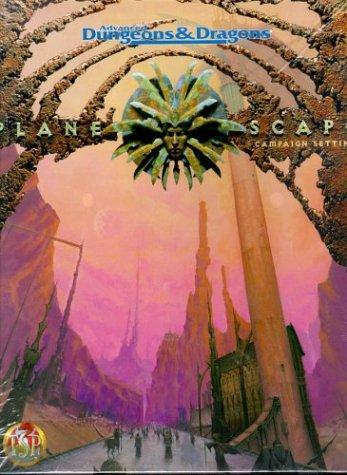
The Planescape Campaign Setting for 2nd Edition Advanced Dungeons & Dragons is debatably the most imaginative campaign settings produced by either TSR or Wizards of the Coast (I know Spelljammer fans will assert that their favorite setting wins that distinction, and I would honestly be thrilled to see a write-up on it as well). Planescape was set in the vast cosmology that had been built up over the years that linked all of TSR’s settings together - the aptly named Multiverse. The last time the Multiverse was covered was in the 1st Edition Manual of the Planes . Not only did Planescape update the information from that supplement, but it created a whole campaign setting that could be played from 1st level to 20th and beyond. This was remarkable in part because prior to Planescape, the Multiverse was essentially off limits to all but the highest level players thanks to a combination of deadly environments and being populated by some of the deadliest monsters in the game, to say nothing of the insanely powerful gods that called these realms their home. It is also one of the few settings of 2nd edition where the emphasis is most certainly not on killing baddies and looting their corpses, or even just on mere survival. The theme of Planescape, instead, is on the war of beliefs and philosophies in a setting where such things have the power to change reality itself!
So let’s begin by diving into the preliminary box set that introduces the campaign and its basic setup. The box contains a number of items - maps that show the layout of the Multiverse, including one specific to the the Outer Plane of the Outlands, as well as a map of the Planar metropoulos Sigil (more on that to come), a monstrous manual supplement, a guide book for Players and Dungeon Masters, and a basic setting book describing the city of Sigil and the Outlands, which are the logical starting-off point for low-level players.
The first book we’ll cover is the Player’s Guide to the Planes.

”Players Guide to the Planes” posted:
Welcome, addle-cove! Welcome to the worlds beyond your world, the great wheel of the cosmos. This is a great place! Where else can a poor sod mingle with mighty minions of the great powers, or sail the astral ocean, or visit the flaming courts of the City of Brass, or even battle fiends on their home turf? Hey, welcome to the lands of the living and the dead!
So, where to begin? Sigil, of course - there ain’t no other place worth beginning. Sigil: the City of Doors. This town’s the gateway to everything and everywhere that matters. Step through one door and enter the halls of Ysgard, or turn down a particular alley and discover the Abyss. There are more gateways in Sigil than can be imagined; with all those doors Sigil’s a useful place - and then some. Want to share a drink with a fiend, or maybe discuss philosophy with a deva? Here it can happen in the same day, the same afternoon, even at the same table - nothing’s too unlikely for Sigil. Strange folks abound here, and any one of them may prove ally or foe. Where else but in Sigil do humans, elves, dwarves, githzerai, bariaur, and tieflings form adventurinq companies? Where but in Sigil can “ a well-heeled cutter hire a githyanki ship or a legion of yugoloth mercs? This is the place to live . . . or die.
No surprise every basher out there wants Sigil! The Cage’d be a pearl for any tanar’ri prince or baatezu lord. ’Course, a few big shots have tried to storm the city, but Sigil’s not without her defenses. That birdcage’s got more ways to close her doors than folks know about. Then there’s the Mazes, nasty little places Sigil makes for would-be dictators. Those that get caught inside go barmy, poor berks - sometimes they scream so much a body can hardly stand it. But there’s a lot more out there than just Sigil. Get outside the city and there’s the planes themselves: the throne of the gods, the battleground of the eternal Blood War, and home to more horrors and wonders than ever existed on any prime world. There’s enough crusades, exploits, treasures, and mysteries to keep a band of adventurers busy for centuries to come (though why a body’d want to go to some of those places is beyond reasoning). Anyway, all it takes is the right door, so step right through!
Right away, we get bombarded with a slew of terms and phrases that on the initial read don’t quite make sense. Addle-cove? Cutter? Baatezu? Some of these are just the names of the denizens of the planes, but a lot of these phases are part of a unique dialect spoken on the planes that help makes Planescape stand apart from other settings. Will cover this dialect, called the "Cant", later in the review.
We begin with a definition of what a “Plane” is. A Plane is a world or collection of worlds that operate according to their own sets of laws. There are two variety of planes. Those that have a definite border are “demi-planes,” while those that are infinite in scope are known simply as “planes”. The exact number of planes is unknown, and planar travelers group the planes into three main categories: The Prime Material Planes, the Inner Planes, and the Outer Planes.
When traveling the Planes, there are three basic rules to remember:
-
The Center of the Multiverse
- Simply put, the Center of the Multiverse is whatever point you’re at currently. While some locations may seem better suited as being described as a “central point”, the truth is that you can show any point in the multiverse is the center and it’s impossible to prove that this assertion is incorrect. What this means practically is that there’s no place in the multiverse that’s more important or less important than any other (note that this is not the same thing as more
useful
.)
-
The Unity of Rings
- The Unity of Rings states that the most important structure in the multiverse is a loop or ring. The Inner Planes are laid out in a ring, as are the Outer Planes. The Outlands are structured in a ring fashion, and what is a sphere (the common shape of Prime Material Worlds) but layers of rings of increasing and decreasing size? Another aspect of the Unity of Rings is that it’s the way Powers (aka Gods) will think about things, so those who deal with them should beware of their circular logic.
-
The Rule of Three
- Shit in the Multiverse tends to come in groups of three. If you see two of something, it’s a good idea to look for a third. Note that this is just a tendency - you’ll find plenty of examples where this isn’t true. However, it’s a good rule of thumb to go by.
Structure of the Multiverse
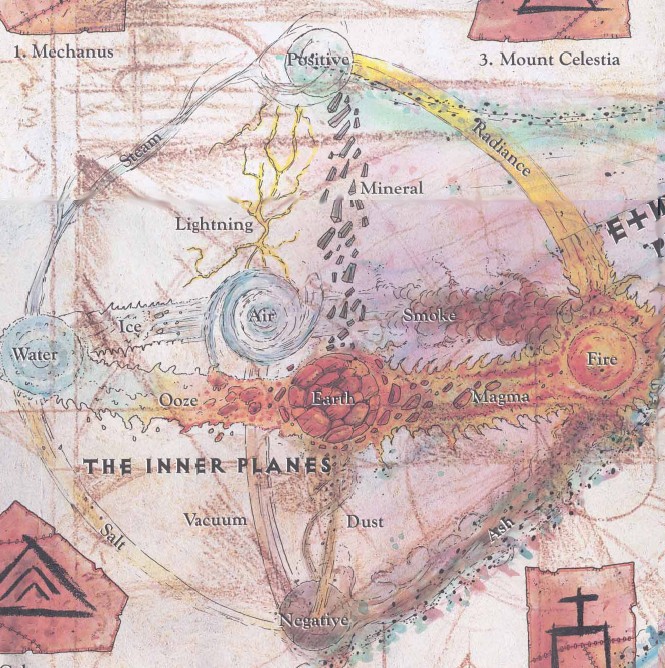
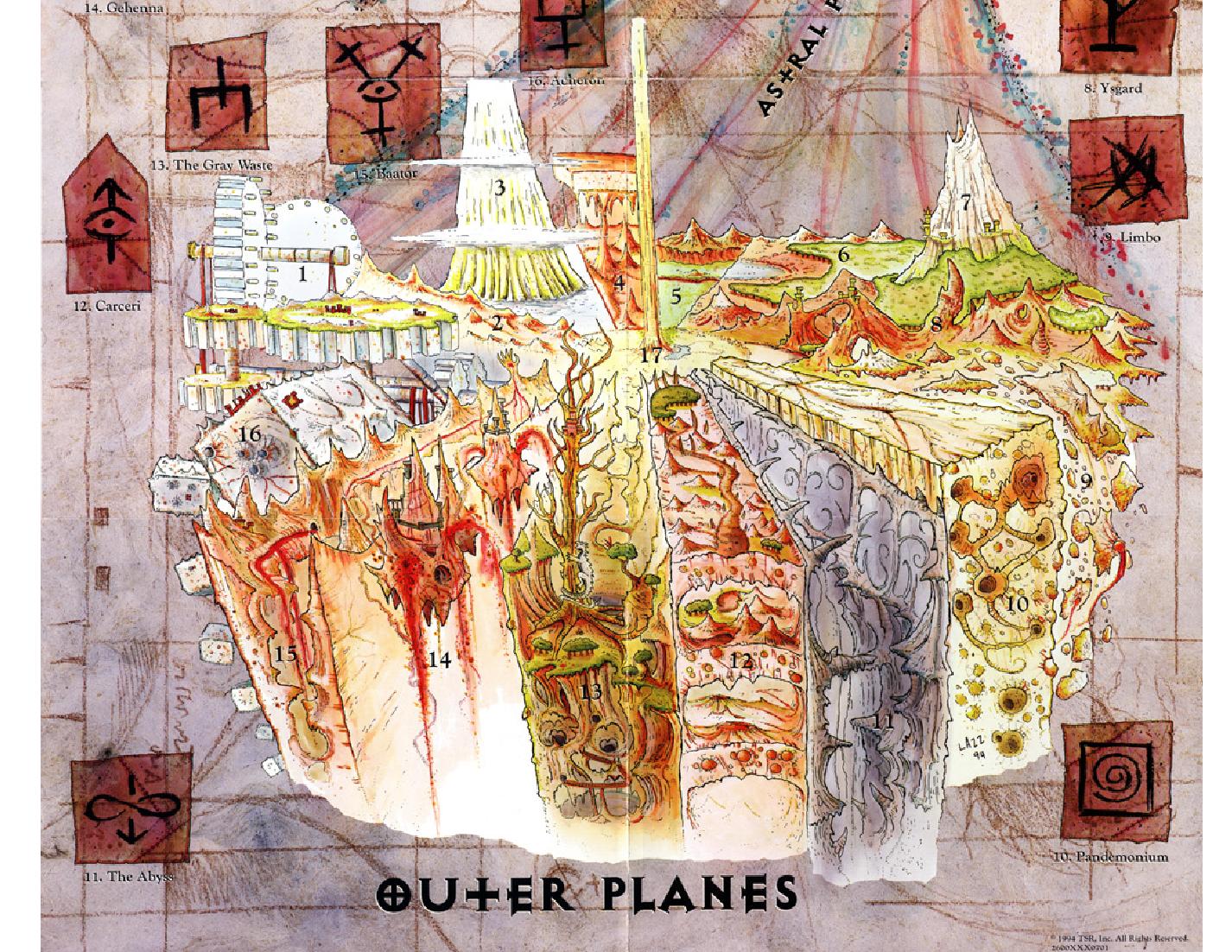
As mentioned earlier, the 3 main categories of Planes are the Prime Material, Inner, and Outer. The Prime Material Plane is physical world and where most of the mortal races are native too. This is where most of the D&D Campaign settings (Greyhawk, Forgotten Realms, Dragonlance) are located. It’s possible to travel between these worlds without using Planar travel...this is the basis of the Spelljammer campaign. To those who dwell on the Inner and Outer Planes, natives of the Prime are generally regarded as backwards hicks, or simply “clueless.”
The Inner Planes consist of the Elemental Planes - Air, Earth, Fire, and Water, - the Energy Planes - Positive, and Negative, - and the planes that connect them all to each other. Paraelemental Planes connect adjoining Elemental Planes, and the Quasielemental Planes connect the Elemental Planes to the Energy Planes. Each Plane is host to a range of native creatures, but provide a host of difficulties to anyone coming to visit. Certain sections are more friendly to non-natives than others, thanks to the efforts of the inhabitants or groups that have taken an interest in the place. Venturing beyond these points is a quick way to get killed.
The Outer Planes are the homes of the powers, deities that have taken interest in the affairs of mortals. The Outer Planes are the centerpiece of the Planescape Setting, as they deal the most frequently with the themes of belief and philosophy. You see, beliefs on the Outer Planes have the ability to alter the physical landscape. Get enough people acting in a certain way, and a piece of one Plane is going to shift into another.
There are 17 Outer Planes, arranged according to D&D’s infamous Alignment system. 9 Planes correspond to the 9 different alignments. The remaining 8 represent “in-between” alignments. Each Plane supposedly embodies the nature of each alignment, although this works out better in some cases than others (see: Beastlands).
16 of the 17 Planes lie along what is called “The Great Road”, a series of gates that connect each Plane to its neighbors. This makes it possible for a traveler to start in one of these Planes and, with proper knowledge of where each gate is, circumnavigate his way across all 16 Planes.
There are two ways of dividing up the Planes, either according to the good-evil axis, or the law-chaos axis. The good-aligned Planes are the Upper Planes, and the evil-aligned Planes are the Lower Planes, with the neutral Planes called the Boundary Planes. Alternatively, strongly-lawful Planes are the Planes of Law, while strongly-chaotic Planes are the Planes of Chaos, with the Planes in between called the Planes of Conflict.
In addition to the three main categories of Planes, there are two Planes that connect the Inner, Prime, and Outer Plane. The Etheral Plane connects the Prime Material Plane to the Inner Planes. This Plane is best described as a mist-filled ocean where pockets of reality loom out of nowhere. The Etheral Plane is home to numerous Demi-Planes created by wizards and others for their own use. The Ravenloft Setting is described as a unique Demi-Plane located within the Etheral Plane. Another interesting feature of the Etheral Plane is that the “Mazes” created by the Lady of Pain (the ruler of Sigil) are located in the Etheral Plane. “Vortexes” are shortcuts between the Prime and Inner Planes that allow natives of the Prime (as well as the Inner Plane) to shortcut the journey between the two Planes.
The Astral Plane connects the Prime Material Plane to the Outer Plane. The most common means of traveling the Astral is through spells and magic devices. Like Vortexes, Conduits and Color Pools allow for direct connection between the Prime and Outer Planes. Within the Astral Plane are the decaying corpses of ancient powers long dead. The most common inhabitant are the githyanki, who live in massive fortresses and travel in great ships. There are numerous other monsters that inhabit this realm, and most travellers do not linger long here.
Finally, special mention is given to the Outlands, the one Outer Plane not located on the Great Ring. The Outlands instead lies at the center of the Ring. In addition, travelling out from the center of the Outlands will take you closer to one of the other Outer Planes. As you travel, the land becomes more characteristic of the Plane you are traveling towards. At the boundary between the Planes are the Gate Towns, which are starkly similar to the Plane they link to. Indeed, there is a strong chance of these towns slipping over into the neighboring Plane, an outcome that the locals of these towns either desire or try to avoid, depending on their interests.
Sigil
At the center of the Outlands is a massive spire that stretches into the sky. Where it terminates, a great torus hovers above the Outlands. This is Sigil, the City of Doors. Sigil is a unique location in the Outer Planes. It cannot be entered or exited (well, with one exception for the truly crazy) save for the thousands of interdimensional portals that link Sigil to everywhere else in the Multiverse.
Within Sigil, knowledge of where portals are located and the secret to opening them is a valuable commodity. With the right portals, access to rare resources or potent allies is readily attainable. Alternatively, the right portal would allow you to circumvent the defenses of your enemies. One fact that must be remembered, though, is that control of the portals, and ultimately the city itself, rests with an enigmatic figure known only as The Lady of Pain.
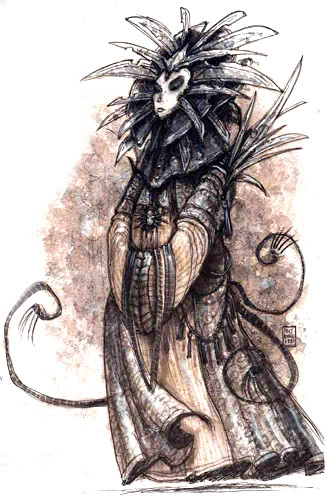
The Lady of Pain is the reason why Sigil has been relatively safe from the powers who inhabit the Planes. Little is known about her, save that crossing her is a really, really, really, bad idea. Thanks to her vigilance, Players can start a Planescape campaign at level 1 without worrying about being trampled to death by a pack of Pit Fiends.
Next Time: A Bariaur, a Githzerai, and a Tiefling walk into a bar...
Denizens of the Planes
Original SA post Planescape Campaign Setting Part 2 - Denizens of the PlanesThe residents of the Planescape setting can be divided into five groups: primes, planars, petitioners, proxies, and powers.
Primes are anyone who was born on the Prime Material Plane. Generally, planars will be cautious around primes. After all, the most common means of getting to the Planes from the Prime Material is through high-level magic. Nevertheless, pimes tend to lack basic common sense about surviving on the Planes. One advantage they have over planars is they aren’t affected by spells that effect planar creatures, such as Protection from x, Banishment, or even Summon Spells. Planars, even player character races, lack this benefit.
Planars are folks who were born in the Planes. Among these individuals are humans, half-elfs (specifically the union between a planar human and a prime elf), bariaur, githzerai, and tieflings. However, one can find representatives on virtually any prime race calling itself native to the Planes. Planars are able to sense gates and portals between the planes intuitively-they appear as an outline of a portal. Course, he still, may have to figure out what the key is, but simply finding the portal is half the difficulty. On the downside, all planars are subject to spells that bar passage, banish, or even summon planar entities.
Beside the mortal races, planars also include the fiendish races, angels, and other creatures that are native to the Inner and Outer Planes that are not petitioners or powers.
Petitioners are the departed spirits of both primes and planars. They make up the majority of the populace out on the planes. Typically, when someone dies, they lose most of their memories, only keeping a vague semblance of who they were in life. The goal of all petitioners is to achieve some sort of union with the powers of their planes. This is accomplished by behaving in a manner relevant to that power. Petitioners are reluctant to leave their home plane - death beyond their plane means they are destroyed utterly without achieving final union. Dieing on their home plane, on the other hand, leads to their merger with the plane, which still isn’t as good as union with a power. Generally, petitioners never advance beyond level 1, and are supposed to be the ‘general population’ of most places in the Outer Planes.
Proxies are special representatives of the powers, designated to carry out specific functions or serve as emissaries for the powers. Usually, they are transformed into a new form to carry out their duties, but this isn’t required. When a proxy isn’t transformed, he or she usually receives special powers to help carry out their mission. Player characters can never become proxies unless a power specifically makes them one. In normal circumstances, proxies are elite servants of the powers, and can either be powerful allies or dangerous foes.
Finally, we have the Powers , better known as gods. While some contend that they are not truly divine, it’s undeniable that Powers are immensely mighty entities. The majority of their attention is devoted to the Prime Material Plane, because that is where the bulk of their worshipers reside. Powers are dependant on worshippers to survive. If they lose their followers, they’ll eventually fall into the Astral Plane. Nevertheless, Powers are aware of the going-ons of the Outer Planes, and are on guard for power-jockeying by their fellow deities.
Creating Player Characters
There are three options for character creation when using the Planescape Campaign setting. First, the PCs can all be from the Prime Material Plane, in which case they select from the races, classes, and kits permitted in that particularly setting. Second, the PCs can be a mix of primes and planars, in which case all options for player creation are potentially available as long as they are permitted by the DM. Finally, a party consisting only of planars are limited to the races specified by the Planescape Players Guide, and the classes in the Players Handbook. In addition, all planar characters must belong to a Faction (more on that later.
Bariaur
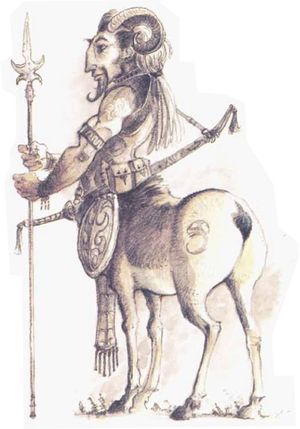
Bariaurs are centaur-like beings with a human-like torso and the body of a wild goat. Males are called rams and sport a pair of horns. Females are ewes and have no horns. Bariaurs are native to Ysgard, but can also be found in Arborea, Beastlands, and Elysium. Bariaurs are carefree and natural wanderers. There are no Bariaur towns, though they will go to cities if business brings them there. They mostly live a pastoral life herding sheep (although since they are herbivores, it somewhat limits the animals use). Bariaurs are described as being friendly and out-going, but not to the point of being over-trusting. They are fierce fighters and have a particular hatred of giants.
Bariaurs have infravision 60’ and a movement of 15. Player Bariaurs can be any non-evil alignment. Interestingly, Bariaurs are one of the few races that have sexual dimorphism reflected in their stats and class options. Bariaur males get +1 to Strength and Constituton, and -1 to Wisdom and Dexterity. They can use their horns as weapons, doing 1d8 damage plus strength. If they charge 30 feet in a straight line, they triple their damage, but must make a saving throw vs. breath weapon if the hit is successful or they suffer the same damage themselves. If their target is M size or smaller, there is a 50% chance they get knocked to the ground. Bariaur males can be fighters, rangers, paladins, or priests.
Bariaur females get +1 to Intelligence and Wisdom, and -1 to Strength and Dexterity. Their keen sense of hearing and smell give them +2 bonus on surprise rolls, and they receive a +3 bonus to saves vs spells. Bariaur females can become fighters, priests, or wizards.
Githzerai
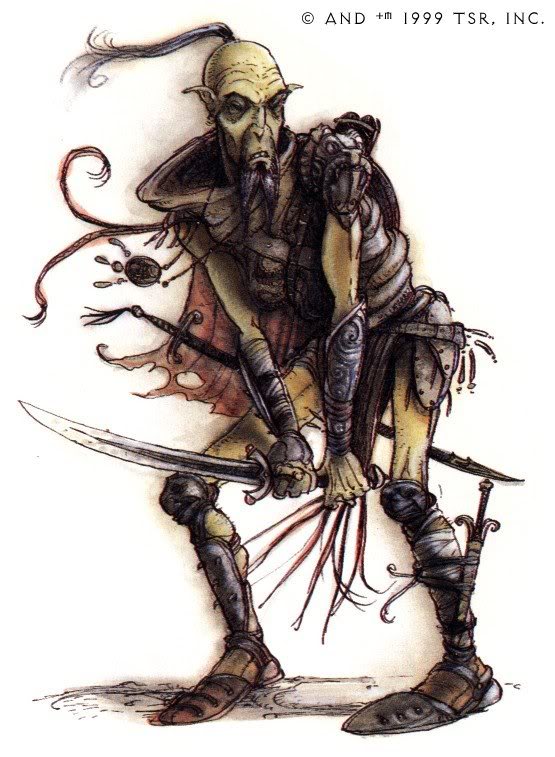
Githzerai inhabit the Plane of Limbo. Their history is complicated. They were once humans who were enslaved by the illithids. Eventually, they were liberated from the illithids thanks to a warrior named Gith. However, there was a schism following their liberation. One group now inhabits the Astral Planes, known as the Githyanki. The people known as the Githzerai followed a powerful wizard to Limbo. They despise both the Githyanki and illithids. Githzerai are folks of few words, and tend to be secretive and severe.
Githzerai get +1 to Intelligence and Dexterity, and -1 to Strength and Wisdom. Player characters can be any non-lawful alignment. The classes they can choose are fighter, fighter/wizard, wizard, and thief. Non wizard Githzerai have an innate magic resistance of 5% per level. Unfortunately, they cannot turn this off to receive beneficial spells. In addition, the first time a Githzerai uses or equips a magic item, he must make a magic resistance roll. If the roll ‘succeeds,’ then he can never use the item. Wizards do not have this limitation. Githzerai fighter/wizards can choose whether they have this resistance or not at character creation.
Tiefling

Tieflings are the result of a union between a human and something else. They have been fundamentally touched by the Planes, and it makes them very off-putting. Whether its something obvious like a set of horns or goats legs, or a hint of sulfur about them, there’s something not right about tieflings. Not surprisingly, few people are willing to trust them. In response, tieflings learn quickly that life is unfair, and fight back against those who are not on the short list of people they can truly call friends. Even these few are never really trusted. A tiefling learns that he or she must watch their own back.
Tieflings get +1 to Intelligence and Charisma, but -1 to Strength and Wisdom. Player character tieflings can be any alignment except lawful good. Tieflings have infravision ‘60 and can cast darkness, 15-foot radius once a day. Tiefliings only suffer half damage from cold attacks, and get +2 to saving throws vs fire, electricity, and poison. Tieflings can be fighters, rangers, wizards (including specialists), priest, thieves, or bards. Multiclass options include fighter/wizard, fighter/priest, fighter/thief, wizard/thief, and priest/thief.
Classes
Fighters and rangers tend to be viewed the same way as they are in most campaigns. Paladins provoke extreme reactions. Anyone who shares the paladins religious views sees them as holy warriors to be revered. Those that do not view them as sinister agents.
Wizards are not held with the same respect as they are in normal campaigns, because the Planes are highly magical themselves, and can severely fuck with a Wizard’s spellcasting if he’s not prepared.
Priests are viewed with caution, as planars will naturally assume they have a special connection with their deity (not necessarily true, but it never hurts to be cautious.) On the other hand, priests that are on planes corresponding to an opposing alignment will be favored targets for abuse from the locals. Long-lived priests learn to rely as much on their wits as their faith.
Thiefs tend to be viewed differently depending on the Plane. The Lower Planes respect thiefs for their guile, while the Upper Planes distrust them for the same reason. On the other hand, bards are more respected on the Upper Planes since their talents are going towards an art, while the Lower Planes tend to see bards as annoyances (unless they’re Dark Sun bards, in which case they are well regarded.)
Next TIme: The Factions-Grognards! Libertarians! Nazi-Paladins!
Factions of the Planes
Original SA post The Factions of the PlanesIn a setting that is literally shaped by belief, what philosophy a person holds is an essential part of their identity. This goes beyond mere alignment - its one’s sense of how the Multiverse is supposed to work. A philosophy will tell a planewalker who his friends and who his enemies are. On the Planes, philosophy is worth fighting over, and not just for simple bigotry (though there’s still plenty of that). By having more folks agree with your view of the multiverse, the more that view becomes correct.
Within Sigil, entire factions have been formed around commonly-held philosophies. These groups have lots of power and control the day-to-day going-ons of the city. All planar characters begin as a member of a faction. Prime characters don’t start in a faction, but can join any that they meet the requirements for. Faction membership is unrestricted by race and (for the most part) class. Most but not all have alignment restrictions. Naturally, you can only belong to one faction, and switching factions is looked down on generally.
There are 15 factions in Sigil. Most of them are led by a Factol . Advancement in a faction is not tied to character level. Instead, those who advance are usually members that advance their understanding of the faction’s beliefs and/or promote the faction’s interests. Membership in a factions provides a wide range of benefits, both general and specific. In general, factions can provide members with reliable information, employment, healing, and a place to crash for a night or two. Faction membership also has some drawbacks. Most generally, when you belong to a faction, all the friends and enemies of that faction are now your friends and enemies too.

The Athar (Defilers, the Lost)
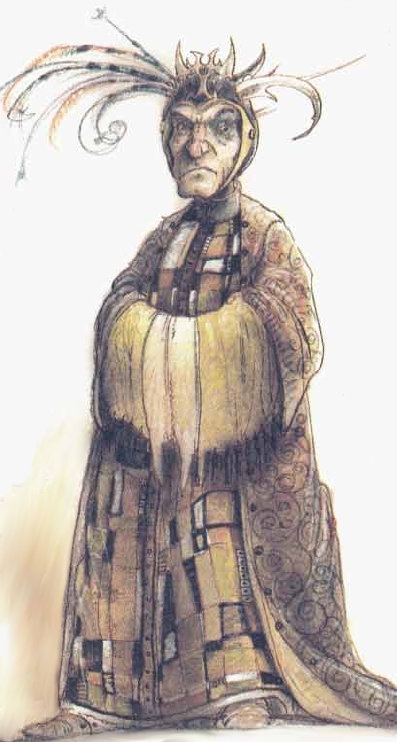
The Athar believe that the so-called ‘gods’ are frauds. They may be incredibly powerful, but most of the time they act like squabbling children, as prone to making dumb decisions as everyone else. The powers, as we know them, are unworthy of reverence. True divinity, if it exists, lies beyond understanding.
The Athar have a strong presence in the Astral Plane, where the corpses of fallen gods drift through the silvery void. Within Sigil, their headquarters is the Shattered Temple, which was once dedicated to the dead god Aoskar. They are sometimes allied with the Believers of the Source, as there is a lot of similarities between their beliefs. Not surprisingly, the Athar are pretty much enemies of every deity. Priests of specific gods cannot join the Athar, but General Clerics can join the Athar.
Followers of the Athar are immune to the spells abjure, augury, bestow curse, curse, divination, enthrall, exaction, holy word, and quest. Priests of specific deities will not provide members of the Athar with aid in the form of spells or magic items, especially healing.

Believers of the Source (Godsmen)
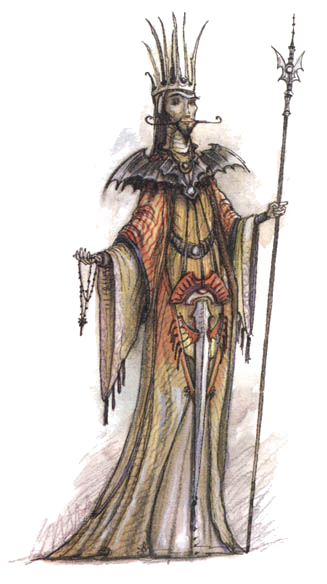
The Believers of the Source believe that all things are divine, and that all things in the Multiverse are striving to ascend to a greater glory. Everyone is being tested, even though the nature of the test is a mystery. If you are unable to achieve a higher level of existence in this life, then you at least try to be reincarnated into a higher form in the next. Even powers are trying to ascend to something greater. The Godsmen focus their efforts on discovering what will bring about the ascension of everyone in the Multiverse quicker.
The Believers of the Source are pretty prevalent on the Ethereal Plane. They see the wizard-made demiplanes as evidence that their theory is correct. In Sigil, they are headquartered at the Great Foundry. They count the Athar as strong allies, and they sometimes allied with the Doomguard (they both envision an end to the Multiverse. The Bleak Cabal and the Dustman are opposed to the Godsmen.
The Believers of the Source have no membership restrictions, although Priests of specific deities suffer a -1 penalty to all saving throws. Godsmen are generally well liked, and get a +2 (or +10%) bonus to encounter reactions with planar beings. Godsmen cannot be raised or resurrected by any means. However, they can be automatically reincarnated as a player character race of the DM’s choosing.

The Bleak Cabal (Bleakers, the Cabal, Madmen)
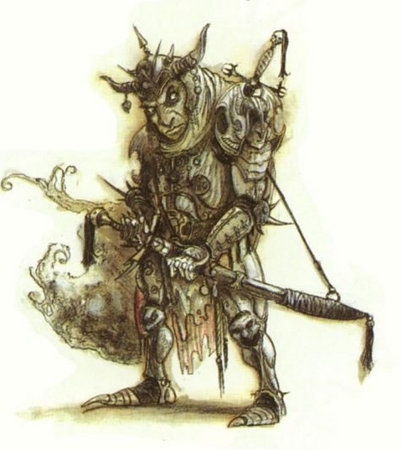
The Bleak Cabal believes that the Multiverse simply does not make sense. They also believe that attempting to ascribe sense to the Multiverse is only going to drive himself crazy. Of course, sometimes they go crazy from ascribing to the Bleaker philosophy, but from a Bleaker standpoint, that’s not a knock against them. While Bleakers don’t believe there is anything to gain from seeking sense or meaning in the Multiverse, they do see value in finding meaning within.
The Bleak Cabal has a large presence on Pandemonium, the Plane of Madness, the Howling Land. While Bleakers would never say the location makes sense, they will admit that it’s a fitting home. In Sigil, their base of operations is The Gatehouse, a great asylum in the hive. The Bleakers are well liked by the Doomguard, the Dustmen, the Revolutionary League, and the Xaositects, and are enemies of the Fraternity of Order, the Harmonium, and the Mercy-Killers.
Membership to the Bleak Cabal is restricted to non-lawful alignments. Bleakers are immune to spells that cause madness or insanity. They also get a saving throw vs. spells against ESP spells. Bleakers are prone to fits of deep melancholy. At the start of each day, a Bleaker player rolls 1d20. On a 20, they are overcome with the futility of their beliefs, and won’t do anything unless philosophically convinced it is worth doing. Note that another party member getting eaten is not a sufficient reason.

The Doomguard

The Doomguard believe that decay and entropy are the natural state of things. This is not something that should be resisted, but accepted. The Doomguard make it their job to make sure that this decay happens at the proper pace. Of course, what the proper pace should be is a matter of some debate within the Doomguard. Most agree that building stuff that’ meant to wreck something else is a positive contribution towards entropy.
The Doomguard maintain fortresses within each of the negative Quasi-elemental planes, right on the border where it becomes the Negative Elemental Plane itself. Within Sigil, the Doomguard control the armoury. The Doomguard are natural allies of the Dustmen and the Bleak Cabal. They also find common cause with the Believers of the Source, though their definition of what the ‘end’ actually is differs. The Doomguard are disliked by the Fraternity of Order and really disliked by the Harmonium.
The Doomguard is open to everyone except priests with access to the spheres of healing and creation. All members of the Doomguard are proficient with a sword, and gain a +1 attack bonus while using one. Any class restricted from using swords has that restriction lifted. A Doomguard must fail a saving throw vs. spells in order to benefit from spells or magic items that cure or heal wounds.

The Dustmen (The Dead)
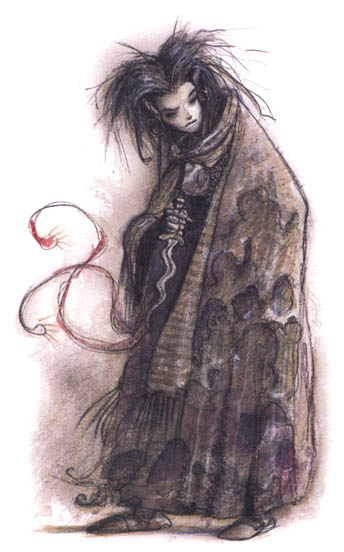
The Dustmen believe that everyone in the Multiverse is dead. Some more than others. Their attitude is best summed up as
 . They believe that the goal of everything is to become one of the undead, what they call the True Dead. They discourage rushing off towards death or committing suicide, because you
have
to get through the miserable shit first. So not only are they
. They believe that the goal of everything is to become one of the undead, what they call the True Dead. They discourage rushing off towards death or committing suicide, because you
have
to get through the miserable shit first. So not only are they
 , they’re elitist snob
, they’re elitist snob
 .
.
Dustmen have a fortress on the Negative Energy Plane, which is a perfect place to be
 , not to mention home to lots of undead to talk to. In Sigil, they run the Mortuary. They are strong allies with the Bleak Cabal and the Doomguard. They also share common ground with the Fated due to their deterministic outlook. On the other hand, they are strongly opposed by the Society of Sensation. Dustmen also tend to be very off-putting towards primes.
, not to mention home to lots of undead to talk to. In Sigil, they run the Mortuary. They are strong allies with the Bleak Cabal and the Doomguard. They also share common ground with the Fated due to their deterministic outlook. On the other hand, they are strongly opposed by the Society of Sensation. Dustmen also tend to be very off-putting towards primes.
There are no eligibility restrictions to becoming a Dustman. Priests of death gods are particularly welcome. The Dustmen have a pack with the undead called The Dead Truce. The undead will not attack Dustmen unless he or she attacks them first or provides aid to someone the undead are attacking (the Truce does not extend to non-Dustmen allies). A Dustman chance of resurrection survival is reduced by half.

The Fated (Heartless, the Takers)
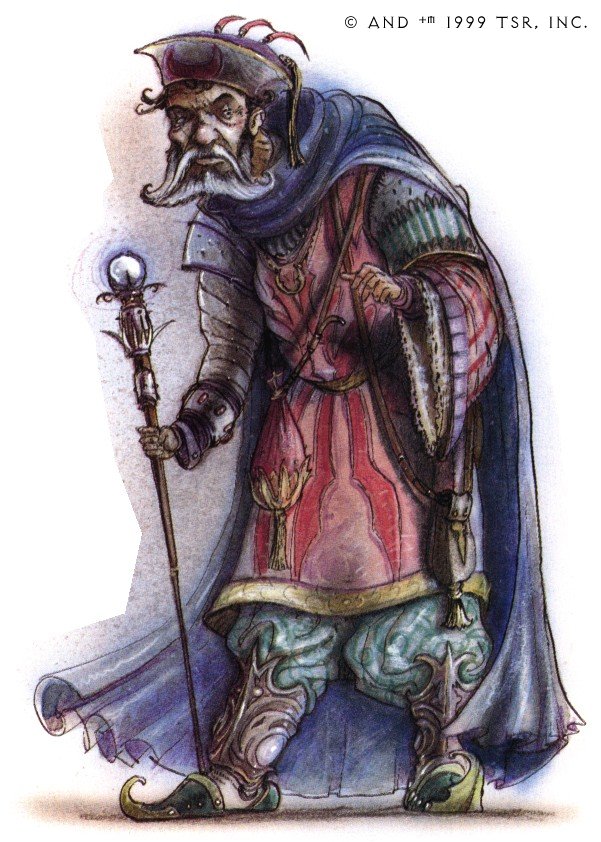
The Fated believe that the Multiverse belongs to those who can take it. One has to look out for themselves, and only has themselves to blame for their misfortune. It’s easy to assume that they’re a bunch of objectivist assholes, and indeed some members are, but the one thing Takers hate more than handouts are whiners that cry about how ‘unfair’ everything is, including those that claim to ‘share’ their viewpoint. To the Fated, things like ‘love’ and ‘compassion’ exists, but such things must be earned, even things that cannot be taken by force or bought.
The Fated are probably my favorite faction because they work on so many levels. A Fated can either be played as self-reliant go-getter or as a hilarious libertarian parody, and not only are both portrayals correct, but both can exist alongside each other in the same campaign. Although all the factions have degrees of this, the Fated are the most obvious in this dual nature.
The Fated have a big presence on Ysgard, given that they readily identify with the attitudes of the Norse gods. In Sigil, they control the House of Records, which is responsible for deeds of ownership and taxation. The Takers are pretty friendly with The Free League. They are somewhat cool allies with the Mercy Killers, who agree with them on some points and disagree on others. They are enemies of the Harmonium (notice a pattern?)
Lawful Good characters are unable to join the Fated. The Fated start with twice the number of proficiency slots, and all proficiency restrictions are removed. The Fated cannot perform or accept charity in any capacity. Everything they receive must be paid for in some fashion, and the service must be provided before the payment is given.

The Fraternity of Order (Guvners)
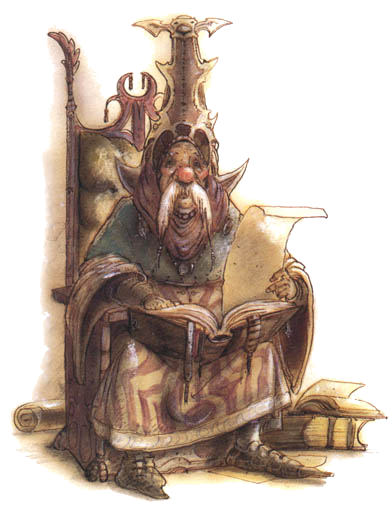
The Fraternity of Order believes that there are laws for everything in the Multiverse. They believe that the key to understanding the Multiverse is to understand the laws that govern it. Once they understand the laws, then they can exploit them, use the loopholes to gain incredible power. The only goal worth pursuing, according to the Guvners, is to learn all the laws. To do that, Guvners seek to learn as much as they can about the Multiverse.
The Fraternity of Order has a large presence in Mechanus, a clockwork universe where it is plainly obvious that everything is governed by orderly laws (well, most of the time at least). Within Sigil, the Guvners are headquartered in the City Courts. They are strong allies with the Harmonium and the Mercykillers, and the three factions more or less run the judicial system in Sigil. They are strongly opposed by the Xaositects and the Revolutionary League, while the Doomguard are suspicious the Guvners are seeking to prolong the existence of the Multiverse.
Only characters with lawful alignments can join The Fraternity of Order. Guvners can automatically comprehend languages once per day. At level 7, Guvners gain the ability to use item once a day regardless of class. This effect lasts 24 hours. A Guvner can never break the law unless he or she can find a legalistic loophole to avoid the penalty.

The Free League (Indeps)
The Free League believes that no one in the multiverse has the ‘right’ answer, least of all them or any of the factions bumbling about. Indeps believe that attaching oneself to a particular philosophy someone handed to you is foolish. Instead, you have to come up with your own answer, one that is right for you, and not one that someone else came up with. Not surprisingly, the easiest way to troll an indep is to call the Free League a Faction.
The Free League has a strong power base in the Outlands, where they serve as merchants between the many communities. Within Sigil, their center of power is the Grand Bazaar. Given their diverse collection of viewpoints, the Free League don’t have any strong allies, though the Fated respect their independent streak. On the other hand, the Harmonium are pretty strongly opposed to the Free League.
Naturally, the Free League is open to anyone. Indeps get a +2 bonus to all saves vs. charms, no matter the source. Against charms that don’t normally allow a save, Indeps are allowed to roll a save to resist (though without the bonus). Because the Free League doesn’t organize itself as a faction, it has no factol, so it has no representative in city business. This has led to the Free League without any protected rights.

The Harmonium (The Hardheads)
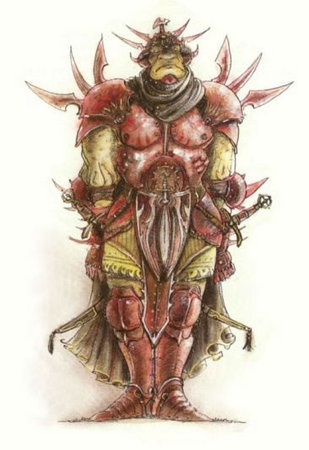
The Harmonium’s philosophy is quite simple: The Harmonium is always right. It goes to follow that the Multiverse would be a much better place is everyone just did what the Harmonium tells them to. And the Harmonium is not shy about using a few well-placed blows to the head to achieve their aims. Their Factol sums this attitude up best:
”Factol Sarim of the Harmonium” posted:
Do it our way or no way. Understand that, berk?
Ladies and gentlemen, your pink, nazi-paladins!
The Harmonium has a major foothold on the Plane of Arcadia, the Plane of Harmonius Good (just how big a foothold, well, we’ll get to that). In Sigil, their headquarters is the City Barracks. They are pretty much the city police, though how far that distinction will get them depends on the neighborhood The Harmonium are in a tight alliance with the Fraternity of Order and the Mercy-Killers. The Harmonium is at odds with, well, pretty much every other factions (though some are more reciprocal in their hostility than others, such as Doomguard, the Xaositects, and the Revolutionary League).
Characters that want to join the Harmonium must have a lawful alignment. Hardheads can use charm person once per day. Any hardhead that breaks or varies from an order from the Harmonium must atone (as per the atonement spell) before being allowed to return to the ranks of the faction. Members who betray the Harmonium or “turn stag” are sentenced to death by the Factol.
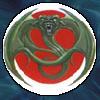
The Mercykillers (Red Death
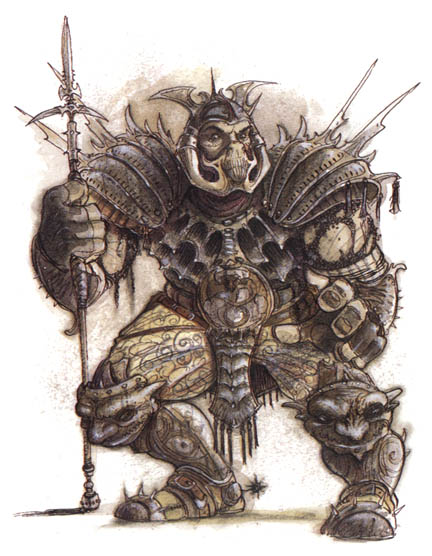
To the Mercykillers, justice is the most important thing in the Multiverse. They make it their mission to see to it that everyone who breaks the law is brought to justice and pays the punishment due to them, no exceptions. In addition, Mercykillers believe that their pursuit of justice grants them exemption from the very laws they seek to punish others for. Mercykillers see no hypocrisy in this, and anyone trying to point it out is obviously a weak-kneed liberal who only encourages law-breakers.
The Mercykillers maintain a fortress in Acheron. They also run the City Prison and are responsible for carrying out the sentences of the courts. The police-court-prison partnership forms the core of the alliance between the Harmonium, Fraternity of Order, and the Mercykillers. The Mercykillers are heavily opposed by the Revolutionary League, the Sign of One, and the Society of Sensation.
Only lawful characters are permitted to join the Mercykillers. Thieves and known criminals are unwelcome. Mercykillers can detect lie to a single question once per day. Mercykillers consider themselves innocent of any crime they commit while in the course of punishing a known criminal. They are subject to the full punishment of the law for crimes committed for any other reason. A Mercykiller can never release a criminal until the proper sentence has been carried out.

The Revolutionary League (Anarchists)
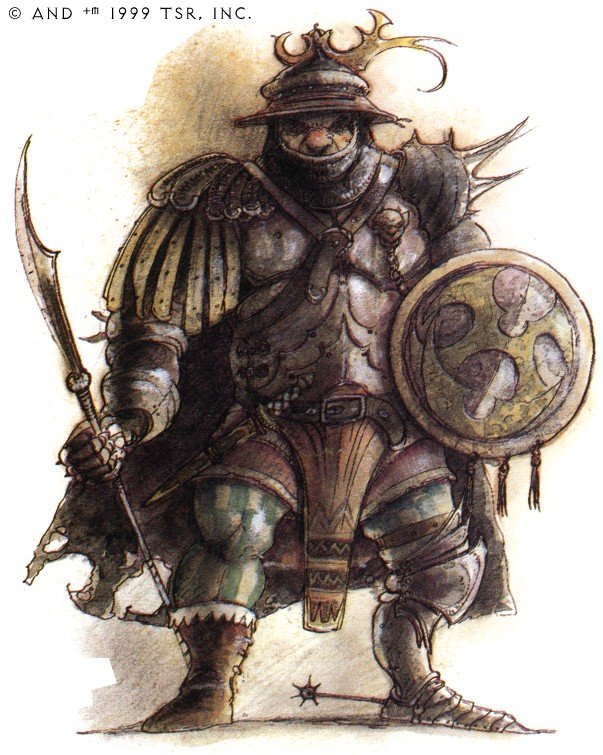
The Revolutionary League believes that every organization, every powerful figure in the Multiverse is corrupt and solely interested in power and material gain. Things like “the truth” or “looking out for the common good” are of no concern to them (if it ever was!). The Anarchists believe that they have to tear down the existing power structure in order for there to be any chance of finding the truth.
The Revolutionary League loves to hang out on Carceri, the Plane of Exiles. The Anarchists do not have a fixed headquarters, instead operating through decentralized cells. They also have no factol. Anarchists find common cause with the Doomguard and the Xaositects, while the Harmonium and the Guvners heavily oppose them.
Membership in the Revolutionary League is barred to characters with the Lawful alignment. Archarasts have the ability to pose as a member of any other faction, although they do not gain the faction’s special ability. Anarchists can never hold any public office, noble title, or own a business or anything that would tie them to the power structure of the Planes. They must donate 90% of all treasure gained to their cause or to the oppressed. This can never be given to another player.

The Sign of One (Signers)
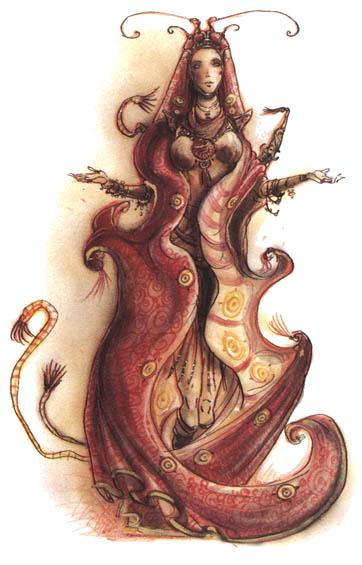
The Sign of One believes that the Multiverse is centered around the self. Or more specifically, the members of the Sign of One. The existence of the Multiverse is dependent on each and every signer-or as many of them argue, one specific signer (namely themselves). Any sense of individuality you may have? Well, Mr. Signer made you think it. If they so desired, they can make you disappear, so best be nice! This is definitely the
 est of factions.
est of factions.
The Sign of One likes to hang out in the Beastlands. Their headquarters is located in the Hall of Speakers. Signers are natural allies of the Society of Sensation, and they are favored by outsiders fresh from the primes. The Harmonium finds them annoying, while the Bleak Cabal is heavily opposed to them.
Membership is open to everyone, though Lawful Good and Lawful Neutral characters have trouble adhering to the beliefs of the faction. Signers automatically gain a saving throw vs. spell against illusionary magic. Due to their massive egos, Signers get a -2 penalty to all encounter reactions and loyalty tests of non-player characters.

The Society of Sensation (The Sensates)
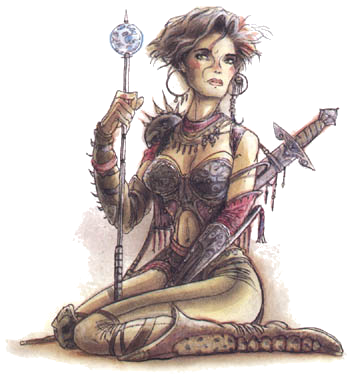
The Society of Sensation believes that experience is the only way of learning the secrets of the Multiverse. And not that kind of experience, berk! They mean seeing the sights, hearing the sounds, tasting the food. So if you want to learn the Truth with regards to existence, the only way to do so is to go out there and experience everything . As to how this is at all possible given the scope of the Multiverse, well...according to the sensates, if you haven’t sensed it, it may as well not exist, so forget about it!

Not surprisingly, the Sensates love to hang out in Arborea, home to the Elven and Greek pantheons. Their headquarters in Sigil is the Civic Festhall. The Society of Sensation are strongly allied with the Sign of One. They also get along well with the Free League and the Fraternity of Order, as they are a great source of information about far-away places. The Sensates are opposed to the Doomguard.
The Society of Sensation are the least restrictive faction with regard to membership, with no barred races, classes, or alignments. All Sensates gain infravision, 60 feet, as well as a +1 saving throw against poison and die rolls for surprise. Sensates cannot refuse an opportunity to experience something new, unless it is obviously deadly.

The Transcendent Order (Ciphers)
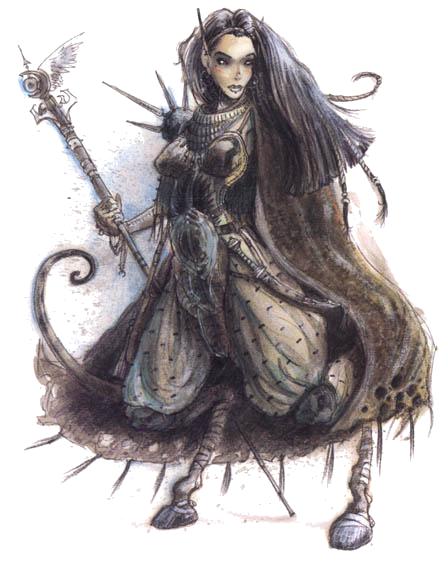
hmm...that picture seems a little too static...

Better!
The Transcendent Order believes that in order to understand the Multiverse, one has to stop thinking and act. That’s not the same thing as acting impulsively. Your own body already knows what it needs to do, and if you work hard enough at it, you can know how to read the signals your body is sending you. Your mind and body act as a cohesive unit. By becoming in tune with your body, you become in tune with the Multiverse.
The Transcendent Order has a large presence in Elysium, which they find well suited for meditation. Ciphers don’t have any friends or enemies given their introverted nature, although the Harmonium is suspicious of them.
The Transcendent Order is open to anyone with a Neutral Alignment (either partial or total). Ciphers gain +1 to their initiative roll. Players of Ciphers are bound to a ‘no take-back’ rule. The first action they state is the one their character performs. Players that debate a course of action are acting against their factions philosophy.
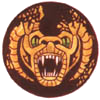
The Xaositects (The Chaosmen)
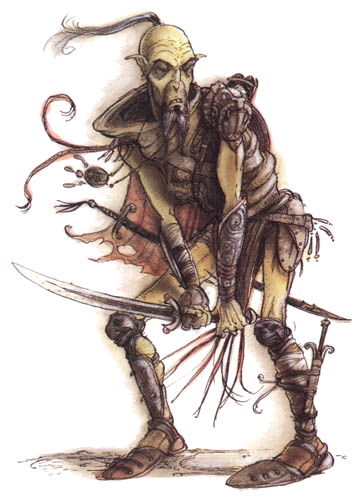
The Xaositects (kay-Oh-si-tekts) believe that the Multiverse’s natural state is Chaos. There is no pattern save those imposed by idiots too scared to accept the nature of existence. Once those idiots are gone, Chaos returns. So the smart thing to do is to embrace chaos, appreciate randomness and the sublime intricacies of disorder. That’s how one discovers the nature of the Multiverse.
As you might guess, the Xaositects is the “Fishmalk” faction of the setting. DM discretion advised.
The Chaosmen naturally are quite at home in Limbo. Their headquarters in Sigil is a turbulent slum called the Hive. The Xaositects work pretty well with the Doomguard and the Bleak Cabal. Not surprisingly, the Guvners and the Harmonium hate the Chaosmen.
Not surprisingly, only chaotically-aligned characters can join the Xaositects. Chaosmen can use babble once per week. Chaosmen can never found businesses, build strongholds, raise armies, or undertake any other action that requires long-term organization or discipline. They are barely cohesive as a faction to begin with (though they do have a Factol, believe it or not.)
Finally, there are the Outsiders, or just the Clueless. Fresh off the primes, they can’t tell their ass from their nose to begin with. It’s not surprising that many join a faction simply to help get their bearings.. Most factions regard them with pity and/or as rubes. One advantage they possess is their lack of allegiances make them ideal for mercenary work.
Next Time: The GM’s Guide-Magic and Travel on the Planes
DM Guide to the Planes - Introduction, Spells, and Travel
Original SA post DM’s Guide to the Planes - Introduction, Spells, and Travel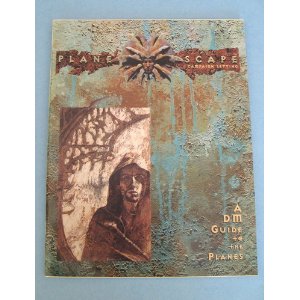
Apologies for the shitty picture.
The DM’s guide opens with a description of what’s inside the Campaign Setting Box and a few words about running a Planescape Campaign, some more interesting than others. But first, lets have some more sweet, sweet artwork:
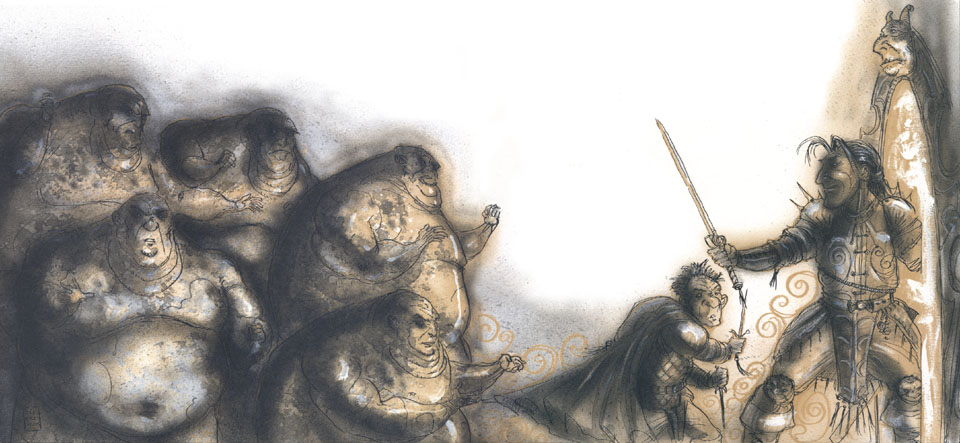
One of the first things covered is how to deal with the ‘scope’ of Planescape setting. In terms of the sheer quantity of “interesting or potentially stuff” within it, Planescape is probably one of the largest fictional settings (if not the largest) ever developed. Fortunately, there are enough mechanics in place for dealing with such a massive scope. The central mechanic is Sigil, the presumed hub of any campaign. There is no theoretical limit to where a gate can take you. Indeed, the guide makes a particular note that Planescape should never be about the difficulty of getting to a desired location, but what you do once at your destination.
Another point that’s covered is conveying the tone of the game. Again, the central role of ideas and philosophy is brought up and elaborated on-the importance of living out one’s beliefs, not just the academic debate of their merits. Some other points are brought up that are just as important. Because they live in close proximity to Gods, fiends, and numerous other extra-planar tough guys, your average planar has a better survival instinct than your typical NPC goober. But at the same time, these potentially deadly figures are also their neighbors . There is nothing unusual in this setting about sharing a drink with a deva, talking local gossip with a Tanar’ri general or getting advice on places to crash from a slaad.
Both facts come together to breed a kind of cynical worldliness in the inhabitants of the setting. There isn’t a lot of expectation for sympathy, and there isn’t much to be found either. There are few things that planars will consider to be truly special. Least of all the players.
To help emphasize this point, each Planescape book is filled with quotes from the inhabitants of Planescape to hammer in this tone. It’s surprising in how effective this is-after reading through the material, a player will have a good jist of how to talk like a blood in no time.
As an example, here’s a nice quote from one of the fine residents of the Planes:
”A Resident of Pandemonium” posted:
I ain’t barmy! Don’t ever call me barmy or I’ll nick you - got that!
Magic on the Planes
There are a lot of rules regarding magic, but I think this picture sums them up nicely:
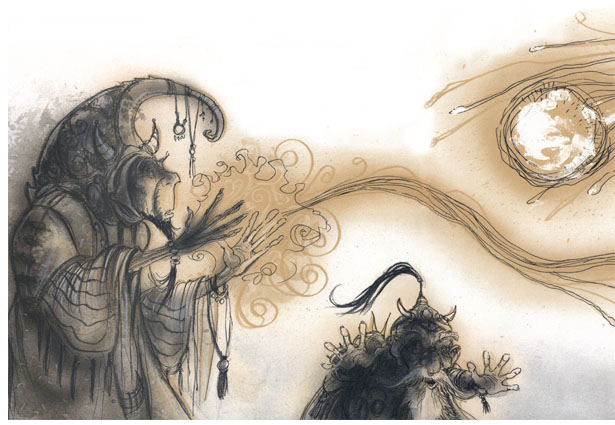
ffffffff.....
2nd Edition doesn’t have the same degree of Wizard Supremacy problems that 3.X had. In Planescape, though, there are a whole range of issues that spell-slingers have to deal with.
First, abjuration spells such as banishment are only effective on planar beings not on their native planes. Consequently, casting it on, say, a Pit Fiend while on Baator will at most elicit a laugh from said Pit Fiend as he smashes your head in. On the opposite end, spells that summon critters can only call creatures that are native to that particular plane. So it’s impossible to summon, say, a succubus to Ysgard.
The second major consideration is that there are a whole list of spells that depend on having a connection to the Inner or Outer Planes via the Ethereal or Astral Planes, respectively. Because the Prime Material Plane is connected to both, a prime is not going to realize this requirement until he steps out onto the Planes. Spells that require a connection to the Astral Plane will not work on either the Ethereal Plane or the Inner Planes, and spells that require a connection to the Ethereal Plane will not work on the Astral Plane or the Outer Planes. If a spell utilizes either the Astral or Ethereal, such as contact other plane, then the spell caster is limited to using the connection available to them. One major exception to this rule is that spells cast by priests are not affected by this limitation (more on that later), though the same spell cast from a scroll or magic item is.
In addition, there are a number of spells that create and use extra-dimensional spaces, such as rope trick. These spells do nothing on the Astral Plane or on specific demi-planes that don’t allow for extra-dimensional spaces.
Finally, each Plane (and sometimes specific layers of Planes) have their own list of restrictions and alterations depending on the school the spell is cast from, whether or not it was cast from wild magic, and what element it’s associated with. In some cases, a spell category is actually enhanced, and are considered to have been cast at one level higher than the caster’s level. Saving throw against such spells have a -1 penalty. In other cases, the spell category is diminished (cast as if one level lower and spells higher than 4th level can’t be cast) or even nullified. Most alterations are specific to that Plane, and so lumped in the general category of “altered.”

Now, there is a way to circumvent this mess for non-priest spellcasters, and that is through spell keys. These allow a spell caster to use a specific spell or category of spells (a general key) as they do normally, though in general a spell key will add 1 to the initiative of any spell cast. The nature of the spell key depends on what Plane it’s for. Planar spell-casters are generally aware of spell keys (even if they don’t know the actual keys themselves), but it’s something a prime will only learn about through inquiry. Note that a spell key that overrides the need for an ethereal connection is actually drawing on the substance of the Plane he is currently on, and the resulting conjure can be quite different from what is ‘normally’ summoned. Also, in some cases the spell key needed to cast a spell normally just does not exist-you’ll never find a spell key to cast fireball on the Plane of Water, for example.
Priests have a different set of issues to deal with. Spells cast by priests are never limited by the lack of proper connection. If a priest is on the Inner Planes and his power is on the Outer Planes, he can cast spells that need astral connections just fine.
The issue that priests have to deal with is that travelling the Planes usually means he’s walking into enemy territory, so to speak. To prevent an all out war that would cripple the ability of powers from maintaining their faith, a sort of agreement has been established. The first part is that powers don’t send legions of faithful into their rivals territories. More important for the players, when a priest character is on an Outer Plane other than the one his deity resides in, he functions as if he were one experience level lower for every plane between himself and his deities’ home plane, with regard to spellcasting. For the most part, only the Planes on the Great Wheel are considered-a priest-deity connection cannot cut through the Outlands or Astral Plane. This spell lost is instantaneous and temporary-as soon as a Priest returns to a Plane where a given spell level will operate, he gets those spells back.
If a priest’s deity resides on the Inner Planes, then a priest loses three effectives levels while on the Outer Planes, and vice versa. Naturally, these restrictions don’t apply to priests on the Prime Material. They also don’t affect priests in Sigil.
There are two workarounds a Priest can use. First is priest scrolls-they aren’t affected by the usual priestly limitations (though they can be affected by planar connection limitations). The second is through power keys, which not only allow normal access to spells, but can even enhance them. Power keys are very rare because they are created by the powers themselves, and powers can change them as they wish. They tend to be tightly controlled-a power key that gets spread to too many cutters tends to stop working. Some think this is because power keys cost a tiny portion of a deity’s might. One risk that should be noted is that evil powers love spreading rumors about false keys, so a cutter would be wise to check the source of the key he’s using before utilizing it.
Finally, non-artifact magical items are affected by the Outer Planes. How they are affected depends on what category of magic item they belong to. Of special interest are magical armor and weapons. For every Plane away from the one it was created on, it loses 1 point of bonus. So a +2 sword made on the Prime becomes a +1 sword on the Astral or ethereal, and provides no magical benefit on the Inner or Outer Plane (though it will still register with a detect magic spell). When a magic armor is at +0, it’s effectively inert and provides no additional benefits. The point at which it becomes inert is the highest bonus it provides. Note that cursed weapons and armor do not go inert when taken off the plane they were made. Unlike priest spells, when calculating the distance between specific Outer Planes, the Outlands and the Astral Plane can be used to calculate the distance from which Plane it was made on. The same applies to the Inner Planes, which are connected via the Ethereal Plane. Conduits, vortices, and color pools do not reduce the separation between Planes.
Fortunately, there are only a limited number of locations where magic items are likely to be made, as most Powers aren’t keen about folks making magic weapons and armor on their home turf. Sigil is a pretty common location for arms-crafters, though it can be pretty pricey. The big advantage of Sigil-made magic weapons and armor is that they lose only +1 on the Planes of the Great Ring. The Prime Material Plane is also a common source for magic items. While they suffer a -2 reduction on the Outer Planes, they have the advantage of being able to operate just as effectively on either the Outer or Inner Planes.
”Hortaz of the Bleak Cabal” posted:
We’re marooned in Baator, you’ve lost the gate key, a dozen pit fiends are headed this way, the paladin is down and may be dead, and your power key is a fake - so what?
Players and DM should both keep track of where a magic weapon or piece of armor comes from, although it’s usually easy to tell as the weapon will look visibly different depending on its origin. When introducing a magic weapon, the DM should either set its home plane as the one it was found in or from Sigil, unless there is a plot-specific reason for the weapon to have originated from a specific plane.
Travel on the Planes - Insert Portal Joke Here
As said before, the sheer size of the Planes can make getting around to be an incredible hassle. No one wants to walk all the way from Gehenna to Acheron, even if survival wasn’t an issue. Fortunately, there are tons of shortcuts a planar can use, and he doesn’t even need a spellcaster to use them. Many of these means are under the DM’s control - players in Sigil can’t force a portal to a particular place to appear where they want it. To Planescape’s credit, it does warn the DM against using this control to railroad the players into doing exactly what he wants them to do, and advises a DM to listen for cues as to where players want to go and work out how they’re going to get there.
The two most common means by which primes get to the planes is through either plane shift or astral spell , each having their own advantages or disadvantages. These are high level spells, though, and usually are viable for introducing low-level primes to the Planes. There are also a number of items that can provide access to the Planes as well, although these carry their own set of problems.
Fortunately, there are ways for which anyone can get from the Prime Material Plane to the rest of the Multiverse. Elemental Vortices connect a Prime Material World to a specific Inner Plane. They are most commonly found in places with high concentrations of the corresponding element. the mouth of a vortex will appear as a shimmering pool or wall of elemental stuff. Vortices can link to any of the Elemental, Paraelemental, or Quasielemental planes, but there are no known vortices that hook up to the Positive or Negative Energy Planes.
Astral Conduits connect a Prime Material World to a specific Outer Plane. On the Astral Plane, conduits appear to be giant silver arteries. Conduits are largely stable, and can either be one-way (a young conduit) or two-way (a mature conduit). Conduits from the Prime Material can only take you to the first layer of an Outer Plane, though there are also conduits that hook two layers of the same Outer Plane together. Certain layers (specifically the 7th layer of Mount Celestia and the 9th layer of Baator) cannot be reached by any conduit. Conduits tend to drop its users out in the middle of nowhere. Conduit opening are invisible to normal sight, but appear as a reflective haze when using the true sight spell. Since their end points are stable, there is a brisk trade in maps of conduits, although a cutter should always be care about getting ripped off.
One form of Planar travel that a Planescape Campaign is going to frequently deal with are portals. Portals are the doorways to and from Sigil, and they have the advantage of being able to connect potentially anywhere. It also directly links two points, and at least one end is not going to be environmentally deadly (most of the time). On the other hand, portals don’t advertise themselves-they don’t register as magical or glow with strange colors, and you can’t tell what’s on the other side before stepping through. Finally, a portal needs a specific key to activate. This key can be anything - a word, an action, a thought, or an object carried over the threshold. This causes the portal to flash with a brief flare of light - if a berk is watching he might get a brief glimpse of the destination - and there is a crackle of electricity as someone passes through it.
Portals can be permanent, temporary, and possibly shift around in a pattern or at random. Portals always ground their ends in some kind of arch or enclosed space. Out on the Planes, this might be anything, such as a palace door or even a canopy of leaves. No one is entirely sure how portals come into being, but for most planars, it doesn’t matter. All that matters is that they work.
There is also what is known as The Great Road. The Great Road is actually a series of permanent gates that link each Plane on the Great Ring to its neighbors. Each gate is located within an arch, and a traveler can see what’s on the other side of the gate. The specific form a gate takes will often depend on what Plane it is on and what Plane it links to. Various communities are established around gates, their nature depending on what planes they hook up with (centers of trade on the Upper Planes, fortresses on the Lower Planes).
In addition, each of the Planes on the Great Ring has a gate that hooks up to the Outlands. As with the Great Road, there is usually a community on either side of the gate. The towns on the Outland side tend to resemble the Outer Plane they connect to. For low level adventurers, these Gate Towns provide a sample of what awaits them in actual Outer Plane itself.
The Ethereal and the Astral
The final section of this chapter discusses the Ethereal and Astral Planes. The ethereal plane is a multicolored mist or ocean, depending on what section of it he’s in. The Border is sort of a transition zone where a traveller is both on the Ethereal and on the Prime. Most ethereal creatures a prime will encounter on his home plane hang out here. Away from The Border is the Deep Ethereal. This part is more like an ocean. At first glance the Ethereal seems empty, but it’s home to creatures that prey on primes or travellers (there are a few friendlier inhabitant too. The ethereal is also home to demi-planes, which are similar to true Planes but have a definite border. There are two noteworthy demi-planes. The first one, the Demi-Plane of Shadow, is by far the largest, and can connect its essence across the planes. Sages theorize that it may one day become a proper plane. The second noteworthy demi-plane is the Demi-Plane of Dread, a.k.a. the Ravenloft Campaign Setting. Travel here is not advised, because even planars don’t know how to leave. Though a few have left it at some point, otherwise there wouldn’t be a consensus about it being a generally awful place to go to. In general, travel time is meaningless in the Deep Ethereal-a traveller thinks about where he wants to go and “some time later” he reaches it.
There are some interesting conditions specific to magic on the Ethereal. Illusions and phantasms can remain active without concentration. There’s a 5% chance that an illusion will take on a life on its own. Also, conjured matter can be moved easily, as it is virtually weightless. Specific hazards beyond the residents include ether cyclones that can hurl travellers onto any Plane that touches the Ethereal.
”Anonymous Clueless” posted:
Where do I go to see the Blood War?
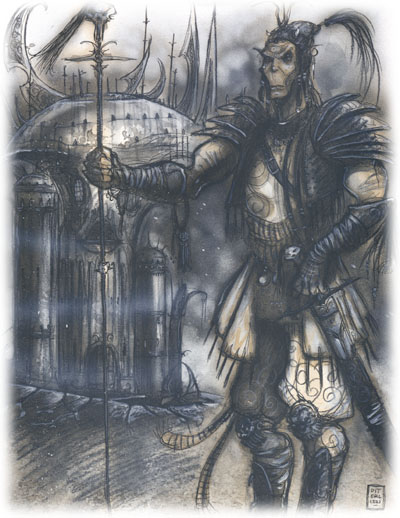
The Astral Plane is an unrelieved expanse of silver that bridges the Prime Material and the Outer Planes. One element commonly found are color pools that hook up the Astral to the Outer Planes (specifically the first layer). Pools are color coded so you can tell where they lead. If a traveller concentrates on a pool, he can see what’s on the other side, which is helpful to avoid landing in the middle of a Blood War skirmish. Astral Conduits are also visible, appearing as long silver arteries. While their ends are stable, the body of the conduit thrashes around and can suck up a traveller and spit them somewhere he didn’t want to go.
The most common resident of the Astral Plane are the Githyanki, who are very hostile to anyone they come across. They build vast communities on the corpses of near-dead powers that drift through the Astral. God-isle can sometimes stir with activity, and the dreams of these forgotton deities can overwhelm those living on it. Besides the God-isle, the githyanki travel in bizarre ships powered by thought.
Movement through the Astral Plane is based on a traveller’s Intelligence score (Int x 30). In combat, Intelligence determines a player’s attack and damage bonus in place of Strength, while Wisdom provides the bonus to AC and ranged attack that Dexterity normally does. The range of all missile weapons are doubled, though non-native creatures suffer a -2 penalty. In addition to the restrictions on magic already noted, detect magic is useless because everything here radiates magic. Besides the residents (like the Githyanki and Astral Dreadnaughts), Astral Winds can sweep travellers to the far reaches of the plane.
Next Time: The Inner Planes-Atomic Theory Can Go Fuck Itself.
DM Guide to the Plane - The Inner Planes
Original SA post GM Guide to the Plane - The Inner Planes
There are 18 Inner Planes, connected to each other by 3 perpendicular rings (Rule of Three + Unity of Rings?
 ) The 4 Planes most well known to Primes are the Elemental Planes of Air, Earth, Fire, and Water. Connecting the Elemental Planes to each other are the Paraelemental Planes: Ice, Magma, Ooze, and Smoke. There are also 2 Energy Planes, Positive and Negative. These are connected to the Elemental Planes by way of the Quasielemental Planes: (Ash, Dust, Salt, Vacuum, Lightning, Mineral, Radiance and Steam). These 18 Planes comprise the building blocks of the Universe. Because they are unaffected by belief in the same manner as a lot of Planes, and because most powers prefer the Outer Planes, the Inner Planes don’t see as much use by the setting as the Outer or Astral Planes. Nevertheless, there are plenty of opportunities for awesome adventures if you know where to look.
) The 4 Planes most well known to Primes are the Elemental Planes of Air, Earth, Fire, and Water. Connecting the Elemental Planes to each other are the Paraelemental Planes: Ice, Magma, Ooze, and Smoke. There are also 2 Energy Planes, Positive and Negative. These are connected to the Elemental Planes by way of the Quasielemental Planes: (Ash, Dust, Salt, Vacuum, Lightning, Mineral, Radiance and Steam). These 18 Planes comprise the building blocks of the Universe. Because they are unaffected by belief in the same manner as a lot of Planes, and because most powers prefer the Outer Planes, the Inner Planes don’t see as much use by the setting as the Outer or Astral Planes. Nevertheless, there are plenty of opportunities for awesome adventures if you know where to look.
While each Plane has its own unique characteristics, there are some general rules that apply to all of them. Except for the Planes of Air, Steam, and Lightning, mortals can’t safely breathe in the Inner Planes (though amphibious or aquatic ones can survive on the Plane of Water just fine. Also, there is generally no food or water readily available. Spells that require access to the Astral Plane do not function without a Spell Key. Elemental Spells can be modified by Wizards to for use in each Plane. So, for example, airy water can be changed into airy earth . Research on the modified spell takes 1d6 weeks and costs 1d6 x 100gp. This spell counts against a Wizards maximum spells per level (in 2nd Edition, Wizards with less than 18 Intelligence could only know so many spells/level. Magnetic directions on the Inner Planes are meaningless, and sometimes there isn’t even an up or down. Instead, anyone trying to navigate an Inner Plane must rely on a device called a an elemental compass . However, the best way to get around the Inner Planes is to find a native guide - all natives can never get lost on their native turf.
Also, there are usually pockets of other elemental substances floating about within each plane. How stable they are can vary, but some are stable enough to allow for large cities to form around them. An interesting condition of each Plane is the closer you get to the boundary of its neighbors, it begins to take on the characteristics of that Plane, as if it is leaking into its neighbor. Summoning Spells can draw from either the native Plane of its neighbors.
Elemental Plane of Air
The Plane of Air is pretty much open skies with no visible ground. Because this Plane is relatively habitable, there are a lot of beings with no natural flying ability that make their home here. They live on floating fragments of Earth that drift through the Plane. Within such communities, there is a subconsciously agreed-on “down” direction. If a non-native of the Plane loses their ‘footing’, he ‘falls’ in the last direction he associated with ‘down’ indefinitely until colliding with another object. Inanimate objects are not affected by this ‘subjective gravity’.
There are a couple of notable locations on the Plane of Air. The Citadel of Ice and Steel is the major settlement in the Plane, and is the center of power for the Djinn. Other locations include a vortex to the Elemental Plane of Water called the Watersprout, Borealis, and Taifun, the palace of tempests.
One additional complication of summoning is that summoning a native of the Plane of Air is not under the summoner’s control. A caster has to use another method of forcing his will on the summoned creature.
Along with air elementals and djinn, the Plane of Air is where invisible stalkers are native to. Two noted Powers that reside here are Akadi, the queen of air elementals, and Caliph Husam al-Balil ben Hafhat al-Yugayyim (the Master of the Clouds and Son of the Breezes, Commander of the Four Winds, Ruler of All Djinn, Defender of the Heavens, Prince of Birds, Storm of the Righteous, and so on). Maelstroms can entrap travellers and cause 1d10 damage a turn until they make a bend bars/lift gates role or with outside aid. Spell casting is impossible while trapped.
”A Xaositect named Sival...for today” posted:
and Enjoy my stay, to traveller! Welcome your
Elemental Plane of Earth
The Plane of Earth is probably the most difficult of the Inner Planes to traverse, as it is pretty much solid rock. A few intrepid spirits have managed to mine ore from it, and metal from the Plane of Earth is highly valued. But to survive, you not only have to solve the issues of air, food and water, but you have to come up with a way to move through the stone and a way to tell where you are going. There are enough natives to this place to make blundering ahead blindly a quick way to get killed.
There are a few places of note. The Great Dismal Delve is the home of the dao, which includes the Sevenfold Palace that is the home of their khan. However, the dao are notorious slavers, so casual visits are not advised. The Pale River and the Iron Crucible are vortices to the Planes of Water and Fire, respectively. The Plane of Earth has numerous wizard fortresses and trading outposts, which are magically protected to resist being crushed by the surroundings. The Plane of Earth is also frequently used as a storage place for enemies and treasures of the powerful.
To get around, magic is required for the most part. It’s possible to just dig, but movement is restricted to 1 foot a turn, and detours around impenetrable rock must frequently be made. Any tunnels eventually “heal” after 1d6 days. Like with the Plane of Air, gravity is localized to the consensus of the immediate company. When two groups come into contact, the local gravity is determined by whoever has the highest Wisdom (Intelligence is the tiebreaker). This of course does not apply to natives of the plane. As with other Inner Planes, there are pockets of other elements that can either be a boon or hazard to travellers, depending on their nature.
Dao, earth elementals, and xorn are among the inhabitants of this layer. Two noted Powers that live here are Grumbar, the lord of earth elementals, and Kabril Ali al-Sara a1 Zalazil (Great Khan of the Dao, the Fountain of Wealth, the Perfect Compass, Atamen of the Mountain’s Roots, and so on). One particular hazard is earthquakes that last 1d10 rounds and cause 6d6 damage per round, no saving throw.
Elemental Plane of Fire
The Plane of Fire is among one of the more hostile of Inner Planes, and clueless Primes frequently mistake it for one of the layers of Baator. The main feature is that almost everything is on fire. .The few places that are not are enclaves of the efreet, who keep the flames from covering everything to accommodate business partners and slaves. Their main dig is the City of Brass. Eighty miles from the City of Brass (no idea why that’s specific) is Jabal Turab, the Mount of Dust. At the top of the mountain is a vortex to the Plane of Air.
Anyone travelling without protection from the flames must succeed a saving throw vs breath weapon or die instantly (those who make the save still take 5d10 damage). Unlike other Elemental Planes, the Plane of Fire does have a definite “up” and “down”. As with other planes, food and water must be brought in or created magically, and both sources require protection from the fires as well. Pockets from other Planes do not last long, as they are quickly destroyed. Many magical effects cannot withstand the effects of the Planes, and few of them can be compensated for with spell keys.
Efreet, fire elementals, azer, and salamanders are among the Plane’s inhabitants. Only two Powers make their homes here: Kossuth, the Tyrant King of fire elementals, and Sultan Marrake al-Sidan al-Hariq ben Lazan (the Lord of the Flame, the Potentate Incandescent, the Tempering and Eternal Flame of Truth, the Smoldering Dictator, and so on), whose the ruler of the Efreet. Kossuth’s realm is so hot that even fire creatures suffer 1d2 damage each turn while there. Nonliving dangers include fountains of flame (3d10 damage, save v breath weapon for half damage), cinder rain (2d6 damage per round to all exposed) and volcanic eruptions.
Elemental Plane of Water
The Plane of Water is a deceptively hospitable Plane (as soon as you find a way to breathe, which isn’t too hard). In fact, it contains as many dangers as its neighbors. The Plane is an endless ocean with no surface or bottom. Both freshwater and saltwater sea creatures can live in the Plane of Water. There are coral reefs that seem to be supported by unending branches. These coral reefs are the home of the marid. The greatest of these is the Citadel of Ten Thousand Pearls. Not far from this palace is the Bubble Net, a vortex to the Plane of Air.
While travel in the Plane of Water is simple, navigation is impossible without the aid of a guide. Pockets of other elements can be found throughout this plane. Besides that, all the usual rules for being underwater apply. The watery nature will affect a number of spells in unusual ways, many of which cannot be overcome by spell keys.
Marids, water elementals, water weirds, and tritons are natives of the Plane of Air. There are two Greater Powers as well. The first is Istisha, the queen of water elementals. The second is Kalbari al-Durrat al-Amwaj ibn Jan (Padishah of the Marids, the Pearl of the Sea, the Mother of Foam, Mistress of the Rivers, Savior of Fish, Patron of Waterspouts, and so on). Nonliving threats include unexpected stream currents (4d6 damage) and tidal bores that can suck travellers to vastly different reaches of the Plane.
Paraelemental Plane of Smoke
The Plane of Smoke lies between the Planes of Air and Fire. It is similar in nature to the Plane of Air except that it’s filled with hot, toxic fumes. It’s impossible to breathe without aid of some sort. Breathing is somewhat easier close to the Plane of Air. Which means that a saving throw vs. Poison is allowed to avoid suffocation, and you still take 1d10 damage if you make the save. Near the boundary of the Plane of Fire, the heat is intense enough to cause 1d10 damage (no saving throw) to those unprotected. The primary inhabitants of the Plane of Smoke are smoke mephits. The most notable feature of the Plane is the Choking Palace, which is the court of Ehkahk, the Smouldering Duke. Ehkahk is a Paraelemental Lord and is the self-proclaimed ruler of all smoke mephits. The Plane of Smoke is used as a battleground between the djinn and efreet.
Paraelemental Plane of Magma
The Plane of Magma is situated between the Planes of Earth and Fire. It consists of molten lava flows, igneous rock, and other volcanic landscapes. There are few places to visit here. One place is the Caldera, home to Chilimba, First General of the Cauldron and Master of All Mephits. The dao and efreet use this Plane as a neutral site for trade. Travellers need the same protections here as in the Planes of Fire and Smoke. Like the Plane of Fire, there is a definite “up” and “down”. Magic on this Plane have the same limitations as the Plane of Fire. Sudden bursts of lava can scatter molten lava in a 10 foot radius (save vs breath weapon or suffer 3d10 damage). The crust has a tendency of giving way under a traveller’s feet. In such occurances, he must make a saving throw vs. paralyzation or die instantly.
Paraelemental Plane of Ooze
Located between the Planes of Earth and Water, the Plane of Ooze consists entirely of mud. It’s a common place for wizards to dump their enemies. Sometimes they’ll remember to provide a pocket of air and food and water, but not always. Movement is similar to that of the Plane of Water, though visibility is even further restricted. All the spellcasting limits of the Plane of Water apply here, although fire-based spells can function at half-strength. The only inhabitants of note are ooze mephits. It is said there is an elemental baron here, Bwimb, but what he is the baron of is a mystery.
Paraelemental Plane of Ice
The Plane of Ice is found between the Planes of Air and Water. It is, as the name implies, an endless expanse of ice. All matters of Fun Things can be found trapped here. At the heart of the Plane of Ice is the Chiseled Estate of Lord Cyronax, the most powerful of Ice Elementals. He’s the most ambitious of the Paraelemental Lords, and he hopes to supplant all the other Elemental Planes (how he might do so I imagine is left to future supplements). Movement here is similar to the Plane of Earth. Travellers need to heat the air or suffer 1d6 damage each round. This is in addition to general protection from cold (which causes 1d6 damage if unprotected). Cold-based spells are completely useless on this Plane (?), while fire-based spells cause half damage. Ice mephits are the only natives. Raging Blizzards can hinder movement for 1d10 turns or more.
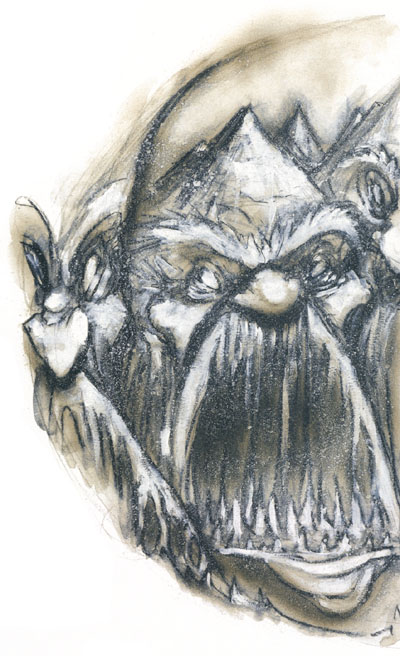
Quasielemental Plane of Lightning
The Plane of Lightning connects the Plane of Air with the Positive Energy Plane. There’s a shit-ton of lightning, with increasing density as you approach the Positive Energy Plane. At the gateway to that Plane is the Tower of Storms, which is mystical (that’s literally all that’s said about it). Travel is similar to the Plane of Air, but any metal that’s dagger-sized or larger automatically attracts lightning bolts; otherwise there’s a 10% chance of being struck by lightning. Lightning causes 1d8 x 10 damage (save vs rod for half) though protection from lightning will negate the damage. With each bolt, a second save vs rod must be made to avoid deafness (2d4 hours). Invisibility is useless on the Plane of Lightning. The Plane of Lightning is home to lightning mephits and shockers.
Quasielemental Plane of Radiance
The Plane of Radiance links the Plane of Fire with the Positive Energy Plane. It is a place of dazzling light that will fry the eyes of anyone unprotected (though victims still say it was very beautiful). For those that can avoid getting their eyes burnt out, the Plane of Radiance is a great place for creating items, as they take on some of the qualities of the Plane. On the border of the Plane of Radiance and the Positive Energy Plane is the Heart of Light, where great healings are supposed to be possible. Movement on the Plane of Radiance is the same as the Plane of Air, but travellers must protect themselves to the same degree they would on the Plane of Fire (as well as shielding their eyes). The only natives here are radiant mephits.
Quasielemental Plane of Mineral
The Plane of Mineral connects the Plane of Earth with the Positive Energy Plane. The Plane is filled to the brim with jewels and precious stones. Many a sod has come here looking to make a quick buck. Without protect, though, they discover that all the gems are as sharp as vorpal blades . Also, the inhabitants here are not keen on folks mining out their homes. Besides all the gems is the Tower of Lead, which is located at the crossing to the Positive Energy Plane. It is said that the greatest forge in the Multiverse is located within the tower. Movement on this Plane is similar to the Plane of Earth, but each round moving causes 1d4 damage. Magic AC reduces the damage by 1 per point of enchantment, up to a minimum of 1. Dao, mineral mephits, xaren and xorn make their homes here. For each day spent here, visitors must make a saving throw vs. petrification or be turned to stone.
Quasielemental Plane of Steam
The name of the Plane between the Plane of Water and the Positive Energy Plane is a bit of a misnomer. It’s more akin to a mist that gradually becomes finer as one approaches the Positive Plane. At the border is the Tower of Ice, which is frequented by alchemists trying to create special potions. Movement is similar to the Plane of Air, though it’s more akin to swimming close to the Plane of Water. Breathing is possible, but all movement is slowed by the suffocating mists. Water breathing removes this difficulty. Visibility is limited to 1d10 yards. Spell casting has similar restrictions as the Plane of Water, although fire spells can be used at half strength. Marids, mist mephits and steam mephits reside here.
Quasielemental Plane of Vacuum
The Plane of Vacuum connects the Plane of Air with the Negative Energy Plane. There is, quite simply, nothing in this plane, least of all breathable air. Some Doomguard and Dustmen take quite a fancy to this place, as you can imagine. The Doomguard even built a fortress on the border of the Negative Energy Plane called Citadel Exhalus, the Portal of Last Breath. Movement on this plane is accomplished by sheer will. Air and warmth must be provided-there is nothing here that can be transformed. Most summoned creatures will quickly die on this plane. Magic gases and fogs fail instantly, as do fire spells that last longer than an instant. There are no known creatures that are native to this Plane.
”Tall Tally of the Mercykillers” posted:
Artists are engineers of the soul. That’s why we lock them up.
Quasielemental Plane of Ash
The Plane of Ash links the Plane of Fire with the Negative Energy Plane. The ash that makes up the Plane suck the warmth from anyone unprotected. The Doomguard once controlled a skull fortress on the border of the Negative Energy Plane called Citadel Cavitus, but it has since been taken over by the lich Vecna. The Doomguard built a new stronghold called the Crumbling Citadel. Movement is normal close to the Plane of Fire, but becomes more like swimming deeper in the Plane. The ash must be transformed into a breathable form, and travellers lacking protection take 2d6 cold damage due to the heat draining out from them. Long-term fire spells are ineffective on this Plane. Fire- and magma-based creatures suffer 1 HD of damage per round of exposure. Other limitations are the same as the Plane of Earth. Aside from ash mephits, pockets of Negative Energy are a danger to visitors.
Quasielemental Plane of Dust
Between the Plane of Earth and the Negative Energy Plane, the Plane of Dust is just that-a sea of unending dust that chafes at travellers. Not only that, but the nature of the Plane causes visitors to break down physically. The Doomguard maintain a fortress at the border to the Negative Energy Plane called Citadel Alluvius. Movement and breathing are the same as on the Plane of Ash. Each day spent on this Plane causes 2d6 damage that cannot be healed while a traveller remains. Solid objects created on this Plane crumble to dust after 1d4 turns unless protected by a wall of force . The Plane is home to dust mephits, dune stalkers, sandlings, and sandmen. pockets of Negative Energy are a danger on this plane as well.
Quasielemental Plane of Salt
The Plane of Salt lies between the Plane of Water and the Negative Energy Plane. The surrounding salt dessicates the unprotected. The Doomguard have their fourth stronghold on the border of the Negative Energy Plane: the Citadel Sealt. Movement varies by location (can be similar to the Plane of Water, Plane of Earth, or Plane of Ooze). In addition to the problem of breathing, travellers must find a way to avoid dehydration or suffer 4d6 damage each day that cannot be healed while on the Plane of Salt. Water and ice created through magic lasts only 1d3 rounds, and is undrinkable upon contact with the Plane. Water-based creatures suffer 1 HD damage per round while on this Plane. Salt mephits are the Plane’s only inhabitants, and pockets of Negative Energy are again a danger to travellers.
Positive Energy Plane
This is the Plane of Life, though in fact there’s probably too much of it. A brief visit will cure a cutter of his wounds and ailments, but if he stays too long, he’ll literally explode from excess energy. Also the place is a bright as the Plane of Radiance, so eye protection is necessary. Movement here is accomplished by thought. Visitors heal 2d6 points of damage, and they continue to gain excess hit points after reaching their max. When they get to double their hit points, they burst into incandescent flame. If the visitor leaves soon enough, the excess hit points remain for 2d10 hours. Also, there’s no air here either, so travellers have to provide their own. Matter created through magic lasts only a round before exploding into harmless light. Damaging spells do the minimum damage. The only known inhabitants are the xag-ya.
”Rahm, a Bariaur Anarchist peeling his way through the Mortuary” posted:
‘Course I know how to talk to a zombie! But I just got back from the Negative Energy Plane, and I’m just plain sick of talking to cold folks, okay!
The Negative Energy Plane
This is the Plane of Death, and of the two energy Planes it’s the more obviously dangerous. There is nothing but utter darkness, and the Plane eats away at your very life force. Not surprisingly, there are a metric ass ton of undead hanging out here, and the Dustmen keep their main fortress in this place as well. Movement is by thought. The Plane inflicts 2d6 points of damage on anyone unprotected. Anyone who dies from this effect cannot be resurrected by any means. Spells that do damage always do max damage, while healing spells always heal the minimum amount. Besides various undead, the Plane is home to xeg-yi.
Next Time: The Outer Planes-Your Philosophy minor is no longer useless!
DM Guide to the Plane - The Outer Planes
Original SA post
The Outer Planes

The true heart of the Multiverse is the Outer Planes - at least, that’s according to the planars that live there. Subjectivity aside, they have a point. Unlike the Inner Planes, which are pretty much defined by a single element, the Outer Planes are shaped by the beliefs of its inhabitants. For a game that puts a great deal of focus on ideas and philosophies, this gives tangible consequence to what might otherwise be academic points of conflict. The Outer Planes have another thing going for them: they are the home of the Powers, the most powerful beings in the Multiverse.
In comparison with the Inner Planes, the Outer Planes are pretty hospitable - a fellow can breathe, is not by default at risk of sudden death just by being there, and can get around and navigate to a reasonable degree. It’s not the environment that’s going to kill you dead (for the most part), but the inhabitants. Besides the Powers (and their proxys and petitioners), the Outer Planes are home to some of the most powerful entities an adventurer is likely to face in combat. But unlike the poor blokes that are summoned into a Prime campaign to make for an interesting boss fight, on the Outer Plane you’ll be meeting them on their home ground, and most are not amused at all by a bunch of crusading assholes waving around magic weapons.
Even at their most ‘mundane’, the Outer Planes are far more spectacular than anything to be found on the Prime Material Plane. The Outer Planes do share a number of common structural characteristics. Most of the Outer Planes can be divided into
layers
, each of which is itself infinite in scope. Aside from general properties common to all the layers on a Plane, each layer has their own set of physical characteristics. Layers can be further segmented by
realms
, which are the homes of the Powers. These can take on a whole slew of features that are determined by the resident Powers. Some realms are in fact home to several Powers, who together form a
Pantheon
. The Pantheons for the most part are based on historical pantheons that are described in the
Legends and Lore
supplement. There are also fantastic pantheons which cater to the various demihuman and humanoid races of AD&D. Finally, there are those ‘pantheons’ specific to the various AD&D campaign settings, although they generally tend to be scattered all over the place.
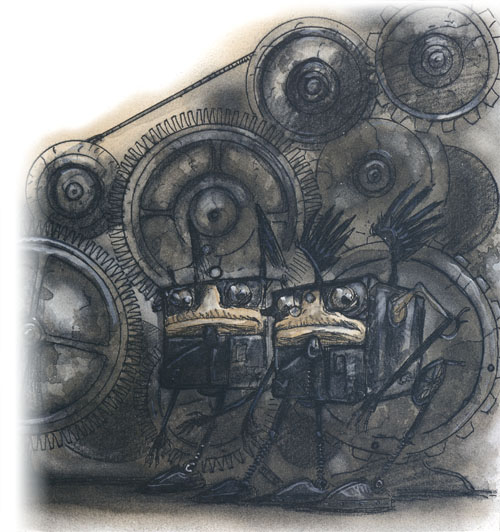
There are a number of ways to get about on the Outer Planes. One is to travel through the Astral Plane to access the Color Pools that lead to each of the Planes. These will only get you to the top-most layer. Alternatively, there are Astral Conduits that link any one layer to another. These are usually stable and fairly well mapped out, but they have a tendency of dumping those that use it a long way’s away from where they want to be. There are natural highways that connect the Planes to each other and provide passage from one layer to the next. These tend to be well travelled, but can be slow, and on the more lawful planes closely monitored. The method that is preferred by Planewalkers is to utilize the portals of Sigil. By probing for the right information, an adventurer can find a portal that will take him right where he wants to go.
The book reiterates how magic is altered on the Outer Planes. I won’t repeat them except to note that summoning spells can draw from the Plane you are on
and
any adjacent Planes (the chapter on magic seemed to imply that you can only draw from the Plane you are on). Further description is given to what are known as
spell crystals.
When a wizard casts a spell to summon something from the Outer Plane or commune with one of its inhabitants, a whizzing, glowing crystal is created on the target Plane and begins to seek out the spell’s target. When the crystal finds an appropriate target, it touches the poor planar and releases its magical energy. If the spell is a summons, then the target is whisked off to the Prime Material Plane to do whatever inane task the summoner wanted done. Commune and divination crystals bombard their targets with insistent and angry questions and won’t go away until the effects of the spell are satisfied.
Generally, there is no way to know beforehand what a spell crystal will do when it touches you. Anyone with a Wisdom of 19 or higher can make a Wisdom check (at -5 Penalty) to learn the nature of the spell. Planars generally avoid spell crystals, although it’s possible to capture one and keep it to study, show off, or toss at another planar (I guess the wizard who cast the spell is out of luck at that point, though there doesn’t seem to be any reflection of this possibility in the general 2nd edition rules). As stated in the Player’s Guide, prime characters never have to put up with this bullshit.
Planar Pathways
Aside from the Great Road and the general means of getting around on the Outer Planes, there are a number of pathways that take the form of geographical features (and in one case, a big fucking tree). The River Styx crosses through all of the top layers of the Lower Planes, although for a few Planes it connects to deeper layers as well. Coming into contact with the River Styx for most creatures causes a total memory wipe. (save vs. spell to avoid. Making the save still causes you to forget the last 24 hours.) The river is a well used highway for the fiends, as you can get to any other Lower Plane using it without having to travel through the intervening Planes. Its Counterpart on the Upper Planes is the River Oceanus. This river runs through all 4 layers of Elysium, all 3 layers of the Beastlands simultaneously (it’s complicated), and the first and second layer of Arborea (a tributary runs through Ysgard as well). The River won’t give you a brain scrub like the Styx does, and supports both fresh and saltwater life. Like the Styx, travel along it is somewhat ambiguous-going from one Plane or layer to the next is somewhat ambiguous. Also, while they are both called ‘rivers’, depending on the locale they can span the same length and depth as oceans.

Yggdrasil, the World Ash, connects all the Realms maintained by the Norse Pantheon. By travelling along its branches, one can get to Valhalla in Ysgard, Niflheim in the Grey Wastes, and Loki’s realm in Pandemonium. Yggdrasil also reaches to every Prime Material World where the Norse Pantheon is present. There are several other places Yggdrasil is connected to, but not all have been mapped out. Each planar crossing is designated by the branch disappearing into a portal of shimmering color. These passages are always two ways.
Similar in nature to Yggdrasil is Mount Olympus. This pathway links up the realms of the Greek Pantheon and the worlds they are worshipped on. The realm of the same name on the Plane of Arborea is simply the uppermost layer of this planar highway. Within the Mountain are portals that lead to Hades’ realm in the Grey Wastes, the Prison Plane of Carceri, and Gehenna, and possibly others.
Dealing With Powers
The DM’s guide puts a strong emphasis on how fucking powerful a Power is and difficult it should be for PCs to get the one-up over them. That’s not to say it can’t be done, but Planescape is most certainly not about walking into Zeus’ Palace and killing him. That’s not the same as the Powers actively messing with the players while they have no way of resisting. To put it simply, the Powers simply aren’t concerned with what a single or group of mortals are up to (Ed Greenwood’s entourage of Mary Sue’s notwithstanding
 ). Also, becoming directly involved with mortal affairs is the quickest way to wreck the entire Multiverse. The concern of Powers is with the well being of entire worlds of worships and whatever neighboring powers are up to.
). Also, becoming directly involved with mortal affairs is the quickest way to wreck the entire Multiverse. The concern of Powers is with the well being of entire worlds of worships and whatever neighboring powers are up to.
If the PCs do have business with a Power or Pantheon, they will most likely interact with the Power’s priests, proxys, and petitioners.
But the Powers themselves cannot be visited or chatted with.
(Book’s emphasis) And completely killing a Power is right out save for an alliance of other Powers. That’s because to do so requires killing the Power on his home turf, where he or she is free to rewrite the laws of reality as they desire.
”DM’s Guide to the Planes” posted:
No mortal has ever reached a deity’s status and none ever will, for in attaining it a being is no longer mortal.
That is the true strength of the powers.
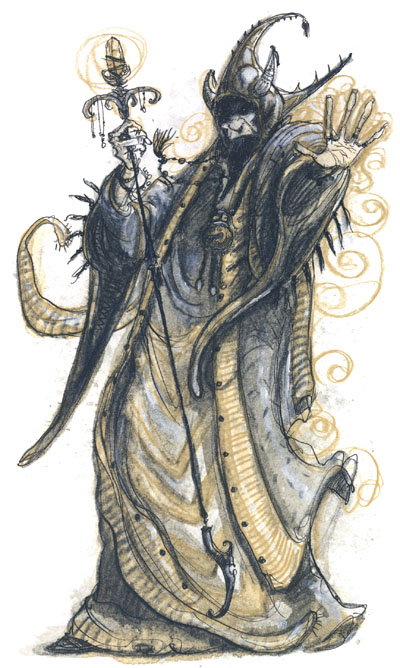
The Lady of Pain
Pretty much every Power, especially the ones on the Lower Planes, would love to gain control of Sigil. While they may not be able to enter it, theoretically it’s possible to send enough worshippers there to gain control over it (remember, belief=power). What prevents this from happening is the Lady of Pain, who is the quintessential untouchable npc that can never be challenged in a realistic manner by either PCs or NPCs. While such NPCs are often a massive albatross that weighs down a setting if used poorly, in Planescape, the Lady of Pain works. She’s pretty much why Sigil is able to work as a starting point for a 1-20 campaign set on the Outer Planes.
The Lady of Pain has no stats. None. She simply is. She does not talk to anyone, but is seen floating through the streets of Sigil for any indiscernible reason. Whatever communications she does make is through the dabus. She pretty much gives no fucks about anything. Once in a epoch she may help someone. More often though she just kills those that bother her. Or irritate her. Or worship her. Or are crossing the street at the wrong moment. That’s not to say that folks don’t try-when a prize is as grand as Sigil, there are enough morons even among the ranks of Powers to believe it’s worth a shot. It never is

”Darel Silvatong, rattling his bone box for the last time” posted:
‘Course I’ll talk to her! Hey, I can bob a baatezu, charm an aasimon, get a modron to turn stag - I can certainly talk to the Lady of Pain!
The Blood War
The Lower Planes are the battleground for the Multiverse’s largest and longest lasting conflict: The Blood War. The war is fought between the baatezu and the tanar’ri. The yugoloths serve as mercenaries for boths side (while playing the warring parties as fools according to some), and every Power on the Lower Planes (as well as Powers throughout the rest of existence) are involved in this conflict. The beginnings of the war probably go back to the very creation of the Planes, and there is no end in sight. The reason the war is prosecuted at all can only be speculated at. One thing for sure is that it keeps the fiends from ever making big plans on Sigil, as anything they do would be immediately countered by the other side.
Next Time: A Closer Look at each Outer Plane - There’s 17 of these bastards to go through.

DM Guide to the Plane - The Outer Planes, cont.
Original SA post The Outer Planes, Con’t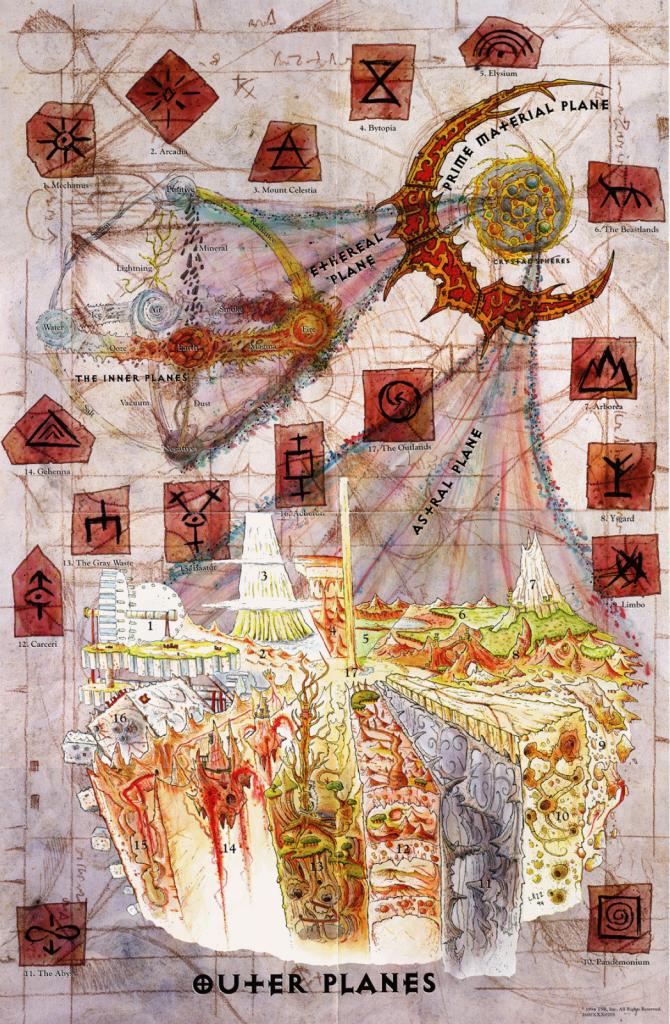
Here’s the complete fold out depiction of the Multiverse that came with the Planescape Box. One cool detail it shows is that each Outer Plane has a symbol associated with it.
Note that the following descriptions are only the briefest of overviews. They are far from complete. 3 additional box sets provide additional detail on each of the Plane and go much further in describing the nature of each Plane as well as who lives there.
The Abyss-The Most Terrible Place in the Multiverse outside of Gary, IN (Chaotic Evil)
There are either infinite or near-inifinite number of layers on the Abyss. No one is either to find out either way. Virtually every layer is immediately deadly to visitors. Even worse, though, are the natives, the most prominent are a race of fiends called the tanar’ri. The tanar’ri used to be called ‘demons’ in the 1st Edition Monstrous Manual. But then Tom Hanks and Jack Chick came along and TSR decided it was best to not call them ‘demons.’ Personally, I love these different names, and I really wish that WoTC continued using them instead of quietly dropping them.
Anyway, the tanar’ri. The tanar’ri are all chaotic evil. They are horrible, sadistic assholes to the core, and they aren’t shy about demonstrating it. They’re default reaction to visitors is to kill them or impress them in their armies for the Blood War. The reason they do so is, a) because they can, and b) they find it hilarious. Oh, and there are essentially unlimited numbers of them. The only reason they haven’t overrun creation is because they’re about as easy to organize as a herd of schizo cats.
Petitioners that arrive on the Abyss most often become manes, the lowest rank of the tanar’ri. Despite being cannon fodder and chew toys for tougher tanar’ri, manes are quite satisfied with their position. That’s because all manes have a chance of turning into a stronger form of tanar’ri, and power is pretty much the only thing that natives to this Plane want.
The topmost layer is the Plain of Infinite Portals. All subsequent layers have a gate to this layer in the form of a giant sinkhole. The blasted landscape is covered with the strongholds of individual tanar’ri lords that are high on the food chain but not quite high enough to hold their own layer.
There really isn’t any common physical or magical traits that are common to all the layers of the Abyss beside just being terrible and unpleasant and likely to be fatal. Magic use draws the attention of Powers and high-ranking tanar’ri. That’s attention most would want to avoid. Illusions and wild magic are enhanced on the Abyss.
There are a number of Powers that make their home here: Sess’inek the lizard man god, Laogzed the troglodyte god, and the Great Mother of the beholders make their home here. Most of the drow pantheon is located in the Abyss as well. Setting-specific powers include Chemosh and Hiddukel of Dragonlance, and Besheda and Umberlee of the Forgotten Realms.
”Tall Tally of the Mercykillers” posted:
It’s better for some berks to be in chains than to be free. You, for instance.
Acheron - There’s a tabletop metaphor somewhere here.... (Lawful Evil Neutral)
Acheron is the Plane of WAR. The Powers of this Plane enforce a brutal discipline among its inhabitants According to the GM’s guide, it’s probably the safest place to do business with the fiends, though to be honest, that’s not saying much. To give it a witty summary, this is the Plane of North Korea, with a heightened chance of being crushed by gigantic geodes.
Each layer of Acheron is composed of free floating geographic constructs, primarily cubes on the top two layers. On the third layer, these geographic shapes take on more bizarre shapes, and on the lowest layer they are pretty much flying shards of glass. On the first three layers, these geodes have a tendency of colliding with each other, obliterating anyone on the surfaces smooshed together.
Acheron is composed of 4 layers. The topmost layer is called Avalas . The petitioners of this layer are in a constant state of war, and are popular recruiting grounds for the baatezu. One of the Powers of this layer is Lei Kung, the Chinese God of Thunder. He maintains a realms which floats between the great cubes. One cube is shared by the Orc and Goblinoid Pantheons, and the two war amongst each other on a constant basis.
The second layer is Thuldanin, a graveyard for a whole assortment of military machinery. Scavenging possibilities are limited by the fact that objects here will quickly petrify into stone...including visitors! Nevertheless, scavenging parties from Avalas frequent this layer to discover possible fantastic weapons. There’s about a 1-in-1000 chance of finding something useful.
The third layer is Tintibulus. It’s more or less composed of any dice type that might be rolled in a tabletop game. There’s pretty much nothing of interest here beside the odd wizard ddoing research.
The bottom layer is called Ocanthus. It’s made up of razor-sharp shards that fly across the layer. Such plates are treated as vorpal weapons and have a THAC0 of 11 that ignores armor.
On any layer, gravity conforms to whatever flat surface is immediately beneath you. Cubes that are on a collision course are visible a day or two before impact, so those with enough sense can make their escape. Wild magic is diminished on Acheron. Both yugoloths and rakshasa count themselves as natives of this Plane.
”Mercykiller proverb” posted:
Justice is not Law.
Arborea -
 Party With The Gods Everyday!
Party With The Gods Everyday!
 (Chaotic Good)
(Chaotic Good)
”Flishard Willowheels, a Sensate” posted:
He screamed, turned purple, and writhed on the floor after one sip? Okay I’ll give it a try.
Alternatively called Olympus or Arvandor after the two main Pantheons of the Plane, Arborea is quite simply a big ol’ party house. And it’s not just the locals living it up-the very land itself acts like its been on a kegger. The wilderness here is extreme, albeit still in the realm of being plausibly natural. A somewhat accurate description of the locals is that everyone behaves like they’re in an anime, except no one is allowed to be a moe-blob.
Aside from the Greek and Elven pantheons, the Sensates maintain a palace on Arborea. The Palace is a hybrid of a museum, theatre, and beer garden. Portals between layers are not as common on Arborea as other places, and they tend to be guarded by the Powers and their petitioners. According to the Guide, it’s to keep un-intelligent monsters from blundering all over the place, although to be honest that doesn’t really fit with Arborea as the Chaotic Good Plane.
There are three layers. The first is called Olympus. Both the Greeks and the Elves make their primary residence here. The two pantheons lie at opposite ends of the Plane. By some trick of the land, both realms occupy the highest point on the layer, though neither is higher than the other.
Ossa (or Aquallor to the elves) is the second layer of Arborea. It is a vast but shallow sea with islands scattered across it. Aquatic elf petitioners live under the water, while greek petitioners inhabit the islands. Sashelas of the Elven Pantheon makes her home here, as does Poseidon. Ossa is one of the two sources/mouths of the Oceanus, the other being Thalasia in Elysium.
Pelton (Mithardir to the Elves) is Arborea’s third layer. The layer is a great desert filled with ruins. Although it isn’t hot, there is a sense that this layer has been deliberately abandoned by the inhabitants. The Egyptian goddess Nephythys makes her realm here.
The vast distances and rugged terrain make travel by foot impractical, so flying mounts or magic is recommended for getting around. Any creature that was featured in a greek legend can be found living on Arborea. Campaign specific powers include Llira, Sune, and Tymora of the Forgotten Realms.
Arcadia - I hope you loved the Fifties (Lawful Neutral Good)
Arcadia is described as the Land of Perfect Good. The very nature of this Plane is organized by precise, geometric patterns, as if it was one great garden. Even the day-cycle is perfect. There are exactly 12 hours of day- and nighttime, with no dusk or dawn in between.
Everything that lives on Arcadia is committed to expressing the Greater Good...and will kick the shit out of anyone that seems like they might disrupt it. All Arcadian petitioners can know alignment . Anyone that reads as evil gets attacked on sight. It’s small wonder that the Harmonium have a strong presence here.
There are said to be 3 layers, but travel between them is heavily restricted by the locals (and assisted by the Harmonium. We’ll get into greater detail about that later...). On the topmost realm there are two realms of note. The first is the megalopolis of Marduk, home to the Greater Power Marduk. The city is built around two rivers, the
The second realm is Mount Claggedin, a perfectly conical mountain that is filled with dwarf einheriar and their armories. The place is home to the Dwarf Power Clanggedin Silverbeard, who is pretty much Armok of Dwarf Fortress. He sends his petitioners off to fight epic battles in Acheron and other spots on the Lower Planes. All and all, he is
 to the core.
to the core.
Creatures of Arcadia (though not petitioners) are immune to illusions and phantasms. A natural animal of this Plane are also not affected by spells that would summon or control them on the Prime. In addition to Marduk and Claggedin, Reorx of Dragonlance and Azuth of Forgotten Realms have realms on this Plane. Some interesting inhabitants not mentioned so far are devas, hollyphants, and t’uen-rin.
Baator - If Dante’s Inferno had a retarded stepson. (Lawful Evil)
Baator is also known as the Nine Hells and a whole other bunch of foreboding names. My favorite of the sample given in the Guide is simply “The Big One.” Baator is populated by the baatezu, formerly called “Devils” in the first Monstrous Manual. The Baatezu are the Lawful Evil fiendish race, and have organized Baator into a brutal military dictatorship. The baatezu concern themselves with three things: getting as many mortals to wind up as petitioners on Baator, killing every gods-damned Tanar’ri, and genocide-level office politics. Petitioners on Baator take the form of man-size larvae with human-like faces, or as more immediately useful lemures. All petitioners are constantly tormented by the baatezu. Like petitioners on the Abyss, eventually a petitioner here may be transformed into a baatezu itself.
Baator has nine layers. Topmost is Avernus, a rocky wasteland constantly bombarded by fiery rocks. Avernus is filled with baatezu legions that serve as the primary defense against invaders. These legions are led by the Pit Fiend Bel, who earns honours from the Archduke of the layer (in later supplements, this changes to Bel leading a palace coup, but more on that later). The goddess Tiamat guards the entrance to the next layer. Avernus is one of three layers the River Styx goes through.
The second layer is Dis, named for the great iron city that dominates this layer. The iron is more or less everywhere, and is hot enough to burn the flesh of the unprotected. This includes the petitioners who are made to perform pointless projects that go nowhere (so pretty much like any city maintenance crew
 ). The archduke who rules this layer does so from a tower of lead and stone.
). The archduke who rules this layer does so from a tower of lead and stone.
The third layer is Minauros, an endless swamp dominated by a city of black stone that is forever sinking deeper into the mire. Petitioners are driven to scavenge for seemingly rarer deposits of stone. Decay and disease are ever presents.
Phelgethos, the fourth layer, is pretty much the Plane of Fire with 90% more Evil. The one city here is Abriymoch, built in the caldera of an almost extinct volcano.
Stygia is the fifth layer of Baator, and the second to be reachable via the Styx. In fact, the Styx essentially makes up the entire layer as a great, frozen sea. Lightning streaks across the sky. On one of the ice flows is the city of Tantlin.
Malbolge, the sixth layer, is one great rockfall. There is no way to navigate this layer except by climbing about boulders the size of buildings, or work your way through the tunnels between boulders. A series of copper clad fortresses dot the layer.
The seventh layer is Maladomini, the layer of ruin. Petitioners here are at constant work building new cities for the Archduke of the layer. The land is scarred with mining pits and abandoned quarries. Each city is built on top of the other, the most current city being Malagrad. The ruins of the city beneath are extensive enough to give lesser baatezu pause.
The eight layer Cania is the Plane of Ice with 200% more evil. It is colder than Stygia, covered by glaciers and great mountain ranges. The Archduke of this layer rules from the citadel of Mephistar, overlooking the glacier Nargus.
The final layer of Baator is Nessus, a plain shattered by rifts deeper than any ocean trench. The palace of Baator’s overlord lies at the lowest depth of the layer (at some-point this changes to overlooking the deepest ravine instead). Virtually nothing is known about this fortress, save that it is greater in scope than Khin-Oin on the Grey Wastes. The river Lethe runs through this layer, as well as a secret and closely-guarded tributary of the Styx.
Wild magic is diminished on Baator. Aside from the baatezu themselves are numerous infernal critters that are commonly associated with them who make their home here. Takhisis of Dragonlance maintains her realm on Baator (primes from Krynn who claim she lives in the Abyss are just being idiots as usual).
The Beastlands - The Power is Yours! (Neutral Good Chaotic)
The Beastlands are also called the Happy Hunting Gounds by some primes. The Beastlands include every natural environment and biome that exists on the Prime Material, and each one is filled with any possible fauna or flora that could be found in such a place. Such a set up might not make biological sense but shut up! These are the Outer Planes, that sort of weirdness is entirely okay.
There are no settlements of any kind in the Beastlands. There aren’t any human petitioners either. Petitioners that arrive on the Beastlands become animals. This is limited to natural animals only, which means no magical critters. Of course, dinosaurs and prehistoric bears are considered to be natural. All animal petitioners have the ability to talk. If any of them were spellcasters in real life, they retain some of their spellcasting abilities. Most of the time they don’t use them, but if some asshole shows up and starts pretending he’s Steve Irwin, they may wind up with a nasty surprise.
Now a word about why I’ve ragged on the Beastlands. Because they’re animals, the petitioners here become neutral-aligned, just as animals in the Prime are. In addition, planar beings specifically native to the Beastlands (like the animal lords) are also neutral in alignment. So if the petitioners are neutral...and the prominent planars are neutral... then why are the Beastlands among the Upper Planes?!? MY VERISIMILITUDE!


There are three layers of the Beastlands, each corresponding to a period of the day. The top layer, Krigala, is the daytime layer. Brux corresponds to both dusk and dawn, while Karasuthra is the nighttime layer. The River Oceanus runs through all three layers simultaneously (don’t ask).
Any survival skill used on the Beastlands works better (+2 or +10%, depending on the type of roll). Spells that affect the weather, wind, or air fail automatically. Also, the ‘animals’ in the Beastland cannot be affected by spells which control animals. Along with those inhabitants mentioned, the Beastlands is populated with aasimon, baku, and mortai. The Dragonlance Powers Chislev and Habbakuk make their homes here, as do the Forgotten Realms Powers Deneir and Milil.
Bytopia - Brought to you by the Sheboygan Board of Tourism! (Neutral Good Lawful)
Bytopia is also known as the Twin Paradise to the Primes. I have my own name for the Plane: Wisconsin.
You see, the inhabitants are characterized as industrious and unsympathetic to freeloaders and troublemakers, who live in small, quiet communities that engage in farming and light industry. The wilderness is perfectly normal, neither super-organized like Arcadia or ridiculously overgrown like the Beastlands, and everyone just wants to mind their own business and aren’t concerned about grandiose adventurers. Also, there are a bunch of peculiar short people mucking about.
This describes the town my college is located in to a t. Provoke a sense of wonder, it does not.
Bytopia is not without fantastic elements, of course. It’s two layers, Dothion and Shurrock (which are basically identical save for the type of industry engaged in) are stacked on top of each other with their surfaces facing inwards. That means that when you look up, you can see the surface of the other layer above you. The tallest mountains on Bytopia actually form columns. So of course, climbing these mountains-turned columns are the chief way of getting from one layer to the next.

Okay, let’s assume that oxygen deprivation isn’t a problem. Climbing a mountain is an incredibly taxing effort. And eventually you get to the point where gravity switches direction. The book states that making this crossing is “tricking business” but one that you get used to after the first try. To me, it sounds like a surefire way to plummet to your death.
Alternatively, you can just fly. Which again assumes that thinning atmosphere won’t be a problem.
Okay, enough of this. The Gnomish Pantheon is located here, led by Garl Glittergold. There’s a foolish titan named Epimethus that gets into all sorts of trouble (I’m imagining a bad Will Ferrell movie). Kiri-Jolith of Dragonlance and Illmater of Forgotten Realms are also located here.
Fuck you, Bytopia.
Carceri - Johnny Cash now doing special tours here in the afterlife. (Neutral Chaotic Evil)
Known also as Tartarus to the Primes, Carceri is the gulag of the Multiverse. This is where those that get screwed over in the great cosmic game wind up going if their enemies either lack the power to kill them outright or (more likely) decide that death would be too good for them). Here, they plot for the day that they return, though given the nature of Carceri, that’s pretty fucking unlikely. The best known inmates of Carceri are the Titans of Greek myth. Carceri is also home to one of the lesser known race of fiends, the gehreleth.
Carceri is structured like a manushka doll, each one inside the other. The layers themselves are for the most part free-floating planetoids. A fiery light illuminates each layer, though no heat is given off so Carceri is pretty fucking cold.
Petitioners to Carceri were traitors and backstabbers in real life. They are pretty much compulsive liars.
The first layer, Othrys, is where most of the exiled titans are consigned. They spend their time bitching at each other. Othrys is a realm of bogs and quicksand. Cathrys, the second layer, is covered in fetid jungles and scarlet plains. The plants here ooze acid that eats through metal. The third layer, Minethys, is filled with blasting sand that can strip exposed flesh to the bone. Petitioners here are forced to live in literal holes in the ground, as there is nothing else that can provide shelter.
Colothys is a layer of nothing but immense mountains. Travel by foot is nearly impossible, and what roads that do exist are over rickety bridges and narrow trails. The titan Crius lives on this layer, and is in the middle of a conflict with the god of Hill Giants, Grolanthor. Porphatys is a cold, shallow ocean where both water and snow are mildly acidic (1d6 damage to unprotected travelers). Petitioners crowd small isles and don’t do much beside starve. The deepest layer is Agathys, which is also the coldest. The winds here are bitterly cold, causing 1d2 damage a round. Petitioners here are half-frozen in ice.
Carceri is a pretty frequent battle ground in the Blood War. The titans generally do not get involved. Malar and Talona of the Forgotten Realms make their homes here.
Elysium - The Joy Can of the Planes (Neutral Good)
Elysium is the the most wonderful place in the Multiverse. It’s so wonderful, though, that it’s infectious. Stay long enough and you’ll never want to leave. Everything in Elysium is beautiful and the petitioners are super chill. They’re pretty much allowed to do whatever they want, and because
Elysium has 4 layers, the River Oceanus running through all 4 of them. Amora is the topmost layer. Its a land of forests and meadows, and has a number of petitioner cities in them. The headquarters of the Transcendent Order is on this plane. The Egyptian Goddess Isis and the Sumerian/Babylonian Goddess Ishtar maintain realms on this layer. Ishtar’s layer is also known as the City of the Star, a metropolis lit by a brilliant star set upon the highest tower.
The second layer is Eronia, a rugged land of mountains and waterfalls. Compared to Amoria, travel is potentially hazardous, so finding a guide is a good idea. The powers Enlil of the Sumerians has a mountain realm on this layer, and Nanna-Sin (no idea which mythology) plies the river in a great barge.
Belierin is the third layer, and is a land of wetlands and swamps, though travellers here never have to worry about getting malaria or giant mosquitos. Little is known about the layer. The fourth layer is Thalasia, where the River Oceanus has one of its ends. The layer is a great ocean with small islands, which are the resting place of dead NG player-characters and heroes of similar stature. The oceans are home to a number of sea deities.
The main means of getting around is the River Oceanus. The river is safe, though there are natural hazards like whirlpools or rapids you need to watch for. Phoenix and moon dogs are native to Elysium, and there are a notable number of solars that live here. Of the campaign powers, Tsuki-Yomi, Ushas, Mishakal, and Majere from Dragonlance live here, as do Chauntea and Lathander of Forgotten Realms.
Gehenna - Directed by Jerry Bruckenhiemer (Neutral Evil Lawful)
The Plane of Gehenna is made up of massive volcanoes that float freely in the void. These volcanoes erupt pretty much all the time. The air is full of noxious gasses, magma sprays constantly, and there is not one 5’ square of flat surface. The petitioners on this Plane cling to the rocks and do their best to act like there is nothing out of the ordinary with their miserable lives. Try not to feel sorry for them, as they are suspicious and greedy and won’t do anything without payment (remember unlike people in real life, petitioners in a miserable existence actually always have themselves to blame for their lot). One of the cool things is that from any of the four layers, you can see the other layers floating off in the distance (when the smoke clears up at least).
Khalas is the first layer, and is basically a big, black volcano. Parts of it are more active than others, so you can find tunnels and caves, as well as rivers to travel along (if not actually drink). The Styx runs through this layer. It does tend to plunge into the void suddenly, so getting a guide is recommended. One of the major divine realms on this layer is the Teardrop Palace of Sung Chiang. Visitors take 1d2 damage for each round of unprotected skin from Khalas’ surface.
The second volcano is Chamada, which is undergoing a Krakatoa-scale eruption almost constantly. The ground glows from the intense heat, and lava explodes constantly and without warning. Beyond these physical hazards, contact with the ground causes 1d6 damage while unprotected.
Mungoth is the third volcano. This layer is less about lava flying everywhere as it is the constant rain of acidic ash. Avalanches of cold mud are a constant threat to travellers. The acidic snow causes 1d3 damage a turn, and storms can last for hours.
The final layer is the dead volcano Kragath. Unfortunately, the volcanoes are the only source of heat on this Plane, so Kragath is an bitterly cold layer. Nothing dwells on this layer save the Orc night god Shargaas. The cold on this layer causes 1d6 damage a round.
On all of Gehenna’s volcanoes, enchantment/charm magic is diminished, while invocation/evocation spells are enhanced. The major natives of this Plane are the Yugoloths, one of the fiendish races. As always, Gehenna is a major battleground for the Blood War. Sargonnas of Dragonlance and Loviatar of Forgotten Realms also live here.
The Grey Waste - The Plane of Angsty Bullshit (Neutral Evil)
Also known as Hades to some Primes, The Grey Waste is the serves as the primary battleground in the Blood War. This Plane is all about gloom. Everything is grey, colors are washed out, and the land actively tries to give you a terminal depression. Stay too long, and you just stop giving a shit about anything. Petitioners are likewise a gloomy, mopey bunch who just don’t care to do anything. Maybe an army of fiends will stomp into town and kill all his neighbors. That would at least make the day notable.

The top layer is Oinos, a land of diseases and and stunted trees. This layer is ruled by a powerful Yugoloth from the great fortress Khin-Oin. This tower reaches 20 miles into the sky and many say runs just as deep underground. The prince is under constant attack by his rivals, though everyone unites if either the baatezu or tanar’ri decide that they’re sick and tired of having to deal with the yugoloths.
The second layer is Niflheim, a land of colorless pines. There aren’t any virulent diseases sweeping the land, so that’s an improvement. The root of Yggdrasil is located on this layer, and is constantly chewed on by dragon Nidhogg. The Norse Goddess Hel makes her realm here.
The Grey Waste’s third layer is Pluton, home to the Greek God Hades. This layer is linked to the Upper Planes via the tunnels of Mount Olympus. The layer is covered with forests of withering willows, olives, and poplars. The three-headed hound Cerberus guards the entrance to Hades’ palace
As mentioned earlier, The Grey Wastes will actively sap the will from all who visit here. Travelers must make a successful save vs spell each week or be trapped on this Plane, unable to muster the desire to leave. They can still be dragged out by others that haven’t succumbed to the gloom. Travellers who fall under this malaise turn into larvae after 1d6 months. All color-based magic (like Prismatic Spary ) do not work here. Nor can the gloom of the Plane be overcome by magical means. Yugoloths are main residents of this Plane, as are Hordlings, another fiendish race, as well as Night Hags and Nightmares. You’ll also find plenty of baatezu and tanar’ri as the two armies beat the snot out of each other. Morgion from Dragonlance makes her residence here, as do Cyric, Mask, and Shar of Forgotten Realms.
Limbo - The Fishmalk Universe (Chaotic Neutral)

erm, that’s not quite what I had in mind...
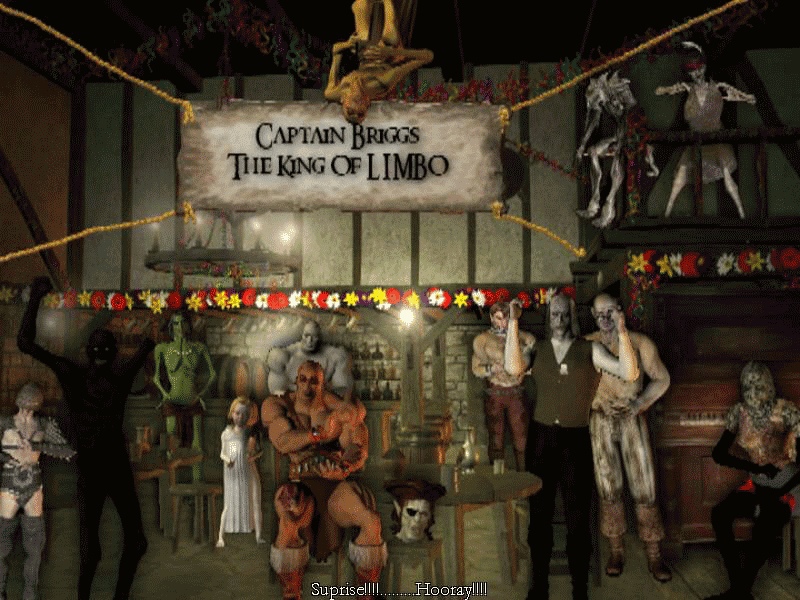
OH HOLY FUCK, NO!!!!



Okay, enough fooling around. Limbo is what you would get if you took all the Inner Planes, stuffed them in a jar, and mixed them together together into one sloppy mess with a bunch of acid dropping toads mixed in for good measure. Everything on Limbo just sort of floats around as a messy primordial soup. Luckily, Limbo is very responsive to the whims of travellers. So long as they are conscious, travellers can shape their immediate surroundings so that it doesn’t kill them. Once a traveller imposes his will, only naturally occurring forms take place. These are still chaotic as hell, but at least they are usable. Of course this means you can’t go to sleep (although setting watches is nothing new to most adventure parties). Natives don’t have this problem, assuming they don’t just swim through the elemental soup. Petitioners are just as subject to the constant flux of the plane as well. Their attitude is to just roll with it. Not surprisingly, the Xaositects love this place.
Limbo’s structure can best be described as “whatever it feels like at the moment.” Sometimes it has layers. Sometimes it doesn’t. It’s probably easiest to describe the place assuming there are no layers, because even when they are there, it’s impossible to tell the difference between them. The Githerzai are natives of Limbo, and they maintain a great city amidst the chaos. The other inhabitants of note are the Slaad. Slaad are large, bipedal, crazy-as-fuck toads. They are totally awesome, and those who disagree are a bunch of lawful-aligned pansies. We’ll be seeing more of the slaad throughout the source books.
Casting magic on Limbo is pretty problematic. A wizard has to make an Intelligence Check (roll d20 equal or under Int score. On a failure, the spell fizzles. If the wizard rolls a 20, then the spell surges as per the wild magic rules in Tome of Magic .
A bunch of powers make their homes in Limbo, including Agni, Fenmarel, Mestarine, Indra, and Susano-O. Campaign-specific powers are Sirrion (Dragonlance) and Tempus (Forgotten Realms).
Mechanus - The Grognard’s Paradise (Lawful Neutral)
Mechanus is also called Nirvana by primes who’ve obviously never visited the place. This plane is made entirely out of gears. Some are normal size, while others are the size of continents and worlds. Petitioners here are single-minded to a fault, interpreting any instructions literally. Everything here works as a single machine, with no deviation.
Most of the time, at least.
Mechanus doesn’t have “layers” per say. Instead, a single massive gear or a grouping of gears will share a set of common properties and inhabitants. The largest of these is Regulus, the home of the modron. The modron are led by Primus, who is sorta like a Power except he doesn’t have all the characteristics (namely he isn’t reliant on worshippers to sustain him, or so it would appear). Modron can be found throughout Mechanus, though it is here that they are most numerous.
Another gear is occupied by Anu, a Babylonian god. His disk is 500 miles across. Anu is the head god of the Babylonian Pantheon, though most of the gods have homes elsewhere.
The other big Pantheon to make its home here is the Chinese Pantheon. The Jade Palace is the home of Shang-ti, the Celestial Emperor. The best way to describe his realm is to take Beijing’s Forbidden Palace and expand it to the size of a continent. Like the historical chinese dynasties, Shang-ti presides over a vast bureaucracy. One notable commodity here are the peaches of immortality protected by foo dogs. The fruit extends the lifespan of those who consume them by 100 years. The Jade Palace also maintains a Great Library which stores all the knowledge gathered from the Prime Material worlds on which the Chinese Pantheon is present.
Other deities who maintain realms here are the Indian deities Varuna, Rudra, and Yama. In addition, the Fraternity of Order has a stronghold called The Fortress of Disciplined Enlightenment.
Gravity is always in the direction of the surface immediately below a traveller. Usually this will be whatever face of a cog he is on. Illusion and Phantasm magic automatically fail on this Plane. Wild Magic is impossible here as well. Marut are another inhabitant of this plane, as is the Egyptian God Horus. Helm and Mystra of the Forgotten Realms make their homes here.
Mount Celestia - Heaven could really use a stairway. (Lawful Good)
The Prime name for this Plane is the Seven Heavens. If you think that the Lawful Good alignment is the best alignment ever, then this is the Outer Plane for you. If you don’t, then I hope you enjoy dealing with smug, judgmental asshats, because that is what you’ll find here.
Mount Celestia is the biggest mountain in all the Multiverse. It stretches up seven layers, each bathed in the light of justice and mercy. The first layer is the base, rising out of an endless ocean. Neighboring layers can be seen from the one that you are currently on. You get to the next layer by climbing, but in order to complete the climb a traveller has to complete a series of challenges of a moral, philosophical, and/or spiritual nature. So if all one wants to do is ask a few questions of a deva that lives on the 5th layer, he should either find a quicker way to get there (*cough* Sigil) or be prepared to do an entire MMO’s worth of sidequests.
The petitioners of Mount Celestia are archons, a race of angels that are unique to Mount Celestia. They start off as lantern archons, who are still technically petitioners. Once they graduate to the next form (hound), they become planars.
The first layer is Luna, the Silver Heaven. Luna is a land of constant night, but this is a pleasant, moonlit summer night. Visitors arriving by Astral color gate or Celestia’s gate-town on the Outlands are unceremoniously dumped into the Astral Sea, an Ocean that has all the properties of holy water (don’t worry, aquatic locals will make sure you don’t drawn as long as you aren’t evil). There are numerous cities and citadels that line the shore and go up the slopes. The largest of these is Heart’s Faith.
Mercuria, the Golden Heaven, is the second layer. The Dragon God Bahamut maintains his palace here, as do the Indian deities Vishnu and Surya. The layer has numerous armories and marshalling grounds, and this serves as a marshalling ground for the archon whenever someone needs to get their heads kicked in. For justice.
Venya, the Pearly Heaven, is the third layer. To halflings, it is also known as
The fourth layer is Solania, the Electrum Heaven. This layer is very rugged, with deep crevases and fast-moving rivers. Many monasteries are found here, including one to the Chinese God Kuan Yin. Solania is also home to the realm of Moradin Dwarffather and a good number of the Dorf gods. The realm of Moradin also houses the Soul Forge.
Mertion, the Platinum Heaven, is the fifth layer. The brilliant silver light here does 1d6 damage a round to all exposed Undead. Mertion is dominated by great plateaus, upon which are huge fortresses. These are the homes of archons that had been paladins in their mortal life.
Jovar, the Glittering Heaven, is the sixth layer and the last one that anything for certain is known. This is Celestia’s peak (even though we have one more layer), upon which the archon reside in a great city. At the center of this city is a ziggurat which leads to the final layer. The leaders of the archon rule from this palace.
The only thing known about the final layer, Chronias (the Glittering Heaven) is from conjecture. What may be true and what may be just B.S. is impossible to say. Less is known about Chronias than even Nessus.
On Mount Celestia, Wild Magic is diminished. Besides the archon, Mount Celestia is also home to a number of aasimon, noctral, and zoveri. The Chinese power Chung Kuel makes his home here. Moradin lives with his wife, the Goddess Berronar Truesilver, and Avoreen and Cyrrollalee live with Yondalla in Green Fields. Paladine of Dragonlance lives here, and Tyr operates his Forgotten Realms franchise from Mount Celestia.
Outlands - The Plane of Not Appearing In This Book (True Neutral)
The Outlands are covered in the third booklet in the box set, Sigil and Beyond
Pandemonium - The real Bat Country (Chaotic Evil Neutral)
Pandemonium is the plane of madness. It is a series of winding caverns and tunnels filled with howling winds and gales. These winds will inevitably drive you insane, whether native or visitor. The Bleak Cabal decided that this would be a nice place to set up shop. There is no natural light here-you have to bring your own, preferably something that isn’t going to get blown out.
The first layer is Pandesmos, and it’s the most inhabited of the layers. Though that really isn’t saying much to be honest. Pandesmos is where the headwaters of the River Styx is located. The next layer, Cocytus, has smaller tunnels and stronger, louder winds. Here, the tunnels look as though they were made by hand, although by whom remains unknown. The madness-inducing winds are even stronger here, and this layer is sometimes called “the layer of lamentation.”
Phlegethon is the third layer. Unlike the other layers, gravity here has a single direction. This has led to the formation of great stalagmites and stalagtites. Here, very rock absorbs light and heat, hampering all visibility. The final layer is Agathion. There are no interconnecting tunnels, just a series of small, sealed holes that contain Powers-knows what.
Save for the third layer, gravity is directed towards whatever surface you are closest to. There’s also constant winds. Sometimes they are small, only barely heard (like a maddening thought in your head). Other time they have the strength of a tornado. In either case, such winds will drive both the locals and anyone who stays too long insane. The winds also play havoc with material components for spells, and even speaking and making gestures become an issue if the winds are strong enough. Wild magic is enhanced on this plane.
There are no native creatures here, though you will find various refugees from across creation that were unlucky enough to come here. The Norse God Loki maintains a hideout in Pandemonium. The Gnoll God Gorelikk, the Bugbear God Hruggek, and the Fairy Power known as the Queen of Air and Darkness reside here. Zeboim of Dragonlance and Talos and Auril of Forgotten Realms are also residents of Pandemonium.
Ysgard -
 (Chaotic Good Neutral)
(Chaotic Good Neutral)
Ysgard is also known as Gladsheim by the primes. Ysgard is made up of great rivers of earth flowing through the sky. Many of these chunks of earth are the size of continents. The underside of these “earthbergs” glow with a red light visible from above. These bergs rumble from grinding against one another.
The Plane is home to the Norse Pantheon, who set the standard for how everyone else should act. The petitioners of this Plane want to fight all the time, with no holds barred. That’s because after a day’s fighting, everyone that got killed pops back into the mead halls of the Plane, ready to booze and feast with those he fought alongside and against. The next day, they do it all again. Unfortunately, they forget that visitors they fight with don’t get this particular benefit. The Fated like this place, probably because its the best spot to live out their Randian fantasies or something.
Ysgard shares its name with its topmost layer. The Norse gods maintain their primary residence here. This is also where the main trunk of Yggdrasil is located. In addition, the Norse control a rainbow bridge named Bifrost that reaches into the Prime Material. Basically, if it was mentioned in Norse Mythology, for the most part it’s located here.
The second layer is Muspelheim. Here, the earthbergs float with their fiery side up. Fire Giants live here for the most part. Lastly, there is Nidavellir. Here, the rivers are so dense that they are more like tunnels illuminated by the fires of passing bergs. Such tunnels are constantly shifting. Nidavellir is home to chaotic-aligned dwarf and gnome petitioners, as well as Drizzt clones.
Travellers need to find a way to deal with constant earthquakes, as well as how to cross between seperated earth bergs. Wild magic is enhanced on this plane. Ysgard is home to foo creatures, holyphants, and planatars. The Egyptian god Bast is located here, as is Branchala of Dragonlance and Selune of Forgotten Realms.
And there you have it: our first look at the Outer Planes!
Next Time: Sigil and Beyond. First, though, I need a break.

Sigil and Beyond - Intro
Original SA post Sigil and Beyond - Intro“Her Honour Rastina Tollin of the Guvners” posted:
We can forgive the fact that you killed two yugoloths before you realized where you were, Outsider. But you pronounced the name of our fair city ‘Sijil,’ not ‘Sigil,’ and there can be no excuse for that!
While the Player’s guide provided what you need to know to create PCs in Planescape, and the [/i]DM’s Guide[/i] gives the DM the basic rules he needs to know as well as the barest of summary of what is part of the Planescape setting, Sigil and Beyond provides the DM with the tools and details needed to begin a Planescape campaign. Like most of the TSR settings you’ll need to buy additional material to get the most out of the setting. But to it’s credit, Planescape is so goddamn huge (no pun intended) that you can focus on one portion of the setting and make a complete campaign out of it.
The introduction deals with what a DM needs to do to take full advantage of the Planescape setting. Overall, it’s some pretty decent advice, though it probably ought to have added a line about talking with the players before starting a game for it to be GREAT advice. The first thing it does is to warn the DM against simply throwing the players at the toughest blokes in the Multiverse. Given both the power and the resources they have at their disposals, its not at all plausible for the players to defeat them on their home turf (remember, they have access to all the cheesy rules the players do, and have far greater amount of time to put them into effect as well as the resources to properly implement them. While such an adventure my be well remembered, it’s not going to be fun.
The first thing a DM needs to establish is what the point of the campaign is going to be. The book goes through a few possibilities: Gold and Glory, Sense of Wonder, and Long-term Objectives are presented as commonly thought-of reasons to adventure. While these certainly are necessary components for an adventure, they aren’t the reason why to go on the adventure in the first place, the reason why the players should care in the first place. For that, you need a theme.
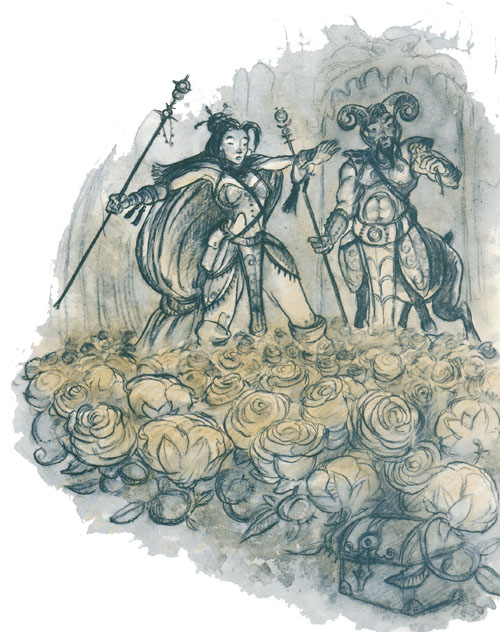
The theme of an adventure or any story dictates the placement and structure of everything from the broadest concept to the slightest detail. With a good theme, players will stop seeing their characters as a collection of stats and begin to care about the world around them.
The average DM, of course, is probably as skilled at establishing a consistent theme as your average fanfiction.net author. Luckily, Planescape has a readily established theme that is carried over through its entire design-the struggle of ideas, philosophy, and beliefs. Sure, the Harmonium and the Bleakers may be butting heads because there are tangible benefits to one belief set prevailing over the other, but what those beliefs actually are are just as real in our world intangibly. Players can sympathise with the Bleak Cabal because chances are they too have wondered whether there is any sense to their life. And their frustration at a Hardhead sergeant can be all the more real if they’ve had to work under a supervisor that has just the same attitude. This can be far easier to relate to than trying to get engaged in an apocalyptic war between the Skyfappers and the Lot’s’Apos’stor’phs due to a grammerical error one of their ancestors made.
It’s here that Sigil and Beyond elaborates on the true point of the Blood War. It’s not just about pure genocide for the hell of it. Each side wants their interpretation of evil and nastiness to prevail over all the Lower Planes. In the same sense, the conflict between the Factions is about establishing a dominant set of beliefs in Sigil, which would in turn whisk it off to a Plane where the winning Faction can take control of it. And into these clash of ideas, go the Player Characters. Players can alter the very landscape not through conquest or magic, but by convincing others of their beliefs. It’s this physical clash of ideas that leads to the description of Factions as “Philosophers with Clubs.”
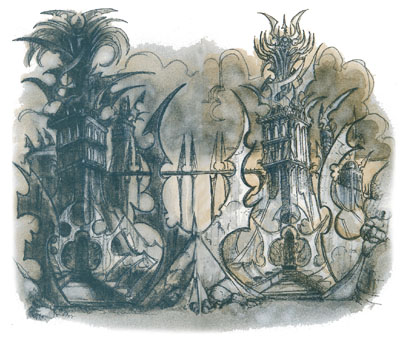
So the ideal theme for a Planescape campaign, and one that the material to follow builds on, is that the beliefs of Player Characters can make a real difference - and that their actions can advance or halt the spread of one set of beliefs over the other”. One little problem, of course, is that much of this is still defined by the stupid alignment axis, rather than more explicit philosophies. (How does one promote the power of Bytopia, by making places more boring?) Still, the theme is perhaps one of the most unique aspects about the Planescape setting, and is what truly makes it a memorable campaign, not the chance to share a drink with Thor or punch Orcus in the face.
One thing that the book makes sure to emphasize is that good Powers are just as likely to get pushy and intrusive as evil ones. The design of the Harmonium is meant to drive this point home. For the most part, they’re Lawful Good, but judged by their behavior they’re pretty much the gestapo. The most noticeable way change is effected is for a village or town to slip between one Plane and another. By getting the inhabitants of a settlement in Carceri to stop being a bunch of lying assholes, you can actually force it to shift into the Outlands. Or you can blast Linkin Park music at the settlement until it shifts into the Grey Wastes. The possibilities are endless. The book makes sure to mention to vary it up a bit. While immersing your players in philosophical battles is all well and good, be sure to mix in a few ‘Smash-and-loot’ sessions just to mix things up a bit.
The Planescape setting has sort of a natural scale of progression to it as your characters advance through the levels, depending on how dangerous individual locations are. For level 1-3, players should be spending most of the time in Sigil, taking brief trips to the safer locations out in the Planes. At level 4-7, extended exploration of the Outlands becomes feasible-they may even set up a permanent outpost there. It’s at this point that players should be exploring their relationship to their Faction’s ideals-how dedicated they are to them, etc. By 8th level, players will be ready to explore the rest of the Planes, and the DM is encouraged to give more of the structuring of future adventures in the hands of the players - after all, they’re at a point that they can decide on where to go. At level 11 and beyond, the possibilities for players in Planescape is pretty much left to their imagination, both in terms of where they can go and how much influence they may be able to exert.
The last section of the chapter addresses dealing with problems that are specific to Planescape. One of them is getting a grip on the shear size of the Multiverse. This part emphasises that until the higher levels, the DM has full control of where in the Planes they’re allowed to go-if a DM isn’t ready for them to take a jaunt down to Stygia, don’t provide them with a portal to Stygia, and so on. By the same token, a DM’s control should be used to bypass the incredible distances that can arise on the setting. The second issue that’s addressed is making sure players understand the theme of Planescape. Here it gives some really pro advice about getting a player to think about the choices he made regarding race, class, alignment, and faction, and coming up with what it all means.
A final word is given to dissuade using Planescape as a place for murdering its inhabitants. Certainly, that can be a use of the place, but it’s not really taking full advantage of what’s being offered. This section emphasizes that beyond raw stats, when fiends, celestials, and powers are fighting on their home plane, their greatest advantage is resources. So while the Archfiend Mephistopheles could try to go toe to toe with the players, its more likely that he’ll just sic hundreds of pit fiends and gelugons on them and get on with something more important. When dealing with higher-ups in the setting, you should encourage players to come up with creative solutions. If all else fails, just have their intended targets leave until they think of a better approach.
”Nohut, a Xaositect at the trial of his friend” posted:
They’re gonna give him the rope if he don’t pay the music - well, actually they won’t give him the rope; they’ll put it around his neck - except he’s got no neck, so they might just have to give him the rope instead - what kind of music was he listening to, anyways?
Next Time: The Lay of the Land-What is it that would motivate someone to be Neutral?
Sigil and Beyond - The Way of the Land
Original SA post
Been a while since my last update, but there are so many time-wasters and so few hours in a day

Sigil and Beyond - The Way of the Land
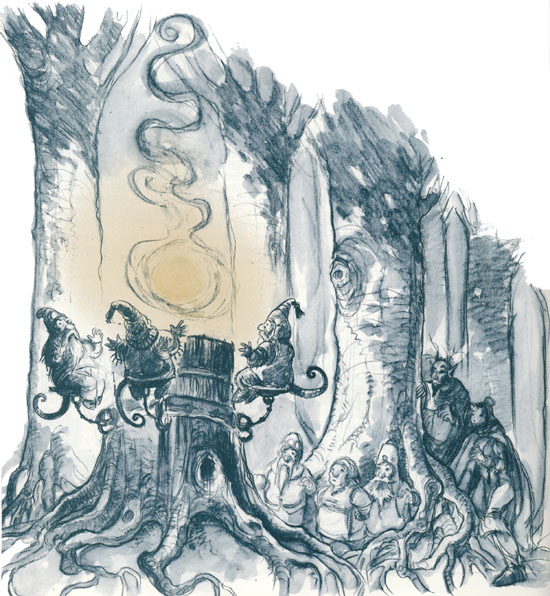
The most detailed of the Outer Planes in the campaign boxset is the Outlands, which was named “Plane of Concordant Opposition” by Gygax. The reason the Outlands get this attention is because it is probably the most similar to what a normal prime world would be like, at least compared to the other Outer Planes. The land itself isn’t trying to kill you, there’s no bizarre or supersized geography, and there aren’t roving armies of fiends killing everything in their paths. If the Planes of the Great Ring can be thought of as nations (work with me), then the Outlands are the free marches, a neutral zone wilderness that each nation seeks to gain influence over.
At the center of the Outlands is an impossibly tall and wide column of impenetrable rock known as the Spire. The spire is visible from anywhere in the Outlands. Although it appears to have a visible terminus, the Spire is in fact infinitely tall-even if you could climb it, you’d never get to the top. Floating above the Spire is an open torus that most folks believe to be Sigil seen from the outside. No one knows for sure, though, because walking into Sigil is impossible. A visitor has to use one of its portals to get in.
The area around the Spire is a magical dead zone. Here, not even the powers of the gods can operate. For this reason, the Spire is the place where various deities of different pantheons will meet to discuss important matters and make and renew agreements (they still have their physical prowess, so it’s still not a good idea to mess with them here). As you move further away from the Spire, magic gradually returns to normal effectiveness. What this means mechanics-wise is that there are 10 more-or-less concentric invisible circles that each allow only a certain level of magic to be used (including priests and items). At the innermost circle, no magic works (including items and even major artifacts). Moving to the next circle, level 1 spells become available. At the third innermost circle, level 1 and 2 spells are available, and so on.
As you move away from the Spire, the Outlands begin to take on the features of the spot on the Great Ring you are moving towards. For the most part, this shift is only in the most broadest of terms. The lands leading up to the Upper Planes are more fertile and biodiverse than the lands leading up to the Lower Planes. The terrain approaching the Planes of Law is regular, while the terrain approaching the Planes of Chaos is erratic.
At the edge of the Outlands are 16 gates that connect the Outlands to each of the Planes of the Great Ring. Their locations relative to each other correspond to the ‘spot’ on the alignment axis of the Plane it is connecting to. Thus, the gate leading to Mount Celestia is closest to the gates leading to Arcadia and Bytopia (although travel by land is still weeks). Around each town are communities that are known as “gate towns.” Gate towns take on many of the characteristics of the Plane their gate connects to. In fact, it’s at these gate towns that the relationship between belief and reality is the most readily apparent. As soon as enough of the locals have beliefs that match up with the bordering Plane, the entire town shifts over to the Great Ring on the Plane its gate had led to. Depending on the Plane and the goals of individual locals, this can either be a good development or a bad one. That last point is important-there are always some folks who want the town to shift over, and ones that don’t. The fate of an individual gate town is probably the earliest that players can play at influencing beliefs to produce real, tangible results.
If a gate town does shift over, the gate that it was formed around will re-appear in roughly the same spot, but a bit closer to the spire. Technically, it’s possible for towns to shift the other way, but this is a rarer occurrence. Whether this slow encroachment by the Great Ring will eventually result in all the Outlands will be gobbled up is a matter of speculation (Sigil & Beyond states that this is what will happen, but later books will point out that nothing should be taken at face value, which is a neat way to give the okay to DMs to craft a Planescape campaign to their liking and (hopefully) their player’s liking.)
Unlike most other Outer Planes, there isn’t any really dominant pantheon or group of powerful planar beings that are going to regularly get in the face of players, so there is lots of opportunity for a party of adventurers to set up a base of operations that’s not caught up in the cut-throat politics of Sigil. That said, there are quite a number of divine realms in the Outlands, and players would be wise not to deliberately piss off the powers who live their.
Tir Na Og
The largest realm in the Outlands is Tir Na Og, the home to most of the powers of the Celtic Pantheon. The realm is made primarily of woods and villages where the petitioners live as the ‘historical’ celtic people did (in a general sense, not owing to historic changes over centuries and millennia. This is still D&D). Tir Na Og is divided into lesser areas that are dominated by a particular Celtic god and petitioners who worshipped him or her primarily in life. We will go over the Celtic powers (and the other pantheons) in a later supplement,
On Hallowed Ground.
The Norns
The Norns of Norse mythology live on the Outlands in a tiny but very powerful realm. The realm of the Norns can only be reached by “crossing a wilderness more savage than most,” though like all the Norse realms its reachable via Yggdrasil. Here the canopy is so thick that it’s pretty much a cavern. The Norns are huddled around the Well of Urd to read the fates of men and gods. The players can even come here and have their fates read, though doing so s described as bad business.
Sheela Peryroyl’s Realm
Sheela Peryroyl is one of the Halfling powers. Her realm is small, consisting of a single extensive orchard and a large halfling farm. Both are tended to by her petitioners. Her realm could probably be mistaken for Bag End aside from, you know, being the home of a god.
Dwarven Mountain
If Mount Clanggedin was like Dwarf Fortress at its most
 , then Dwarven Mountain is DF at its most
, then Dwarven Mountain is DF at its most
 . Dwarven Mountain is home to the Dwarf powers Dugmaren Brightmantle, Dumathoin, and Vergadain. The outer surface of the mountain is uninhabited, as befitting of dorfs. The halls and caverns closest to the peak are the domain of Vergadain and his petitioners. Vergadain is a god of wealth and luck, and so his realm consists of great gambling halls and treasure vaults. Beneath Vergadain’s domain is the home of Dugmaren and co. Dugmaren is a crafting go, so his domain is filled with smelters, forges, and furnaces, as well as libraries dedicated to iron crafting and metallurgy. The deepest tunnels are the domain of Dumathoin, the Dwarven mining god. His petitioners work day and night digging out ore, but since these petitioners are really crazy about ore in its natural state, little of what’s mined actually gets smelted. Dwarven Mountain even has Hidden Fun Stuff; the realms of two monstrous powers are adjacent to it, and a number of tunnels made by Dumatoin’s petitioners have broken into these deadly territories
. Dwarven Mountain is home to the Dwarf powers Dugmaren Brightmantle, Dumathoin, and Vergadain. The outer surface of the mountain is uninhabited, as befitting of dorfs. The halls and caverns closest to the peak are the domain of Vergadain and his petitioners. Vergadain is a god of wealth and luck, and so his realm consists of great gambling halls and treasure vaults. Beneath Vergadain’s domain is the home of Dugmaren and co. Dugmaren is a crafting go, so his domain is filled with smelters, forges, and furnaces, as well as libraries dedicated to iron crafting and metallurgy. The deepest tunnels are the domain of Dumathoin, the Dwarven mining god. His petitioners work day and night digging out ore, but since these petitioners are really crazy about ore in its natural state, little of what’s mined actually gets smelted. Dwarven Mountain even has Hidden Fun Stuff; the realms of two monstrous powers are adjacent to it, and a number of tunnels made by Dumatoin’s petitioners have broken into these deadly territories

Semuanya’s Bog
Semuanya is the god of the lizardmen. Her(?) realm is located adjacent to Tin Na Og, on the shores of one of its larger lakes (Tir fo Thuinn). As the name implies, the realm is a swamp, and the petitioners are all lizardmen. There’s usually nothing to be found here save folks looking to be left unbothered.
Gzemnid and Ilsensine’s Realm
These two powers share the same realm, despite their petitioners being of a much different nature. Gzemnid is a beholder deity, while Ilsensine is the god of illithids. About the only similarity is that they’re both monsters the DM sends at the players when he gets sick of their bullshit. There aren’t any settlements-a few beholders petitioners wonder around Gzemnid’s realm, and Ilsensine’s realm is deserted. Gzemnid’s home is riddled with mazes, illusions, and subtle charms. Ilsensine’s realm pulsates with raw psychic energy, and those who linger either get enthralled or driven insane. Rumor has it that a visitor can learn anything, but that means finding the illithid god and asking him (have fun with that!)
This dual realm is the first of a number that don’t seem like they’re located in the right spot on the Outer Planes; one would think that a god of mind flayers or beholders would be more at home in Baator. The reason given in this book for (Ilsensine at least) is that he’s conspiring against all the alignments. Eventually, a broader explanation is provided for all the powers, which basically goes that they aren’t straight-jacketed into living on a specific Plane (they’re Powers, alright?!)
Both of these realms are next to Dwarven Mountain, and have a strong export business of Hidden Fun Stuff.
The Palace of Judgment
The Palace of Judgment is the home of the chinese deity Yen-Wang-Yeh, Judge of the Ten Law Courts and king of the Eighteen Hells. His job is to determine where in the afterlife followers of the Chinese Pantheon go. This realm has conduits to all of the realms that are part of the pantheon, plus the prime worlds of the chinese gods are worshipped on. As a result, there are a lot more petitioners here than those who worshipped Yen-Wang-Yeh specifically. Those who are assigned to the Palace of Judgment serve as clerks and bureaucrats.
Tvashtri’s Workshop
The Workshop is another realm adjacent to Dwarven Mountain. Tvashtri is a god of invention and :science101:. His realm is appropriately a giant mad science lab, though ‘lab’ encompasses things like forges, armories, workshops and kitchens. Most of the petitioners here are amazingly NOT gnomes, but humans (there are still gnomes, of course). Tvashtri’s Workshop is the place to go when you need gear that’s not dependent on magic.
Thoth’s Estate
The Egyptian god Thoth makes him home in the Outlands along the River Ma’at, which rises out from Semuanya’s Bog. Along the river are crocodiles. At the center of the realm is Thebystes, the city of Thoth, which includes a Great Library that is yet another spot to find out anything you want. It’s not dangerous either, just good luck finding the right scroll. Petitioners here are a normal bunch.
The Hidden Realm
This is the home of a giant god named Annam. As it is hidden, there isn’t any hard facts known about it. Moving on.
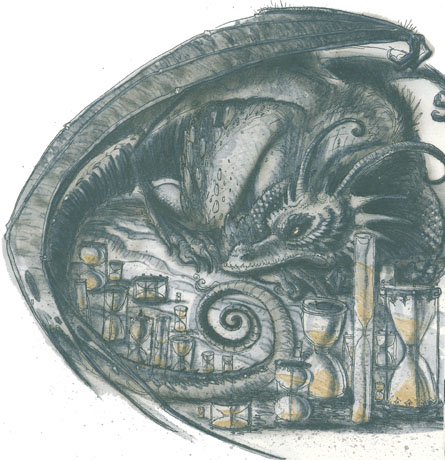
The Mausoleum of Chronepsis
This compact realm is home to Chronepsis, the dragon god of fate. His realm is located near Dwarven Mountain. He doesn’t have any petitioners, and basically sleeps all day while hourglasses counting down the lives of all the dragons and dragon-kin in the multiverse surround him.
The Court of Light
Located near the Palace of Judgment is the realm of Shekinester, the naga goddess. She’s unpredictable, having three distinct aspects that her realm could reflect - Weaver, Empowerer, and Preserver. What aspect is dominant can’t be predicted, so visitors come at their own peril. Petitioners may be eager to ‘initiate’ their guests in a mystery, which can be unpleasant. Planewalkers come here anyway, since those that survive gain unique advantages in getting shit done.
Petitioners of the Outlands
As befitting the Plane of True Neutral, petitioners here generally live their lives with a eye towards balance. Even those that live in the gate towns, and so influenced by the adjoining Outer Plane, this desire to achieve balance can override what their written ‘Alignment’ might suggest they do.
Outland Petitioners will help out adventurers, despite their Neutral Alignment. The catch, though, is that if he does something for you, then he’s going to do it for your ‘enemy’, which can be someone specifically opposed to you or someone whose objectives run counter to yours. This isn’t a literal rule, though, but one couched in alignment. If he does an act that favors good, evil, law or chaos, he’ll then go and do something supporting the opposite end of the axis.
This balancing by the petitioners might directly affect the folks they initially helped. Or they might unload it later. Anyone not a petitioner of this Plane won’t know. So the general advice is not to ask the locals to do anything really critical for you, because you don’t know if they’re going to stab you in the back later.
A second consequence out of this need to balance the alignments out is that petitioners will randomly do dickish things. To outsiders, this comes off as just being an arbitrary dick, but to Ouland petitioners, its all just part of balancing a previous discrepancy. So yeah, they’re being arbitrary dicks. (The opposite can happen as well, where petitioners will lend a hand when no one was expecting them too).
”Declaration of the Ring-Givers” posted:
Petitioners don’t care whether they’re killed in the name of the Blood War or in the name of justice. They’re just deaders.
Advice is offered to DM’s about how to roleplay Outland petitioners. One thing that it makes sure to mention is that a right level of neutral-dickery needs to be struck-too much or too little isn’t good. The thing the DM should strive for is to have players constantly guess whether dealing with a petitioner is worth it. And the DM needs to keep the ratio of random acts of kindness to asshole behavior at 1:1. But at the same time, it shouldn’t be a feature of every encounter with Outland petitioners. And of course, as often as not the aid or callousness of the petitioners can have nothing related to the adventure at hand.
Magic on the Outlands
The major rule of magic on the Outlands has already been discussed. One important fact not mentioned is that while Sigil is apparently at the center of the Outlands and thus in the middle of the magic dead-zone, inside Sigil, all magic works fine except magic that would transport the caster into or out of Sigil.
The Outlands have few spells that are specifically prohibited or diminished, but if a wizard needs to use one of those spells, then he needs a spell key. On the Outlands, spell keys work on the principle of balance: something must be exchanged, at least symbolically, for a spell to work. Use of a spell key adds one to the initiative rating of the spell. I won’t go over all the rules, but here are some of the more interesting ones:
To cast divinations to contact the Inner Planes, the caster must reveal a secret of his own to a native planar or petitioner. It doesn’t have to be a big secret, just something that no one else knows.
To cast elemental conjurations, the caster must cast a handful of the opposite element toward the target.
To cast shadow magic, the wizard must have a stone enchanted with either the continual light or continual darkess spell. Once cast, the stone disappears. In addition, the wizard must alternate what sort of enchanted stone is used with each casting.
Like spell keys, the powers of the Outer Planes can give power keys to priests they feel are worthy or in need of them. Such keys are usually going to enhance, reveal, or at least not harm the alignment balance that is ever-so important.
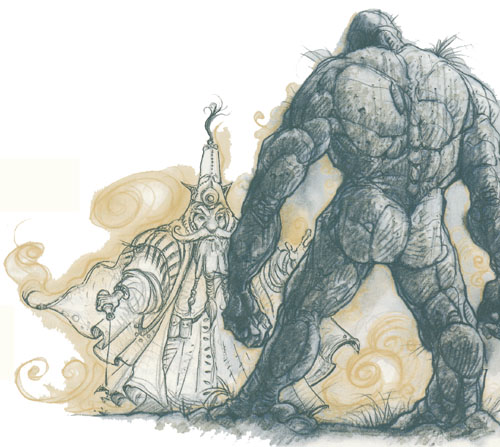
Next Time: Features of the Outlands-Walking Amongst the Gods for under 50gp a day
Sigil and Beyond - Features of the Outlands
Original SA post Features of the Outlands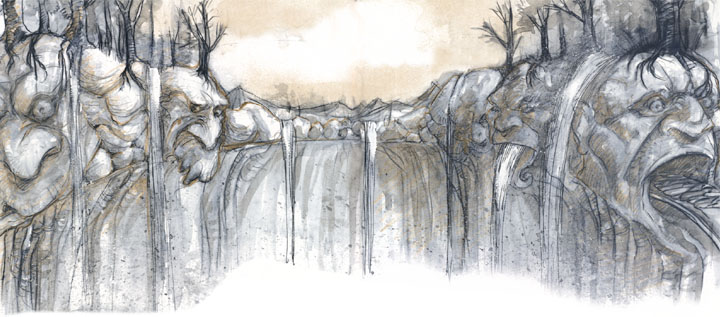
This chapter is different from the previous one, although both discuss what can be found in the Outlands. This is more specific in nature, and provides information that DMs would need for putting together their own adventures, although future supplements provide deeper and more comprehensive information.
This chapter sets up a couple of conventions that Planescapes sticks to when describing people or locales. For individuals, 5 stats are given to set the broad parameters of the NPC. The first point is the origin - an NPC is either a prime, planar, petitioner, proxy or power. This like race, gender, class and level (if any), alignment, and faction (if any) are established using abbreviations to minimize the required space.
There are two different types of locales within a plane or layer. First are divine realms. The first thing described is the ‘character’ of the place, which is basically everything that’s commonly known. The power(s) that inhabit the realm are named, as well as what D&D supplement further details about them and their specialty priests are found (usually either Legends & Lore or Monstrous Mythology ). Any principal towns are named, and the special conditions within each realm are detailed. A further description of what can be found in the layer is given, plus any principal NPCs the players may interact with, and what sort of services he may find.
In addition, there are important towns on the Planes that are separate from any realm. Like the entries on realms, town entries begin with a description of the publicly known character. It then describes who the official ruler is, as well as any behind the scenes sources of influence (though sometimes this is nothing more than the Plane driving everyone batty). The description of the towns is more detailed than those of realms, as there is less to go over. A description of the local militia is provided (The tendency of PCs running afoul of local authorities being a common theme in any game), a description of services available, and finally rumors that the DM can use as adventure seeds.
With that out of the way, let’s talk about (some of) the places a planewalker might be inclined to visit:
Automata
Automata is the gate town bridging the Outlands with Mechanus. First impressions of the burg is that it’s a flawless reflection of the Plane it links to. The town is laid out to look like a cog, and the 3 person Council of Order has made laws for everything. What people who don’t live here might not know is that there is a substantial criminal element here that takes over the town at night, with a similarly staffed Council of Anarchy. This underground is somewhat literal too, as a confusing network of tunnels have been dug out beneath the town. While not exactly chaotic, they keep Automata anchored in the Outlands.
The above-ground militia is very orderly and patrols the streets during the day. The underground ‘militia,’ is really more concerned with collecting protection money. In addition, anything that would be of interest to adventurers is probably located in the under-city, though this will involve paying off the right people (Planescape is in the habit of reminding players that inhabitants of the Planes are always looking for what they might get out of a deal. It gets sorta repetitive in places). The adventure seed given at the end relates to a strange hill that just appeared outside Automata a week ago.
Important figures in Automata include the Council of Order: Captain Arstemis, a githzerai Harmonium fighter who leads the town guard; Pelnis the Clockworker, a level 0 human petitioner who represents the craftsmen; and Serafil, a tiefling specialty priestess of Kei Lung who represents the temples in town (her faction is the Fraternity of Order). Their opposites on the Council of Anarchy are Leggis Scrog, a Revolutionary League Githzerai fighter who represents the criminal; Ravis Corcuncewl, a human petitioner who represents the vagrant population; and Aurach the Fair, an erinyes who represents the fiends in town. The petitioner Tourlac the Halfling runs the best above ground in in Automata. The Dustman tiefling wizard Hokee Thridun trades in rare and exotic goods for a select clientele, and is willing to offer good money to deliver what he sells.
Bedlam
Bedlam is Outland’s gate town to Pandemonium. The town has a mix of sane people and folks who are completely nutter. Right now, the ‘barmies’ are winning, and if things keep up, Bedlam will slide into Pandemonium. The nominal ruler is an old wizard named Tharick Bleakshadow with a habit of blowing up random buildings. The real reason that the crazies are winning is a shadow fiend named Hrava. Hrava hides in the shadows and whispers advice to the poor saps under his sway. Hrava seeks to eventually take over the town for his own personal dominion.
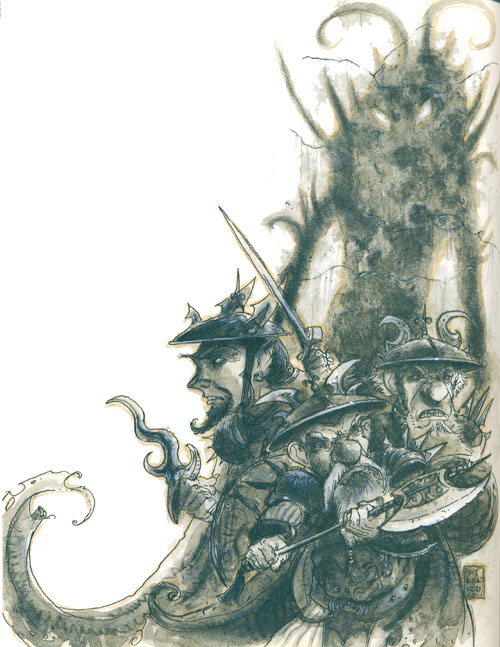
Bedlam’s layout is that of a great fan coming out from a hill. The gate to Pandemonium is at the base of the hill, and all the crazies prefer to live close to it. Here, the city looks like a cross between Beirut in the 80’s crossed with American McGee’s Alice . As you move away from the gate, buildings actually look habitable. At the city’s edge is a walled-off enclave called the Citadel, and it’s here that visitors are most likely to find someone not out of their minds. There isn’t much here in the way of an organized militia, although the Citadel does have an organized watch.
Bedlam attracts a number of artists to it, who are seeking inspiration. Planescape generally associates chaotic alignment with art. While it doesn’t make much sense on close inspection, Placescape is at least consistent with this idea-even the Tanar’ri appreciate and create art (although what they consider good art is best left unsaid). Speaking of which-the plot hook provided concerns a minor Tanar’ri captain attacking Bedlam from the gate to Pandamonium in a poorly thought out plan to flank the baatezu.
Besides Bleakshadow and Hrava, other important figures in Bedlam include the leader of the Citadel’s guard force, a Transcendent Order bariaur fighter named Erigyl Verrith; Thoa, a level 0 petitioner leading a ragtag militia that’s completely out of its depth; a dwarven petitioner named Pockmarked Weylund runs a relatively quiet inn close to the gate that’s popular with the artistic crowd. An Anarchist tiefling named Grist runs another inn, though this one is favored by fiends and those that do business with them. The Citadel has it’s own lodging called The Sanatorium , run by a Signer bariaur priestess of Shekinester named Althax Darkfleece, and she also offers treatment for mental imbalances.
The Caverns of Thought
This is probably the deadliest location that’s included in Sigil and Beyond . It is the home of the illithid god Ilsensine, and those that arrive are under constant psychic attack the minute they arrive. There are very few good reasons to ever come here-the DM should have a well thought out reason why he’d make the players go all the way here. There are no towns in this layer, just miles of tunnels through slick, pulsating rock. Visitors to this realm who are not illithids themselves must make regular saves vs paralyzation or lose a point of intelligence. The frequency of these checks depends on how deep a player is in the realm, from once a day at the realm’s edge to once per round within Ilsensine’s own court. Anyone that drops to zero intelligence becomes a psionic zombie that can be used to channel Ilsensine’s psionic attacks (though this destroys the zombie). These zombies are the realms only other inhabitants aside from the god himself.
Unfortunately, the only thing worth coming to the Caverns of Thought for is at the center of the realm. As a giant god brain, Ilsensine pretty much knows everything. So if the PCs have a question, than Ilsensine has the answer. Of course, simply getting to him to ask the question isn’t enough-Ilsensine requires those seeking his aid to give up a part of their mind, which could result in proficiency loss. This is in addition to whatever intelligence that was lost on the way to see him.
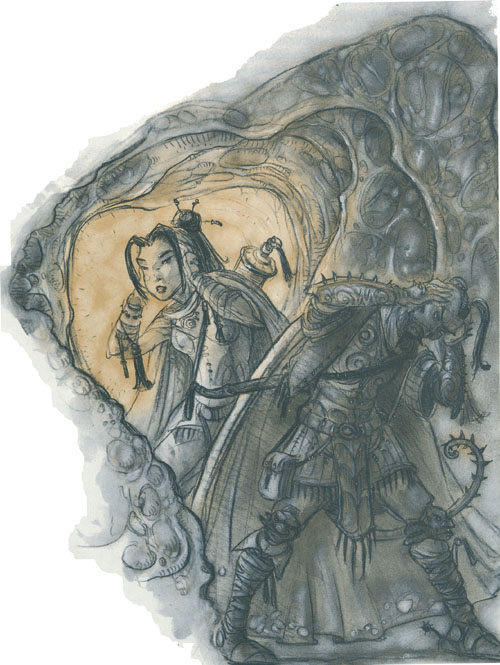
Given the high price PCs will pay for even the shortest visits, as well as the myriad of other ways to acquire information, making a trip to meek Ilsensine should be a last resort.
"Harmonium Rule posted:
There are two answers to every question: Ours, and the wrong one.
The Court of Light
This realm is the home of Shiekenester, the Three-Faced Queen of the Naga. All visitors to her small realm get tested, whether they wanted to or not. There aren’t any petitioners that live wit Shiekenester, as her worshippers are reincarnated. The only other habitation are a scattering of nests around the Court that’s home to Shiekenester’ proxies.
The tests that Shiekenester puts visitors through are the main feature of this realm. Her tests can be either heavy-handed or subtle. All tests are of a moral nature, but have the nature to be deadly if a visitor is not careful.

There are three sections to the Court of Light nested within each other. The outermost layer is The Loom, a forest of thorns and paths that merge and split without discernible pattern. These paths change with each visit. The few petitioners here live in this section. The book plainly spells out that a DM can use this area to introduce adventure elements or plot points before revealing the way out or The Hall of Tests.
The Hall of Tests contains rooms that become the expectations and fears of those that enter them. The purpose of these rooms, as the name indicates, is to further test the visitor. The innermost chamber is the Court of Light itself. The central object of the Court is the Arching Flame, one of Shiekenester’s aspects. The room is full of undead that are feeding off the light given by the Flame (this also pacifies them). Characters that are exposed to the light must make a saving throw vs. death, with a -1 penalty each time they strayed from their alignment after entering the realm. Those who make the throw are healed and refreshed. Those who do not make the save get disintegrated. The healing is pretty comprehensive, removing curses, diseases, charms, and even granting atonement for crimes. Aside from the benefits of the Arching Flame, there’s no reason to come here.
Curst
Curst is the gate town to Carceri. Similar to the Plane it connects to, Curst is the home for folks with nowhere else to go in the Outlands. The master of the town is a githzerai necromancer named Tovus Giljaf. He used to be the factol of the Athar, but was cast out by his own followers because he was over-ambitious. He is biding his time and ‘planning’ to return to Sigil and get back at those that betrayed him. In fact, revenge is the main motivation of why people are here-every resident has a chip on his or her shoulder. Of course, most of the longtime residents here are just petty misanthropes, too bitter to forgive the crimes of the past but too fearful to enact anything significant.
At the center of the town is a four-pillared arch that is the gate to Carceri. The gate is wrapped in razorvine. Five main streets circle the gate, and there is a wall also covered in razorvine that keeps residents inside as much as it guards against attacks. Indeed, the guards at the gate are unconcerned about who comes into Curst, but anyone leaving is required to state their reasons for doing so as well as proof that they can.
Curst does not suffer from fiendish incursions like the other gate towns to the Lower Planes. On the whole, this town is fairly well rooted to the Outlands, as there are enough folks here haven’t given up hope of forgiveness.
The Wall Watch is responsible for keeping peace in town. They are led by a disposed lord from a prime world named Baron Yurel Zarnthaskar, who has become a member of the Fated. The adventure seed provided is that he’s finally got enough men to regain his fiefdom, and all he needs now is a wizard to open a gateway (as well as stick around to assist with the revenge work that follows).
With so many bashers here focused on revenge, Curst is a good place to find mercenaries as long as you’re not looking for someone especially loyal. The best place get recruits is an alehouse called the Quartered Man , run by a Dustman thief named Abascis the Sweaty who had to get the fuck out of Sigil after he swindled the Factol of the Mercykillers. There’s also a gnome prime here named Brasicol who specializes in selling and making traps and other unusual instruments of death. He’s got a bunch of enemies back on his homeworld and will do a free job for any wizard that will open a gate back there for him to send a gift through. Finally, thanks to the sheer amount of razorvine, Crust is the place to purchase heartwine an expensive alcoholic beveage that’s made from the stuff. The secret to making it is kept by two elven wizards from the primes who belong to the Society of Sensation.
The Dwarven Mountain
As mentioned earlier, Dwarven Mountain is home to three of the neutral powers in Dwarven Pantheon: Vergadain, the god of wealth and luck; Dugmaren Brightmantle, the god of invention and discovery; and Dumathoin, god of mines and exploration. Each power controls about a third of the realm and its petitioners, each domain reflecting the traits of its deity.
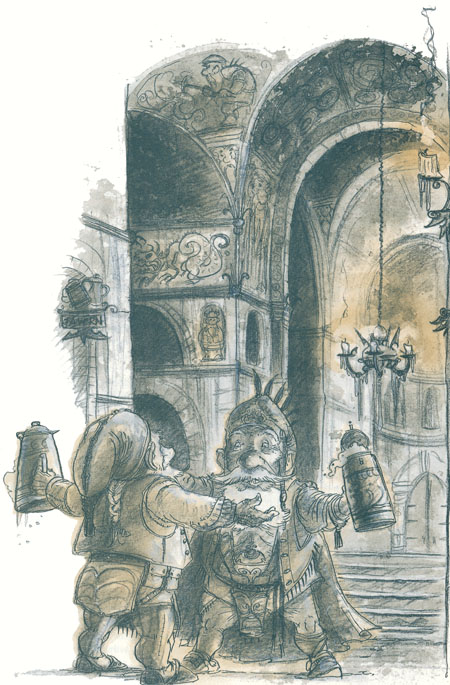
The exterior of Dwarven Mountain is uninhabited save for a single human hamlet called Ironridge that sits at the entrance to Vergadain’s realm. Beneath the surface, there are three important dwarf halls. Strongale Hall is known far and wide for gambling and drinking. You’re allowed to use anything you have to bet with, even stuff you’re not usually able to part with. Of course, there’s always a way to collect if you lose... Soot Hall is filled with workshops and libraries, and work here is non-stop. The best products made here are exceptional (and even magical) hammers and breastplates that often wind up getting bet on in the halls of Bergadain’s domain.
Finally, there’s Deepshaft Hall. The air here is cold and smells of dwarf-funk. It doesn’t get many visitors, and those that do come need to have a good reason, because getting lost here pretty easy. The ore and gems get sent up to Soot Hall and other halls dedicated to Brightmantle, although some of it gets traded with Ironridge.
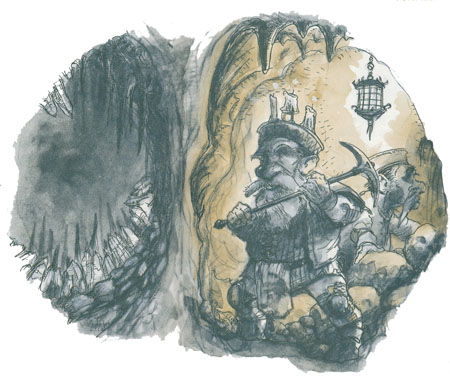
The petitioners here are, of course, dwarves, and they tend to act at the very height of
 (in fact, it’s kinda amazing how much I’m reminded of Dwarf Fortress considering that it wasn’t released until, what, 2004?). Each domain of the realm has their own special rules. In Vergadain’s realm, cheating at gambling is a capital offense, and those caught are put to death with no chance for appeal. The halls of Brightmantle requires people who come to have a skill. Anyone without a skill (like worthless nobles) will get sent to enjoy the Hidden Fun Stuff of the Caverns of Thought. For the mines of Dumathoin, visitors are not allowed to touch the gems. Doing so ruins their purity, which makes the miner-petitioners very mad (said petitioners typically have pickaxes which work well as makeshift weapons).
(in fact, it’s kinda amazing how much I’m reminded of Dwarf Fortress considering that it wasn’t released until, what, 2004?). Each domain of the realm has their own special rules. In Vergadain’s realm, cheating at gambling is a capital offense, and those caught are put to death with no chance for appeal. The halls of Brightmantle requires people who come to have a skill. Anyone without a skill (like worthless nobles) will get sent to enjoy the Hidden Fun Stuff of the Caverns of Thought. For the mines of Dumathoin, visitors are not allowed to touch the gems. Doing so ruins their purity, which makes the miner-petitioners very mad (said petitioners typically have pickaxes which work well as makeshift weapons).
The halls of Dwarven Mountain are what you would expect them to look like: big, cavernous cathedrals of stone a la Khazad-Dum and Ironforge (although even bigger because its the Outer Planes). Each hall reflects the characteristics of the god they’re dedicated to. Vergadain’s halls are gaudy and bright, filled with all manners of gambling. The great thing about Vergadain’s realms is that there are no limits to how much (or even how little) you can gamble, and no how big your winnings are, the house will always pay. Those with luck on their side are not turned away, so long as they came about their luck honestly.
The halls of Brightmantle are dedicated to crafting and industry. The pace of work is breakneck, and operations never cease-Brightmantle gives his petitioners the endurance to work non-stop. Murals and carvings depict general industry and all the cool shit the dwarves have made over the eons. The petitioners of Dumathoin have left their halls undecorated, or indeed, done any work after mining out the area. If you travel the tunnels deep enough, you eventually stumble into Ilsensine’s realm. Hope you brought a guide.
Speaking of whom, the best guide in the realm is a dwarf Mercykiller named Sedus Backbreaker. He’ got the whole place mapped out in his head and can get you anywhere, though his fees are hefty (50gp a day, though he’s also a lvl 10 Fighter so he can act as more than a guide if needed).
Magic arms and armour from Dwarf Mountain are in high demand on the Outer Planes, since they only suffer a -1 penalty when taken to different Planes. The best source for weapons and ores is a sensate bariaur named Melias Fairherd, who operates out of Ironridge. Her prices, though, are always in the form of services, like bringing back a fiend’s skull. Of course, you could always deal directly with the petitioners, but they too usually want something done in return-specifically something that advances the interests of the Dwarf powers.
If the players try to welsh on their gambling debts, then they get to deal with one of Vergadain’s proxies: Lzuli Clearfacet, a 15HD einheriar who’s accompanied by a translator who has a special attack that erases all memorized spells and if attacked has at least one aasimon come to its aid. Best just pay the debt. When looking for tomes within Brightmantle’s domain, adventurers should consult the curator of the domain, a petitioner named Pyrus Chertchip. He’s not friendly to those who don’t worship dwarf gods however. There isn’t anyone really important in Dumathoin’s crib, although one poor petitioner (Steelblade) got dominated by Ilsensine and is now spying for the brain god. To date, Dumathoin either doesn’t know or doesn’t care.
Glorium
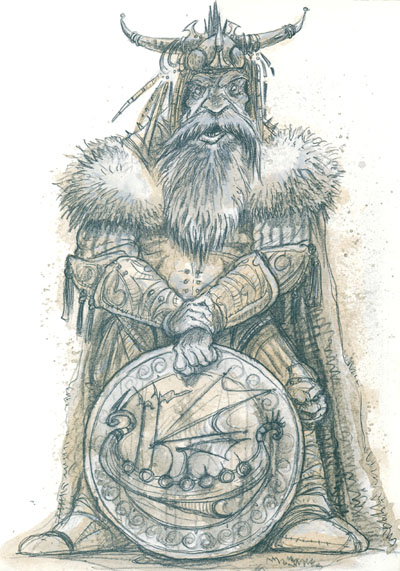
The gatetown to Ysgard is probably the most metal of the gatetowns. It’ basically a viking fortress complete with fjord, and the folks here eat courage and shit honor. The leader of this place is an Indep level 15 human ranger who tosses 50 lbs boulders for recreation. He’s not a dude that takes insults well, but he’s open to advice. His three usual advisors are his wife Kostbera and a gnome and halfling proxy who decided to settle down here (who they are proxies for isn’t mentioned). The town is pretty small, with only 300 inhabitants. It’s pretty isolated, with only a single trail through nearby mountains connecting it to the rest of the Outlands. The gates (Glorium has two gates) to Ysgard is pretty unique. The most well known gate is a maelstrom at the mouth of the fjord. To get to Ysgard, you need to sail into the maw of the maelstrom. This gate reverses its flow twice a day-traffic is one way depending on which direction the water is flowing. The second gate is in the nearby mountains, where one of Yggdrasil’s roots can be found. Unfortunately, this same cave network also connects to the realms of Ilsensine a Gzemnid.
Glorium sustains itself on hunting and fishing, with a bit of herding and farming mixed in. The community is insular, touchy, and very proud. They’re not as crazy as the petitioners of Ysgard, but they’re always up for challenging people that offend their senses to a non-fatal fight (they also do this when they’re bored). The town is on its way to becoming a part of Ysgard, but folks here seem to think that’s a good thing-afterall, it means they get the benefits of being a petitoner of Ysgard, which means more fighting

There’s not much in the way of a town watch, though everyone here is trained to fight, and in the event of attack they’ll come together under Grim’s command. Since everyone knows how to fight, Glorium’s a good place t find a hireling. A norse temple can be found at the edge of town. There’s nothing in the way of inns-adventurers that want to stay the night need to gain the good graces of one of the locals. The other service of note here are two shipwrights known as the Freki twins. Crafts they build have twice the sea-worthiness then normal models, but are 50% more expensive. The town’s adventure seed regards a possible invasion from Gzemnid’ realm.
Palace of Judgment
The home of the Chinese god Yen-Wang-Yeh, Illustrious Magistrate of the Dead, is the size of a small city, and has a number of features about it that theoretically make it as useful as Yggdrasil or Mount Olympus for getting around the Multiverse. This is where the souls of recently deceased followers of chinese gods first arrive on the Outer Planes, so portals to every Prime world with chinese worshippers can be found here. Once they arrive, Petitioners are judged as to what divine realm they get sent to and then are promptly shuffled to that location. Because the chinese powers are spread over many of the Outer Planes, it becomes a question of where one can’t go than where one can. Unfortunately, the place doesn’t take visitors save for one small colony outside the main gates called the “Place of Waiting.” Inside the walls, everything is controlled by a brutally efficient bureaucracy that demands strict protocols from those seeking their aid.
If you have a reason for being here, then you get assigned a chinese mythological creature to guide you to where you need to go (these are listed in the Kara-Tur Monstrous Compendium .) His job is as much to make sure you don’t wonder about as it is to get you to your location.
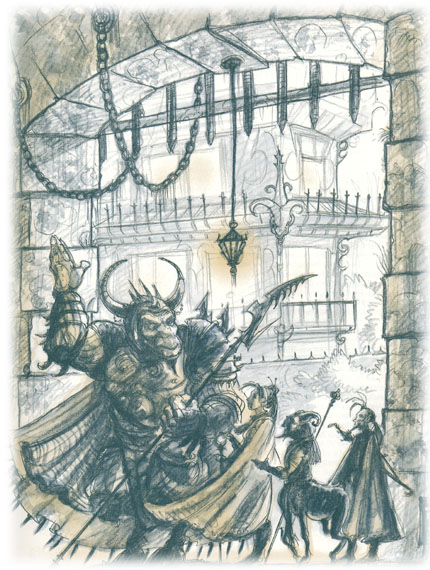
The actual judging of petitioners is handled by low-ranking proxies. Once judgment is passed, the petitioner gets passed down a bureaucratic chain until finally arriving at a waiting hall where they get passed through a conduit to their final destination. Each waiting hall has a representative or two from the Plane it’s connected to, so you’ll find fiends, aasimon, einheriar, and modron wandering about the Palace. None will break the peace, at least not overtly.
Once a year (Chinese year, I assume, though how years are kept track of on the Outer Planes in general is discussed in later supplements), Yen-Wang-Yeh leaves the palace to appear before the Celestial Emperor and report his progress. While he’s away, things get sloppy at the Palace of Judgment, and this can result in petitioners wandering about unsupervised or even getting assigned to the wrong Plane.
Slig the Cheapster on his daily run through the Hive posted:
Beat it, berk! There's a brace of hardheads coming this way, and any bubbers bobbing for ink'll be scragged!
Aside from the god himself, the most important figure here is the Chamberlain of the Interior Palace, General Pien. He’s a men-shen, which I’m guessing is a creature from the Kara-Tur MC. He’s honest, but he’s not direct about what he says. A stat block is provided for General Pien-I have no clue if he has any additional tricks owing to being Yen-Wang-Yeh’s second in command, though at the least he can probably zerg rush troublemakers with lots of oriental monsters. An example of one of the lower ranked individuals is provided, a proxy specialty priest named Pao who is a Secretary of the Third Rank.
Besides trying to use the conduits here to move from one Plane to another, one thing the Palace of Judgment has is a high volume of petitioners passing through it. Now petitioners don’t forget everything when they pass on, so if someone’s really patient, he can find the answer for an obscure question by canvassing the petitioners. It’s probably too much of a hassle, but it is possible.
Plague-Mort
Plague-Mort is a shithole, but then it is the gatetown to the Abyss, so that’s to be expected. The town is frequently swallowed up by the Abyss, but when the gate reappears the town that forms around it keeps the name. Plague-Mort is a collection of ruined buildings occupied by violent gangs. The one exceptin is the gaudy tower occupied by whoever can call himself ‘ruler’ and get away with it.The current violent warlord to control the town is a tiefling cleric name Byrri Yarmoril (despite being CE, he’s a member of the Mercykillers
 ). He’s incredibly paranoid, his dungeons filled with real and imagined conspirators. Byrri in turns answers to the tanar’ri on the other side of the gate, and expect Byrri to slide this Plague-Mort into the Abyss as well Byrri enforces his will with the help of a band of tieflings, cambions, and alu-fiends that can do whatever the fuck they want in town. Typically, their activites are of a violent nature.
). He’s incredibly paranoid, his dungeons filled with real and imagined conspirators. Byrri in turns answers to the tanar’ri on the other side of the gate, and expect Byrri to slide this Plague-Mort into the Abyss as well Byrri enforces his will with the help of a band of tieflings, cambions, and alu-fiends that can do whatever the fuck they want in town. Typically, their activites are of a violent nature.
Suprisingly, Plague-Mort does have something that makes it worth visiting aside from lots of dudes to kil. Unlike (most) of the Abyss, merchants are tolerated here so long as they grease the right palms. Merchants are grouped in a row of glittery shops called Merchant’s Row. Weapons sold here are of high quality and low prices. Other goods and services of dubious nature can be acquired hee. One such seller is Laran Susspurus, a tiefling Doomguard who sells poison, acids, and other chemicals. He also sells their antidotes at double the cost of the toxin they neutralize.
Even on the edge of the Abyss, a sod has to eat something. The best food are sausages sold by a Fated thief named Larissa (don’t ask how its made). And if you need a place to stay, the inn known as Eye of the Dragon , which is owned by drow bleaker named White Scar, a brooding type that collects ears.
The adventure seed is that a mercenary band of primes are in town and seem like they’re edging for a battle with Byrri and his gang. These primes seem to know what they’re doing. If the newcomer prevailed, he’ll be the first Outsider to lay claim to Plague-Mort.
Ribcage
Ribcage is the gatetown to Baator, and in my opinion the most interesting of the gatetowns in this book. It’s ruled by Lord Quentill Pracas, a tiefling fighter-wizard whose is a master politician in the same vein as Richard J. Daley. Nothing happens here without his say-so, and while there are elections for a council that shares power, the elections are basically a sham. But while Pracas is a lawful evil SOB, the one thing he wants to avoid is for Ribcage to fall into Baator. Once it does, then the baatezu take over the joint, and Pracas is out on his ass (assuming he even survives). As a consequence, agents and other representatives from Baator tend to have a short life expectancy here.
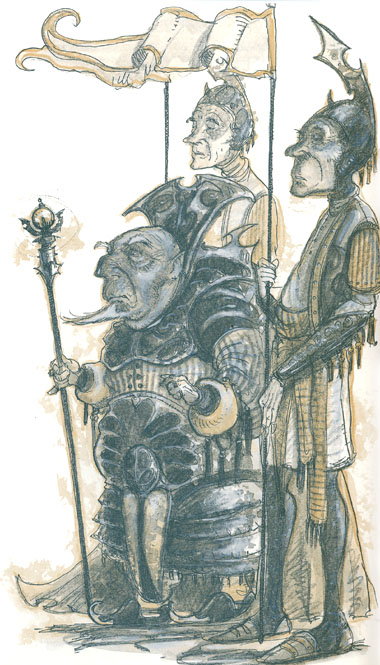
Ribcage is so named because of the ‘mountains’ which tower and curve over the city of 5,000. The militia here is huge, and could protect a city twice its size. Ribcage is actually pretty safe as long as you don’t break the law. If you do, you find out that Pracas has pretty broad view on what should be a Capital Offense. There are five sections of the city, each called wards, that are controlled by a powerful family that owes its fortune to Pracas in some manner. The rich are rich, the poor are poor, and the legal system is stacked to favor the former. Those in power do make an effort to temper their dickishness, though, thanks to Pracas’ goal of not getting his town pulled into the Abyss. The local militia is called the Blackguard, and they’re pretty brutal but can be bribed to leave you alone. Each of the major houses has their own militia as well.
One thing that the town does have in the way of tourist attractions are excellent hot baths just outside of town. These baths are operated by Shandrala, a tiefling priestess of Sung Chiang. She even has healing baths, which cost 1,000 gp. But there is probably a better reason to come to Ribcage: it has the best guides for getting around Baator, whether it’s an official visit or you need to sneak in. It’s expensive either way, but not having a guide in Baator is a surefire way to death and/or damnation.
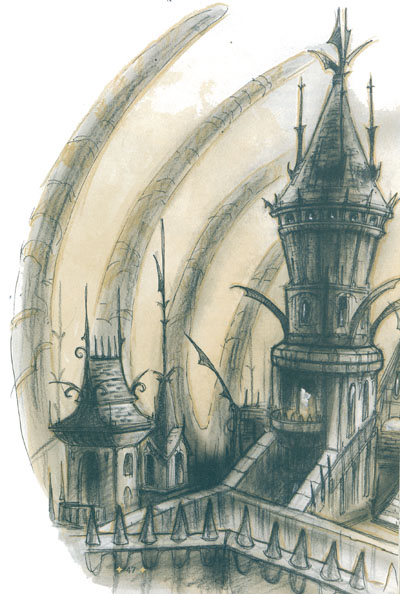
Two adventure seeds are included. One is in regards to power play being made by one of the major families against Pracas, and the other is with regards to a black statuette the baatezu and their agents are looking for.
Xaos (Axos, Sxoa, etc.)
The gatetown to Limbo is damn batty. The town is constantly changing, its nature controlled by those with the strongest will. There is no ruler in this town besides general anarchy. The town’s layout is in constant flux, and buildings are thrown together with no regard for structural soundness. None of the descriptions are sensical, but one thing that is noted is if you want to forge chaos stuff, this is one place to do it.
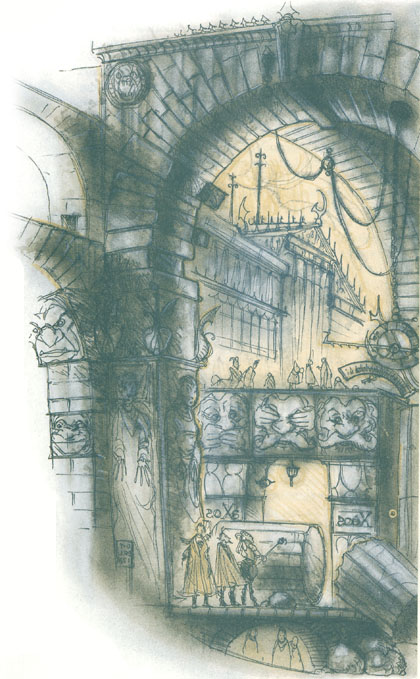
Next Time: Sigil
Doorway to Sigil
Original SA post Doorway to Sigil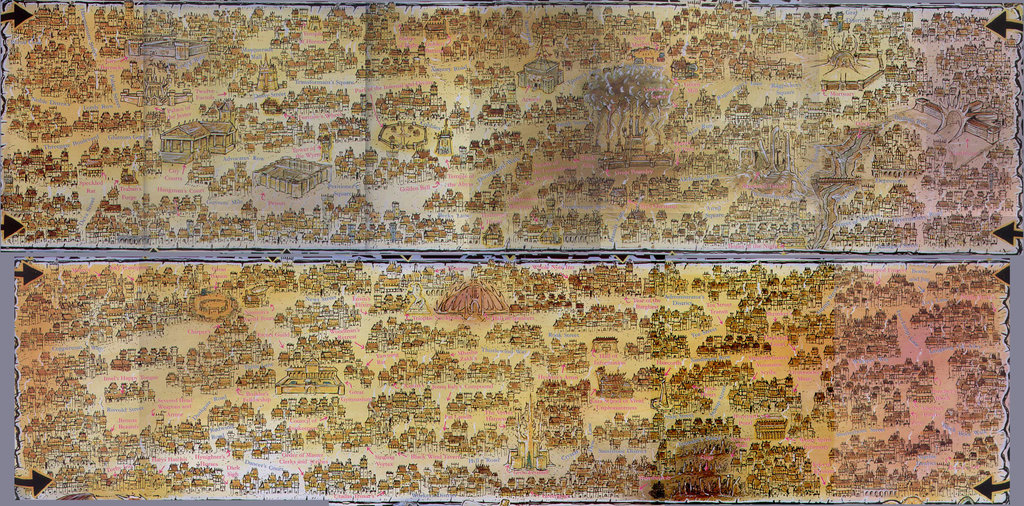
A map of Sigil
The metropolis of Sigil is located at the center of the Outlands, and indeed is central to the Planescape Campaign Setting. As mentioned earlier, the only way in or out of Sigil are through special gateways known as “Portals.” There are thousands of portals within Sigil, and they can theoretically connect to any location in the Multiverse. What’s more, anyone with the right portal key can use a portal. Anyone, that is, except the powers. No one is exactly sure what actually bars them - it could be the Lady of Pain, it could just be the nature of the place. In any case, there is very little that a god can’t have, and Sigil’s forbidden nature makes it all the more desirable.
To get their hands on the grandest prize in existence, the powers have sent proxies and priests to Sigil in order to sway the inhabitants over to the worship of their god. If a god is able to accomplish that, he or she gains control of Sigil. There are, however, two catches. First, literally every other power is attempting the very same thing, as well as the numerous archdevils, countless demon princes, and the 15 factions that wrestle one another through a dizzying array of temporary alliances. Second, the Lady of Pain does not tolerate open warfare within Sigil. Those who break the peace either disappear or get flayed.
Thanks to the prohibition against open warfare, Sigil is the place to see unusual interactions-baatezu having a drink with devas, hardheads haggling over perfume with sensates, a high priest of Ra playing chess with an oracle or Corellon, it all happens in Sigil.
The layout of Sigil is truly fantastic. The entire city occupies a giant torus with the inside face cut out, allowing you to look up and see the other end of the city (when there’s no smog). The entire ring floats over the impossibly tall spire at the center of the outlands. Although it’s visible from the Astral Plane, Sigil cannot be entered via Astral spells, and indeed scrying into Sigil is similarly impossible. The same works in reverse. Interestingly, magic that simply requires an astral connection (like raise dead ) work normally; its only the spells that can let you get in and out of Sigil that are blocked.
Portal Mechanics
All portals are anchored to a defined space through which an adult human can reasonably pass through - doors, windows, arches, sewer entrances, wardrobes, etc. Portals can be permanent, or they can come and go at random. Some even shift locations and destinations in a pattern. A portal can appear anywhere in the city, though the wealthy pay for spells to prevent random portals from appearing on their property. Portals are normally inactive and invisible, but can be detected with magic. The most common way of detecting one is with the warp sense spell, which is introduced later in the book. True seeing also works, but doesn’t give the user a sense of where the portal leads to. Warp sense has the additional advantage of being readily taught by all the factions to whomever can cast it.
To actully use a portal, a person needs to have a gate key. A gate key can be just about anything, even an emotional state, thought, or series of actions and events. To find out what a gate key is, the usual way is to ask either their faction or an information dealer. Of course, if the portal is of a temporary nature or leads somewhere special, finding out what opens the portal may not be that easy. You might have to buy it from someone, and the warp sense spell can give clues as to the key’s nature. But it’s implied that a player should not be forced to stand at a window and try to find out the key on their own. Once you know the gate key, it’s good as long as the portal is there.
Mickee Shafthammer of the Fated posted:
Sure I got a key to this Gate. It’s right there in your hand.
To activate the portal, you must pass the key past the threshold. When active, an opaque golden boundary fills the space-you can’t see what’s on the other side. The portal is open long enough to allow six to pass through. Spells and projectiles are stopped at the boundary. Aside from the Powers, certain extremely powerful entities are barred from entering Sigil, such as Demon Princes.
The Physical Nature of Sigil
Sigil is shaped like a car tire, with the city occupying the inside. Gravity is pointed towards the closest surface. There is a 24 hour day-night cycle (with Drow and the like suffering daylight penalties at peak hours), but there’s no actual source of the light-just a sort of luminous haze. Looking up, one would see the other side of Sigil through all the haze. The place is crowded, so in most circumstances it would feel the same as navigating any overpopulated medieval city (you know, one that had demons and chaos-frogmen in it). All the building material is either imported or recycled from abandoned buildings, and no concern is given to mixing wood and stone from one Plane with another.
Anyone that looks over the edge of the city will see nothing. No, really. There is nothing beyond the city’s edge Jumping over the edge will transport you to a random place in the Multiverse. Surviving such a trip isn’t out of the question, but you shouldn’t plan on it either (in practice, where a player ends up is the DM’s discretion).
Rain and smog are the dominant weather types in Sigil. It’s like if Seattle and London had an overly emo child, if you can bear the weird metaphor. The most prevalent plantlife is the aptly named razorvine. And this stuff grows everywhere. Folks with the money and patience use it as organic barbed wire. Gamewise, brushing up against it causes 2d3 damage, while falling into it does 3d6 damage. Thankfully, armor can reduce or negate the damage. The other wildlife in Sigil includes rats. Most are normal rats, but there are also cranial rats, which are described in the campaign boxes’ Monstrous Supplement.
The Lady of Pain
As stated before, the main thing that keeps Sigil from descending into open warfare is the Lady of Pain. Where she came from is a mystery, and while rumors abound, ultimately her origin is unimportant. She is not so much an NPC as she is a Force of Nature. While the Cage is definitely her home, she has no official residence. For whatever reason, the Lady does not want to be worshipped. Those that do have their skin-flayed. Occasionally, she is seen floating down the streets, though she never speaks to anyone. Obstructing her is also a bad idea. Any sod to do so erupts with horrid gashes.
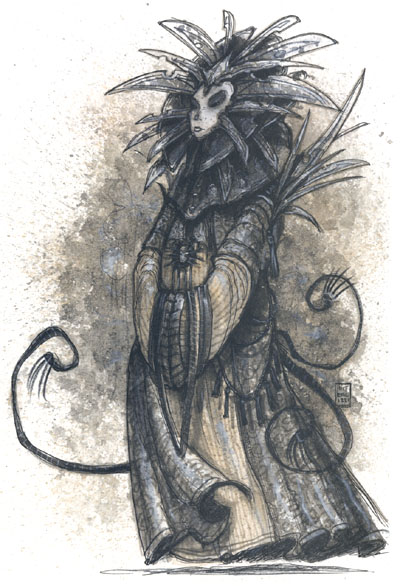
Aside from instakill flagellation, the main tool the Lady has for keeping order are The Mazes . These are pocket dimensions that take a section of Sigil and copy-paste it over and over. Whenever someone in Sigil begins to amass enough power that they might be a threat, the Lady just waits for them to be isolated (even for only an instant) and then somehow teleports them to an exact replica of the confined space they just happen to be in, repeated to infinity.
There are a bunch of details that I won’t go into, but the three important things to remember are, 1) if the Lady decides to Maze you, there is ultimately no way to avoid it besides getting out of Dodge immediately, 2) the doomed target has no idea he’s going to get mazed until it is too late, and 3) once Mazed, there is virtually no escape. The Lady does include a single portal in the maze leading back to the spot the target was trapped, but otherwise there’s no way out. Food and water are regularly teleported in, and a traveler in the Etheral can slip into the Maze if he or she finds it. But the portal is without exception the only way out of the Maze.
The Lady of Pain doesn’t work alone, but is served by strange, humanoid servants called Dabus. The Dabus maintain the infrastructure of Sigil: repairing sewers, fixing roads, and keeping the razorvine from overrunning the city. In addition, they act as the Lady’s emissaries, and if they ever respond to a major civil disturbance, then it’s usually an indicator that someone is going to get Mazed in the near future.
So how does one avoid The Lady’s ire? It’s not hard, to be honest. She only responds to challenges to her authority. That includes attempts to mess with portals or find an alternative way into Sigil. She also frowns upon cutters that murders Dabus or inciting general rebellion. In addition, the Lady won’t tolerate actions that cause residence to question whether she actually has control over Sigil. So if a high-powered individual goes on a killing spree, they can expect to be sent to the Time-Out Box.
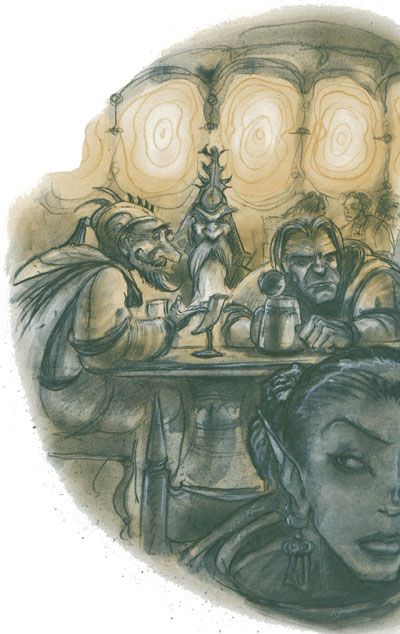
Given this environment, the Factions of Sigil have come to an understanding that going after complete control of Sigil just isn’t worth the effort. Sigil offers enough benefits that an ideological compromise here and there is worth the price of admission. Any Faction that couldn’t make such a compromise just stopped existing. As mentioned in the Players Handbook update, each Faction has found a niche to fill in the everyday life of the city, even if it’s just keeping other power groups in check. Although some Factions work better together than others, the truth is that none of them trust each other.
Factol Skall of the Dustmen posted:
The reason we’re all here? It’s because we’re Dead - every last, living one of us.
Last words of Franok Heiden, to a Mercykiller posted:
Pike it, Berk! I’m Thor’s Proxy, and you’re laws don’t apply to me.
Beringe of the Anarchists posted:
First we get rid of the old order. Then we’ll worry about the Truth.
Besides the rules laid out by The Lady, day-to-day laws are established at the Hall of Speakers. Representatives from every Faction and power bloc have a voice here, with the Sign of One Faction presiding over the mess. It runs about as well as any body of disagreeing ideologues - probably a little more functional than today’s Congress, but not by a whole lot.
Fantasy Heaven Economics
Sigil is a pure trade city. The only value is that it can be used to get anywhere and everywhere, and that’s enough to support a metropolis. Exchanging goods from one fantastic location for another, along with providing accommodations for such merchants, is the chief economic activity. Besides goods, one can find work opportunities, information, and services from every corner of the Multiverse. And since Sigil is so convenient, many just decide to set up shop in the Cage and let everything come to them. From a player’s perspective, Sigil has many advantages. Magic armor and weapons made in Sigil lose fewer enchantment modifiers on the Great Ring than blades made else where. And the Portals eliminate many of the logistical problems of running a campaign on the Outer Planes, even at low levels.
As for shit like currency, the writers encourage DMs to keep it simple. A gp is a gp, whether it was minted in Neverwinter, Greyhawk or the City of Brass. The game understands that Sigil is there to get to adventuring, and the atmosphere does a lot to reinforce this. Since everyone is a cynical bastard, then of course no one gives a shit about currency rates.
The chapter concludes by introducing two NPCs who are probably the most powerful figures in Sigil besides the Lady of Pain. First is Erin Darkflame Montgomery, the Sensate Factol (leader) and priestess of Diancecht (the Celtic god of healing). As the Sensates are Sigil’s largest Faction, Montgomery controls the largest voting bloc in the House of Speakers. Thanks to her natural charisma, she generally is able to get her way when it comes to politics. Her greatest political rival is Duke Rowan Darkwood. Although Darkwood was born a Prime, he has elevated himself to be Factol of The Fated. Stat-wise, he is a Dual-class lvl 19 Ranger/lvl 20 Cleric of Heimdall. In a clique of ambitious objectivists, he is the most ambitious of the lot. Following a whirlwind life of adventure, Rowan is now the fastest rising star in Sigil. Of course, the over-ambitious eventually get squashed by the Lady of Pain, but Rowan it seems is self-aware enough to realize that such a clash is inevitable. Sadly, he’s not self-aware enough to know that taking on the Lady never ends well. We’ll be seeing this plotline in the future (assuming I don’t just disappear again
 )
)
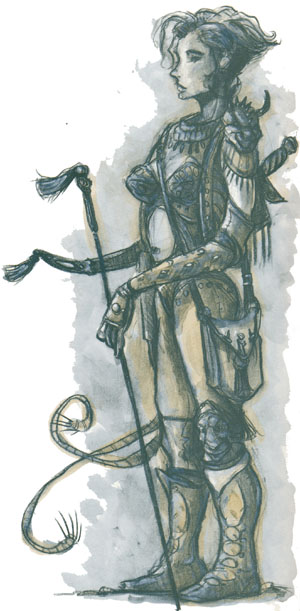
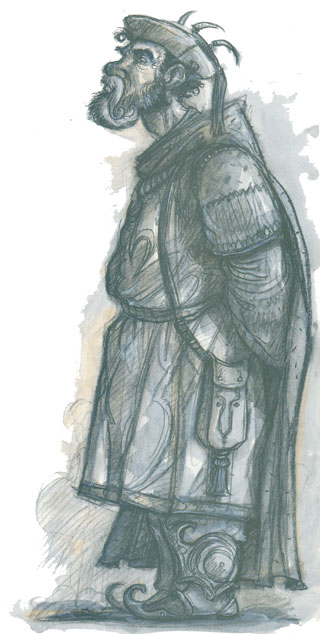
Erin Montgomery and Rowan Darkwood, respectively.
Next Time: Sigil Without a
So what is it you berks do again?
Original SA post
Update 11.1 - So what is it you berks do again?
Looking back through my previous updates, it seems that I didn’t explain what the Factions do in Sigil to make them worth keeping around. whoops! So here’s the short of it.
The Athar are believed by some to be sinister agents of The Lady. They claim to just act as a necessary check against the lies and abuses of false gods. Whatever the case, there’s no denying that it’s damn hard for a preacher to gain any ground in Sigil when there’s a parade of athiests ready to jump down his or her throat.
Aside from operating The Foundry and producing many of the day-to-day goods used by Cagers, the Believers of the Source are natural facilitators and peacemakers between the Factions. After all, if everyone has the potential for divinity, then it would be a shame to waste such potential on petty squabbles.
The Bleak Cabal operate the Gatehouse as Sigil’s sanitarium. What they provide in terms of counseling or treatment may be very suspect, but in the Planescape Setting the Bleakers are the only group that goes out of its way to help those that can’t help themselves.
The Doomguard run the Armoury. This might not seem to be in the city’s best interest, but...well truth be told it isn’t. On the other hand, it means that the real hardware needed to take over Sigil is kept out of the hands of the Harmonium, and that’s something all Cagers can be satisfied with (except the Hardheads).
Because they like dead bodies so much, the Dustmen are in charge of disposing the deceased of Sigil. They also act as the city Coroner if anyone is interested. Because space is at a premium, the Dustmen just dump them onto other Planes. A strong analogy for the disregard urban dwellers have for their rural counterparts, but with more zombies.
Since no one likes the Fated anyway, they get probably the most thankless job in the city - tax collection. They do a good job of it, and if they ever get out of hand one can always appeal to the courts. Their other responsibilities include recording property deeds, births, and deaths. Assuming that someone bothers to report it.
Speaking of the courts, those are run by the Fraternity of Order . Aside from judges and prosecutors, the best defense lawyers are also Guvners. Since they love finding loopholes in the rules, this arrangement doesn’t produce any faction bias. And besides, it’s not like they make the rules.
The Free League takes care of trade in the city. Like everything with them, it’s an unofficial role. But it’s one they do quite well. The markets are kept open and competitive through word-of-mouth influence. Any merchant that steps out of line or seeks to get an unfair edge will soon find the Sigil markets a whole lot less friendly
Because they like telling people what to do, The Harmonium have taken up the role of policing the city. Of course, the law of Sigil often differs from what the Hardheads think it should be. Luckily the Guvners are there to sort out any confusion. As stated before, the Hardhead also lack the means to enforce their will in any case, thanks to the Doomguard.
Rounding out the legal system is the Mercykillers, who operate the prison. While they would prefer to catch and try criminals, the rest of the city prefers that they didn’t. They are okay with them carrying out punishments, since once a sod is found guilty what happens afterwards is only just.
The Revolutionary League has no official role, or even an unofficial one. They do, however, act as a refuge for those who can’t fit into normal Sigil life (whatever that is). Feel free to draw comparisons between the Anarchists niche and the type of losers that play roleplaying games to begin with

As stated in last update, The Sign of One runs the Hall of Speakers, where the laws and treaties that govern Sigil are made. They don’t actually make the laws, but they preside over council sessions and make sure that if the government does becomes a quagmire, it’s at least a quagmire everyone can get in on.
The Society of Sensation provides venues of entertainment for all the myriad of inhabitants of Sigil. This is quite a tall order, but the Sensates are uniquely equipped to serve it thanks to their desire to experience everything. Thanks to them, the powerful, alien entities that walk Sigil’s streets are much less likely to start lighting everyone on fire just to relieve the drudgery.
The Transcendent Order may be regarded as oddballs, but their near-universal acceptance lets them serve as advisors to the different Factions and blocs. Their tendency is to rein in the extreme tendencies of everyone else, and while they usually are not listened to, Ciphers are not the type of cutters to care (though it does raise the question of why they get hired).
Finally, the The Xaositecs are another faction that has no official role. Aside from providing succor for the downtrodden, they also act as a sort of demolition service for the city. If the chaosmen are able to bring down a building, then it’s probably safe to say that no one’s going to miss it. And they in turn don’t mind when something new gets built, since change is the nature of chaos.
As a bonus, here's the first paragraph describing everyone's favorite Sensate:
David Cook posted:
Statuesque, smart, and sensual, Erin Darkflame Montgomery is no cutter’s helpless doxy. She’s a complete person, and being a woman (maybe a hindrance in some places) hasn’t made her any less capable of dealing with the seductions, intrigues, intellectualism, and dangers of Sigil. Though she’s no more than average height, the combination of inner fire, lively green eyes, and short auburn hair make her more than unforgettable. Yet for one so striking, she shows little of the vanity folks associate with good looks.

Sigil, a work in progress
Original SA post
Planescape Campaign Setting: Sigil, a work in progress
Darrol Ving, a Dustman posted:
Looking for the Secret of the Multiverse, eh, Cutter? Get Lost, and then you’ll find it.
This section is to give DMs all they need to use Sigil in their campaign, or at least until TSR released a supplement or 3 (I’m not kidding, there are 3 separate supplements that focus on Sigil and its Factions, not counting adventure sets). The guide emphasizes a few pointers to a prospective DM. The most relevant is that for all of Sigil’s weirdness, it is still a Medieval City, and shouldn't have elements borrowed from Science Fiction or modern life. A few details seem nitpicky (like keeping armorers separate from the weaponsmiths and blacksmith), but overall it’s a good point to not let an already bizarre setting fall into just making shit up with no coherence. The other big point, that probably deserved to be emphasized more, is that Sigil is inconveniently convenient. Sure, you can find whatever you need in Sigil. But who has it, where they might be, and the price they’re asking for? That can prove to be a tall order.
Sigil has a couple of general services. One of the important ones are guides, and they come in two varieties. First are Touts, who operate independently. The only catch is that you run the risk of being scammed if you hire them. Faction-sponsored guides are called Factotums. They are more reliable (well, depending on which Faction they’re from) and can even provide information, but the tradeoff is Factotums just won’t help anyone. You either have to be in their club or be some other VIP. In the not-as-unsavory parts of town, sedan chairs can provide transportation, and Harmonium Patrols keep their version of the peace (which isn’t always the version everyone has in mind). Another useful service are Couriers, who ferry messages from one place to another. Lastly Light Boys provide night-time visibility as well as serving double-duty as Touts.
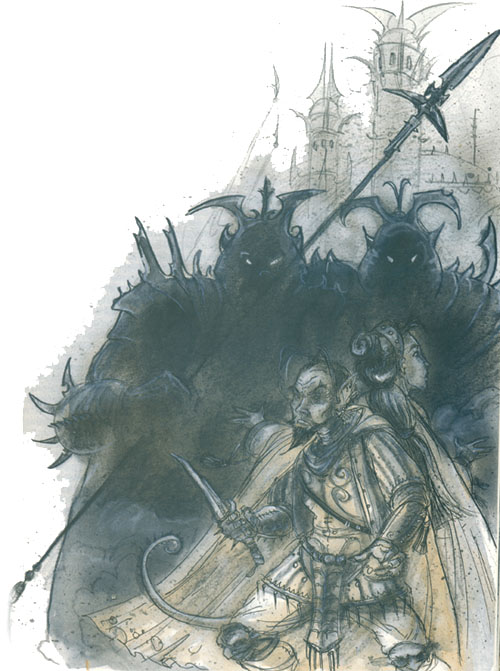
Like any good Adventuring hotspot, Sigil has it’s fair share of taverns and inns. What sets Sigil apart is that there is a huge variety in what kind of establishments can be found. Taverns for fiends, einheriar, elementals. Whatever one’s poison is (sometimes literally) you can find it. The DM (and by extension his or her players) should be mindful that the atmosphere and menus of such otherworldly venues can be radically different from what a typical setting provides. One staple of fantasy cities that are not common in Sigil are stables-the city is just too crowded to make steed travel viable. There are a few, but nowhere near the specialization seen in taverns and inns. Given the circumstances, placing mounts of diametrically different origins next to one another is a good way to cause mishaps. There are also markets everywhere, not just the Grand Bazaar. As mentioned before, just about anything can be found here if you look hard enough. There is a noted difference in what’s for sale during the day and night. While daytime merchants provide everyday goods to the residents and those passing through, nighttime markets tend to sell fenced goods and other disreputable services.
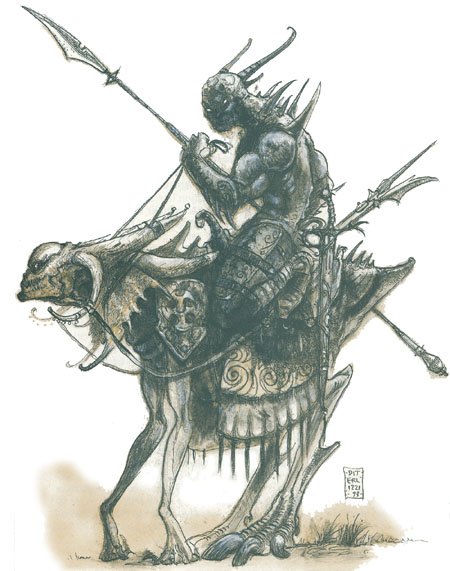
The Wards
Sigil is divided into six Wards. There are no official boundaries between them, but a longtime resident can tell which one he’s currently in. The most notable landmarks in each Ward are the various Faction Headquarters. Not only do these spots provide adventure hooks, but they also have several stable Gates in and around their premises. So players can expect to visit these locales frequently. Around the headquarters, the neighborhoods reflect the residing Faction. The Sensate’s Civic Festhall is surrounded by alehouses and entertainment venues, the neighborhood around the Harmonium’s Barracks is nice and orderly, and so on. But in all cases, the neighborhoods provide most of the essentials to the Factions’ members. This is to save DMs time so they don’t have to flesh out the entire city in one go. It also means that players don’t have to jog across the entire city just get their equipment fixed. On the other hand, most goods are found in better quantity and quality in a specific ward, so an adventurer looking for a specific type of armor should hop on over to the Guildhall ward.
Faction headquarters also have another feature: there is usually a cluster of Gates in and around the buildings that lead to wherever the Faction has interests in. Not sure how this is arranged - presumably for all the Mazings and Flayings, the Lady of Pain is willing to make things easy for the various power blocs in the city.

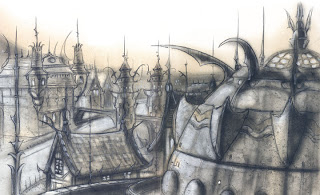
The Lady’s Ward is where all the rich jerks in the city live. Over half the city’s temples are located in this ward, and it is also the location of the Barracks, the Court, the Prison and the Armoury. All four headquarters are blinged out to dominate their particular neighborhoods, so there’s no mistaking what HQ you’re closest to. The temples here are likewise grand and imposing structures. One temple mentioned off-hand is the Temple of the Abyss, which contains a portal to said Plane. That’s right, a portal to the most hostile Outer Plane is smack dab in the middle of Sigil’s most affluent part. Go figure.
As you might expect, The Lady’s Ward is heavily patrolled, so it lacks the bustle of other neighborhoods, at least on the streets. Most of the activity happens inside the ward’s palatial estates, where Cagers with too much money (and perhaps not enough sense) party, plot, and conspire away from all the smelly plebs (in their defense, the majority of Sigilians do smell). Despite the security, there is plenty of mischief-makers about. They range from highly skilled thieves and burglars looking to pull off a grand heist to graft and corruption.
Thirin Jecobs, after ‘giving The Lady of Pain the Laugh’ posted:
Hey, I thought there were only three bedrooms in this house...
The Prison is a mass of stone and spikes, and passer-bys can occasionally here wails and screams coming from inside. Residents in the neighborhood are especially law-abiding, thanks to rumors that the Mercykillers feel they can ignore the rest of the legal process this close to their headquarters. One noted vendor in the area is Traban’s Forge. Traban is a dwarf from Krynn who makes fine non-magical armor. And by ‘fine’ I mean highly ornamental works that cost 5-to-one thousand times the normal price. While that seems insane, back in 2nd Edition the process of created magical armor involved gathering highly esoteric and specialized materials instead of just dumping a pile of gold into the Enchant Arms and Armor feat, so Traban is the sort of specialist a wizard would need to go to. Traban is assisted by his son and grandsons, the most interesting being an adopted ogre named Coal-chewer.
The Court is the busiest neighborhood in The Lady’s Ward, since ‘everybody comes here sooner or later.’ It’s divided into a public and private sections. The public halls are where criminal cases (and civil, I suppose) are tried, and to anyone but the Guvners it’s a disorganized mess. The private halls is where judges meet to discuss cases and reach verdicts, and has an immense library of laws. It also acts as the Faction’s headquarters. The neighborhood has a number of taverns and inns to accommodate those attending trial, and will even sell meals to prisoners awaiting judgment.
The seediest neighborhood in the ward is around the Armoury, where the Doomguard reside. Some even argue that it actually is part of the Lower Ward. As you might expect, there are lots of specialized weapons shops, who can even get a blood access to the real good stuff if he or she knows the right word and has a lot of jink. The neighborhood is where thieves striking into The Lady’s Ward have their toehold, and is also an ideal place for rich sods to meet with mercenaries and other riff-raff.
On the opposite end of The Lady’s Ward from the Armoury is the City Barracks. For all their boorish behaviour, the Harmonium want folks to like them, and the Barracks reflects that: it’s built low to the ground, and manages to look strong without inspiring terror. The surrounding neighborhood is the quietest in the Ward (and indeed the whole city). There are few businesses, and those that do exist all conform to the Harmonium’s rules.
The Lower Ward has been getting smaller over the years. Of course what determines whether a neighborhood or street is in a particular Ward is purely subjective so
 . Whatever, it used to be bigger. The Lower Ward is centered around The Foundry, and his home to most of the craftsmen in Sigil. Besides the Godsmen’s HQ, there are a host of warehouses, mills, forges and other workshops radiating out from it. The name of the Ward comes from the number of Portals to the Lower Planes found here. This makes the place even more polluted than it would be normally (of course it could be from all the pseudo-dickensian industry, just saying). Whatever the cause, this Ward is particularly dirty and stinky, and anyone who lives here looks like they just survived an industrial accident. Residents of the Ward are secretive and stubborn, in part because most of them have some sort of trade secret, and in part because this is usually where most Fiends arrive in Sigil. Hardhead patrols are not strong here.
. Whatever, it used to be bigger. The Lower Ward is centered around The Foundry, and his home to most of the craftsmen in Sigil. Besides the Godsmen’s HQ, there are a host of warehouses, mills, forges and other workshops radiating out from it. The name of the Ward comes from the number of Portals to the Lower Planes found here. This makes the place even more polluted than it would be normally (of course it could be from all the pseudo-dickensian industry, just saying). Whatever the cause, this Ward is particularly dirty and stinky, and anyone who lives here looks like they just survived an industrial accident. Residents of the Ward are secretive and stubborn, in part because most of them have some sort of trade secret, and in part because this is usually where most Fiends arrive in Sigil. Hardhead patrols are not strong here.
The Foundry is a sprawling complex of workshops, warehouses and furnaces. The Godsmen work here non-stop, and the goods made here are their main source of jink. Their specialty is everyday metal products, and the quality is standard. Not great but serviceable. The surrounding neighborhood is mostly blue-collared, but is special because it’s the prime spot for mortals and Fiends to meet and do business. Of particular importance is The Styx Oarsman , a fiendish watering hole. It takes a password/bribe to get in. Since every Fiend has some sort of darkvision, the tavern is pitch dark save for a single candle. It’s run by a maimed githzerai and Bleaker named Zegonz Glaric. Glaric openly courts his dark clientele, who in turn protect him from any would-be hero that would try to shut the place down.
The Lower Ward is also home to the Shattered Temple , headquarters for the Athar. The story behind the Shattered Temple is elaborated in later supplements, but for now all you need to know is that it once belonged to the now-dead power Aoskar. Today, the ruins are considered ill-omened, and no one but the Lost will even enter. The businesses that normally cater to Factions are all located in a ring around the outermost ruins, and they have a reputation for being pretty low-life.
The Hive Ward is named for the Chaosmen’s headquarters. It’s Sigil’s bad neighborhood. Collapsing buildings, destitute sods clinging to life, the non-existence of honest work, dirty deeds done dirt cheap, you all know the drill. If you are looking for the really desperate, the really vile, and the really crazy, this is the place to go. It’s also the best place to start a riot. The high-ups that live in the Hive Ward know how to hide their wealth and influence, and consist of master thieves and other unscrupulous adventurers. Harmonium patrols do not come here.
The Mortuary is near the border of the Lower Ward, and in fact used to be in it. This is where the dead of Sigil get dropped off to be sent on their ways. It’s one of the largest concentration of Portals in the city. That said, it’s not really a good way for getting around, as the Portals used for dumping bodies lead to crematoriums and mass graves. Around the grim Dustmen HQ are businesses specializing in those jobs that no one else wants to do-body collecting, caring for the disease, butchering meat, and other filthy lines of work. Overall it’s a pretty grim and bleak neighborhood, as befits the Faction it caters to.
The Hive Ward is also where to find The Gatehouse , headquarters of the Bleak Cabal. The Gatehouse is an arched tower with sprawling wings. Here the Bleakers tend to the mad and the lost. They are kind to their wards, but their treatments are very unorthodox. There are rumors that they do more sinister things to their patients, and the haunting, unnatural moans and screams that echo in the wards lend credence to these rumors. The neighborhood surrounding the Gatehouse is chaotic and depressing. Here the folk waiting to be committed (along with the lonely individuals that still care for them) wait to be served. There’s also plenty of folks that probably should be committed ranting and raving on the streets. Lastly there are plenty of Knights of the Posts looking to sell the fruits of their wares (as well as do some cross-trading, but honestly the pickings are slim here). They congregate at The Gatehouse Night Market. This is probably the best spot for finding something that was stolen from you earlier in the day. The Market also sells information, particularly the kind others don’t want out in the open.
Finally, there is The Hive itself, a great big slum that’s home to the Xaositects. It’s one big chaotic mess. All chaos-like. Really, there’s only so many way’s to say it. This is probably the least downtrodden area of the Hive Ward. It’s still a slum, but this is where the cutters that like it that way live. The upside to such a chaotic place is that if there’s something you want, it’s either here or you can find someone to get it for you. Oh yeah, the neighborhood is so lawless that the Fiends are free to carry on with the Blood War here, so watch your step!
Moving on from the Hive Ward is The Clerk’s Ward, where the actual job of running Sigil occurs. Here is where the scribes, bureaucrats, scholars and record-keepers make their home. This is as close to normal as you’re gonna get in Sigil. Patrols here are frequent, and the Ward is popular with primes and Celestials. In other words, the Clerk’s Ward is safe. Dull, but safe. The other Wards look down on the Clerk’s Ward for being dull, and also because this is where are their taxes get sent.
Specifically, taxes are collected at the headquarters of The Fated, the Hall of Records. It used to be a colleges, but the Fated foreclosed on a slightly overdue loan (dicks) and moved in. They then convinced the other Factions to let them handle Sigil’s finances and records. Today, the Hall of Records is the center of Sigil’s financial world. Anyone that wants to do over-the-table business in Sigil has to deal with the Fated. Not only that, but the Heatless also run the City Mint (albeit under the supervision of all the other factions). In the Faction-only parts of the Hall, Factol Darkwood supervises the work on The Secret History of Sigil , a collection of all the Fated’s doings and all the secrets their followers have learned. Around the Hall, the great merchant houses and corporations of Sigil maintain their offices, and even a fledgling insurance industry. Merchants and inns here are high-priced without being obnoxious. Expect to haggle a lot.
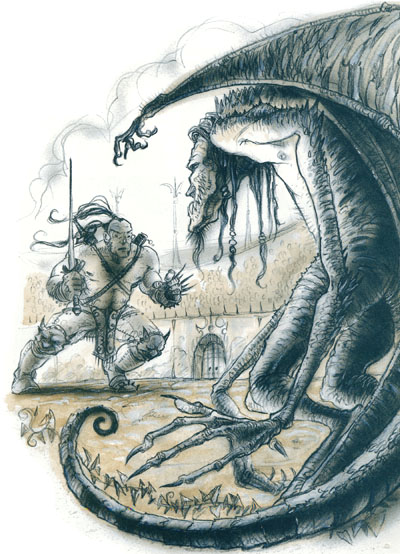
The Civic Festhall is a combination concert hall, opera hall, art gallery, tavern, wine shop, and headquarters for the Society of Sensation, plus a few other services left to the imagination. This is where most everyday people in Sigil go to have fun. The Sensates keep their public offerings family friendly. The really wild shit is actually in the other parts of town. The surrounding district has a number of artistic businesses, offering works of art from across the Multiverse. The entertainment is likewise insanely diverse. Think a combination of Broadway and Bourbon Street, and you got the idea. One business described in more detail is the Greengage , owned by a halfling prime named Marda Farambler. The cider shop is built to fit halfling sizes, making it pretty popular with her kin and gnomes but not so much anyone over 4 feet tall. Her cider - both unfermented and hard - comes from the orchards of the goddess Sheela Peryroyl, which most people believe she can get thanks to some heroic deed of her late husband (Frambler’s homeworld is unspecified)
The Hall of Speakers is a soaring, graceful structure that acts as the seat of government for Sigil and the headquarters of the Sign of One. Officially, this is where Factols and other interested folks come to debate and vote on the relatively few laws that govern Sigil. More often, though, the Speaker’s Podium serves as the forefront of the cold war between the Factions, such that actual legislation rarely happens. While the other Factions reserve speaking for the Factols, the Signers rotate their followers through the Speaker’s chores. If anything important comes to vote, though, the Factol is going to be in charge that day. The neighborhood around the Hall caters to the high-ups of Sigil, meaning expensive lodging and strong booze. Shops that serve adventures are less common here than other Faction neighborhoods. There are a lot of scribes, one of which is described in detail: Grundlethum’s Automatic Scribe. The “automatic scribe” is unique to this shop, and was invented by a crazed, high level human wizard named Grundlethum Blackdagger. It works by talking into the magic device, which then writes out what you just said. One problem, though. In making the automatic scribe, he accidently magicked a flaw into The Lady’s Defenses around Sigil, and the thing is possessed by a lesser Power of the Abyss. Oops! So sooner or later something seriously bad is going to happen to the shop, and Grundlethum is likely to spend a bit of time in the Mazes.
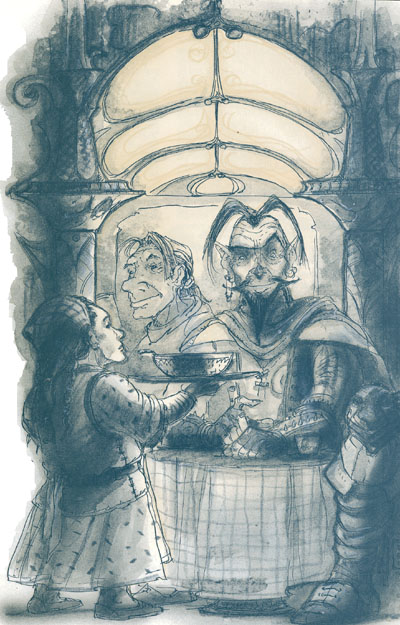
The two smallest Wards in Sigil are the Guildhall Ward and the Market Ward. Despite their size, they are incredibly important to Sigil. These two Wards are where the vast majority of trading take place. There are permanent portals here that connect Sigil to all the major trade cities of the Planes. This is the most cosmopolitan part of Sigil, and there is an unspoken truce between visitors that would otherwise be at constant war with each other. The markets operate on a day-night cycle, with goods being sold at day (when you can see them clearly), and services and entertainment at night (when most cagers are off from work). Although these Wards are important, it’s sometimes hard to tell them apart (clumping them together doesn’t help the matter, I’d imagine
 ). The best way to distinguish them is what Faction Headquarter they house.
). The best way to distinguish them is what Faction Headquarter they house.
The Guildhall Ward is defined by the Great Gymnasium headquarters of the Transcendent Order. It’s more or less a classic Roman Gym enclosed in a great compound of gold-veined black marble. The place is open to all, though on the Cipher’s terms. The terms are basically “calm the fuck down:” no weapons are allowed by visitors, and no spellcasting is permitted either (Faction members are exempt, but they generally follow the rules out of courtesy and preference.) This is the most relaxed and unhurried place in Sigil, and residents use it to wind down. It also makes a great neutral ground for hostile parties. The surrounding neighborhood is made up of smaller competitors, most of which cater to specific clients. One such specialist shop is the Flame Pits, which provide soothing lava baths or fire elementals and fiends (it has also expanded to serve other exotic beings). It’s run by a githzerai wizard named Laril Zasskos. Laril is actually a member of the Revolutionary League, and this spa serves as one of their safe houses.
The Market Ward is, naturally, defined by the Great Bazaar, home of the Free League. Here, a cutter can buy any good or service from across the Multiverse. If it can’t be brought in, then you can certainly find someone to arrange it. While not everyone’s honest and there are plenty of thieves, the businesses themselves are all above board. There’s no building that’s actually set aside for the Free League. Instead, the Indeps operate buy a loose affiliation of merchants and traders. Basically, an Indep PC will be able to get the same services other Faction Members can get, but it’ll come in a more roundabout manner. There’s also more of a quid-pro-quo to deal with-there’s no hierarchy in the Free League, and all members are expected to help their fellows. The Grand Bazaar doesn’t have a well defined border, but instead spills out into the neighborhood around it.
And that wraps up the description of the Wards. There’s a little bit more left to the chapter, which I’ll cover in a separate update.
Next Time: Flowers and Bureaucrats
Gettin’ Started in Sigil
Original SA post
Gettin’ Started in Sigil
The next section covers campaign quick starts. These are not full adventures, but seeds which let the DM work out the details. Actually, the framework is pretty thorough and provides stats for important encounters. And all the DM really needs to do is stat out the other NPCs. Many books have campaign seeds structured like the ones presented here. There are two seeds, both designed for characters at 1st-3rd level.
The first one deals with how to bring adventurers from a Prime Material World to Sigil. The background story is that a thieves den in Sigil have found a stable portal to a Prime world and are now ripping off it’s residents. The catch is that the gate key to go back to Sigil is a freshly cut rose, and a nearby noble’s garden has an ample supply of those. That’s where the PC’s get involved. The noble lady, wondering about her roses and unable to rely on her servants, asks the PCs to get to the bottom of who’s messing with her rose garden.

Okay, maybe it’s just me, but I can’t help but think that most players would think that the DM must of had a brain fart or something. But whatever, let’s assume that they’re aware the DM just bought this new campaign setting and he’s said this is how he’s going to introduce the players to it.
So the PCs stand guard that night, and a githzerai mage-thief named Yangol steps through the portal. His tactic is to try to hit them with the sleep spell, then cast change self and go about plundering the manor. This itself should encourage the PCs to try again to catch the bugger. If the spell fails, Yangol tries to grab a rose and go right back through the portal. Whether he gets away or the PCs catch and interrogate him (it doesn’t take anything for him to talk, but he’s gonna use lots of planar slang), they’ll have a good idea of how to use the portal from their end. Nothing left to do but go through the portal.
The portal will land them in the Lower Ward, not far from the Great Foundry. While the rose opened the portal to Sigil, it won’t work the other way. So the PCs are stuck until the DM gets tired of the setting. The DM is encouraged to describe the crowd of strange and otherworldly residents passing the PCs by. Before they can do anything constructive, they bump into a spinagon (a type of baatezu, described in The Planescape Monstrous Compendium , but not, y’know, in the adventure that introduces him!). The little devil acts like an asshole to the PCs, but before anything serious can happen, a Free League Bariaur named Stronghoof calms the situation down. Being the helpful sort, he’ll clue the PCs in on where the fuck they just stumbled into.
After that...it’s really up to what the DM wants to do. If this is a one-off adventure (in which case the DM should be thinking about why he bought an entire box set and ran an adventure that requires yet another supplement), then the immediate business is to track down Yangol and/or his gang. If this is the start of a campaign in the Planescape setting, then the portal disappears or moves somewhere else. The PCs now have to get their bearings, probably by deciding on a Faction or whatever other hook the DM has.
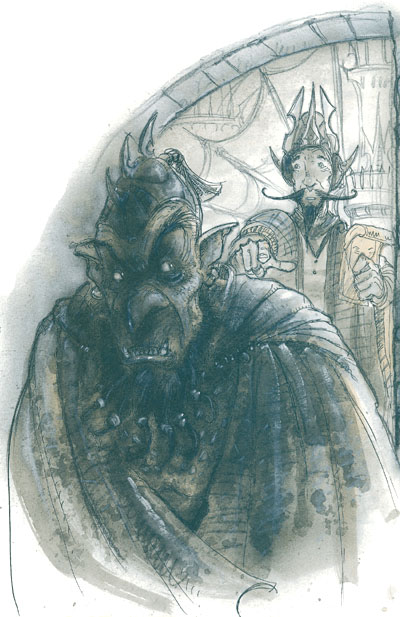
The other adventure is for a party of planar characters. Like the last adventure, it’s meant for low level characters. There are some recommendations of party composition: specifically that the party should be Good-aligned, and should include a priest. The background deals with the Chinese Power Yen-Wang-Yeh, whose realm was introduced earlier in the book. While the god is off meeting with the Celestial Emperor, his underlings lose track of a recently arrived petitioner that’s wandered off to Sigil. The minor clerk that’ll likely get blamed for the cock-up is now trying to track her down. Meanwhile, the petitioner in question has decided that she quite likes Sigil and has no interest in returning.
The PCs become involved when they spot the clerk, named Faithful Servant Li, blundering around town asking if anyone has seen a woman and acting obviously out of place. Hopefully the PCs realize they should help this guy out before he gets shivved in an alley, but if it doesn’t he goes up to the PCs and bugs them for help. Unfortunately, two factioneers overhear Li’s description of his problem-a Dustman and a Mercykiller. And both have philosophical reasons for going after the petitioner themselves (the Dustmen want to study her, and the Mercykillers see her as a fugitive). Meanwhile, the petitioner herself (named Morning Glory Radiance) has been taken in by the Bleak Cabal, who see a fresh petitioner as a great opportunity to impart their philosophy on what is effectively a blank slate.
Stats are provided for Li, M.G.R., and agents of the Dustmen, Mercykillers and Bleak Cabal. However the actual adventure is structured is pretty much up to the DM, but the book encourages an investigative structure to let the PCs explore the city. If the DM doesn’t realize it, the book spells out in the last part that this adventure seed sets up a nice exploration of the differences between the Factions in the city. Besides that, it creates a nice conflict between helping out an increasingly nervous civil servant and respecting the wishes of M.G.R.
Next, the book describes two new spells that are pretty important in this setting. The first one is Surelock , a 4th level Priest spell that keeps portals from appearing or working in the spell’s radius. Pretty important for keeping a bunch of smelly, bloody planewalkers from suddenly strolling into your gala ball. The one issue is that it’s radius is 60-feet, so you need a lot of castings to cover a large structure. Fortunately, it lasts a day per caster level. The second spell is Warp Sense , a 2nd level Wizard spell that can locate portals. Further investigation (represented by making a saving throw versus...spell, I guess, for each piece of info) reveals where the portal leads or what the spell key is.
Finally, the book ends with an appendix on Cant, the slang used in Planescape. I won’t include all the terms introduced so far. Many are just faction nicknames, while others are easy to figure out in context. But here are some of the more confusing ones:
- Addle-cove, Berk, Leatherhead: an Idiot
- Bob, Peel: to con someone
- Bub: booze. A Bubber is a drunk
- Cross-Trade: illegal business. A Knight of the Cross-Trade is a liar, cheat.
- Pike it: fuck off
- Out-Of-Touch: outside the Outer Planes
- The Leafless Tree: the gallows
- Case, Kip: a place where a person lives

Next Time: It’s not about smashing and looting, but we’re giving you stats anyways
Modronous Supplement - Meet the Modron!
Original SA post
Modronous Supplement - Meet the Modron!
The last booklet in the Planescape Campaign box is the Monstrous Supplement. This introduces a variety of new weirdos for the PCs to interact with. These are all presented in the standard 2nd Edition stat-block, and each entry is laid out with a physical description and summary, details of the monster’s combat abilities and tactics, what their habitat/society is and how they interact with the ecology. In practice, only the section on combat has any consistency throughout the series (or indeed through 2nd edition). The rest is an amalgamation of fluff and mechanics that don’t fit under combat.
As the title of this update suggests, the most memorable entries are the Modron, the Planar denizens of Mechanus. But there are some other important entries. I’ll be doing a brief summary of all of them in alphabetical order, going into detail about the ones I think need it.
Aleax: The physical manifestation of the vengeance enacted by a power. If a PC really pisses off a deity, particularly one that he purports to serve, then the power will send this guy after him or her. An Aleax looks exactly like the offending PC, and has the same stats and abilities. When enacting revenge, it is immune to attacks from anyone but the Aleax’s target. The Aleax can regenerate 8hp per second, but is very vulnerable to critical hits (x2 damage on a 19, x4 on a 20). If the Aleax “kills” the offending PC, then the bloke is presented before the peeved god and has two choices: death (and cannot be raised), or performing a penance per the Quest spell, plus loss of levels, treasure and a bunch of other things. If the PC wins, then in lieu of xp he absorbs the Aleax and gets some benefits, but at the cost that the Aleax sometimes asserts control. tl;dr: it’s not a good idea to piss off a deity.
Astral searchers are the manifestation of a strong emotion on the Astral Plane. They’re a pretty dickish encounter for low level characters, as they can only be harmed by +1 weapons or better and have 50% MR. Also, this entry involves optional psionic rules, so fuck it in the eye socket.. Also, characters killed by these can’t be brought back short of a wish.
Next are Barghast, wolf-goblin shapeshifters from the Plane of Gehenna. Never really found these guys all that interesting.
Cranium Rats appear as rats with exposed brains. The more in a pack, the smarter they become, and with such gain spells and abilities. Amusingly, the recommended encounter size listed means that any random encounter is too small for these abilities to manifest.

Dabus! These servants of the Lady of Pain are tall, slender beings in flowing robes and with horns and Don King hair atop their heads. We get stats for them, but they’re not the important part. The thing you got to remember is that while dabus can understand any language, they only talk in rebus. Strange images appear in front of them when they want to communicate, like so:
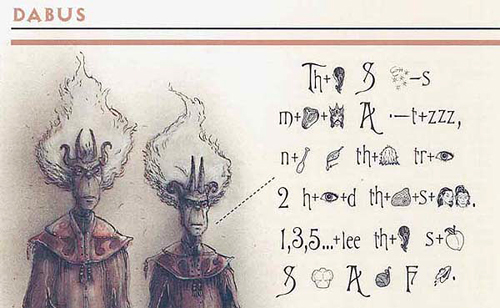
Translation: There is no mistaking dabus, nor do they try to hide themselves. Oddly, their speech is just a string of symbols
I got mixed feelings on the Dabus. I think they’re cool, but they’re a prime example of one of the problems with Planescape-it presents stuff and ideas that sound really cool, but in practice are a pain in the ass to implement. Here, the Supplement offers three options. First is to have a nearby NPC do the translating, which begs the question of why you included Dabus in the scene to begin with. The second option is to actually prepare Rebeses beforehand, but this supposes that you know exactly what the PCs are going to ask. Still, if the DM just wants them to deliver a message, it works. Finally, what I think is the best compromise (if pretty awkward) is to answer the PCs questions by charades. Personally, I feel this option is so obvious I’d have made the charades the actual way Dabus speak.
One other neat thing about Dabus is that ‘they neither fly nor walk, but exist on the boundary between each.’ What this effectively means is that they are immune to spells that affect the surface beneath them, but aren’t treated as flying creatures.
Magmen are goblin-like natives of the Paraelemental Plane of Magma. There’s really isn’t anything special about them.
The aptly-named Minion of Set are proxys of the Egyptian power Set. They appear as people but have the ability to transform into snakes, crocodiles, cave bears, giant hyenas or giant scorpions. Their defensive abilities include immunity to spells and abilities that cause fear and/or doubt. 1 in 20 minions are Shadow Priests, able to cast spells as a priest of Set (level 1d4+5).
Now, the Modron. They are natives of Mechanus, and are governed by an impeccable and alien logic. The section of Mechanus they occupy is known as Regulus. The entire race strives to perfectly organize the multiverse, although in practice they can’t even keep Mechanus totally free of chaos. The most common modron are simple geometric shapes with limbs attached. Rarer, more powerful varieties take on more bizarre shapes, with the most powerful and rarest looking almost human. There are 15 variety of Modron presented in this supplement, and they are organized by a strictly linear hierarchy. Interestingly, modron do not acknowledge the existence of higher ranked types except the one immediately above it. The 15 species are subdivided into 3 categories. Base modron act as general labor and rank-and-file troops. Hierarch modron are supervisors and officers. At the very top of modron society is Primus, The One and the Prime, who is the equivalent of a greater power. As exemplars of lawful neutral, modron society is highly bureaucratic. For non-modrons, this is especially frustrating because modron also have no sense of self, so it’s impossible to tell if the modron you are talking to today is the same as yesterday. To get around this, cutters that come regularly to Mechanus paint symbols to tell them apart. Unless ordered, the modron won’t wash these symbols off. All modron are immune to illusions and magic that affects the mind or otherwise influence emotions. The supplement states that it is possible for a modron to ‘go rogue’, somehow corrupted by the chaos it is trying to stamp out. While the rest of the modron will stop at nothing to destroy these deviants, to non-modron they are still infuriatingly logical.
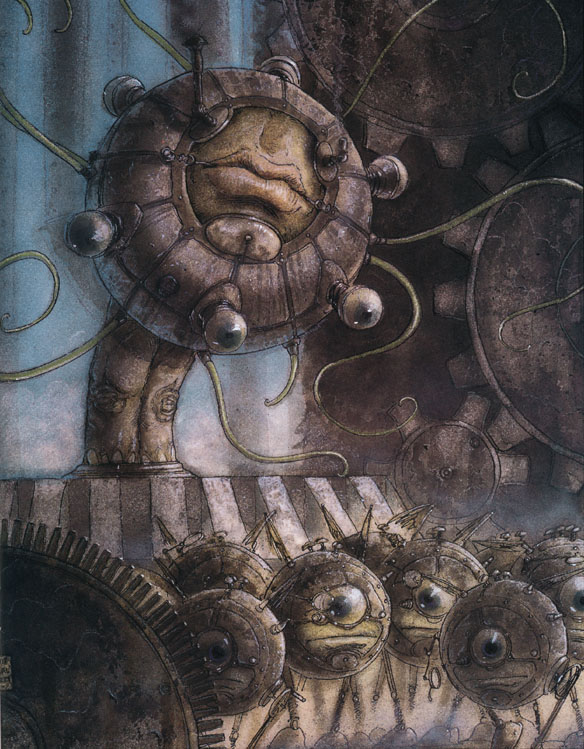
The next entry are the Nic’Epona, intelligent planar horses who descend from the celtic horse-goddess Epona. They have the innate ability to planeshift and can walk on any surface and even the air. If PCs can befriend one, Nic’Epona provide as good a way of getting around the setting as any if you get sick of hanging out in Sigil all the time.
A Spirit of the Air is a minion of air and wind powers. They look like dandy orangutans with bat-like wings instead of hands. Overal, they seem like really chill guys. The ecology section says ‘they feed upon the happiness of others, sharing it like bread freely broken, and they sleep amongst the sunbeams.’ Probably owing to the influence of WW, this monster entry and a lot of others in Planescape have short stories that are either an origin myth or a description of an encounter by a traveler. Fortunately, each story alone isn’t long, but they can add up.

A Vortex is not so much a monster as it is an environmental hazard, most often found on the Elemental Plane of Air. It appears as a miniature tornado that moves about randomly can entrap anyone hit by it or within 5 feet of it (this is before tile-based combat was fully supported in D&D). An attack roll ignoring worn armor is made to determine if a target becomes trapped. Aside from taking a small amount of damage, there is a cumulative 5% chance each round that the victim with be instantly killed. A player that loses a character to one of these is completely justified in kicking his DM in the nutsack.
The final entry is a lesser yugoloth called a Marrenoloth . This species of fiend is particularly important on the Lower Planes because they are the only creature capable of navigating the river Sytx. For all intensive purposes, they are the Stygian Oarsman of greek myth. Because of their abilities, they are extremely important to anyone that wants to get involved in the Blood War or otherwise get around the Lower Planes. In fact, both the Baatezu and Tanar’ri will put up with them despite the not-rare chance that they betray their passengers. Marrenoloths are somehow aware of all their kin, and so peeling one means that the cost of every Marrenoloth’s services is much more expensive (while the chance of betrayal goes up too).
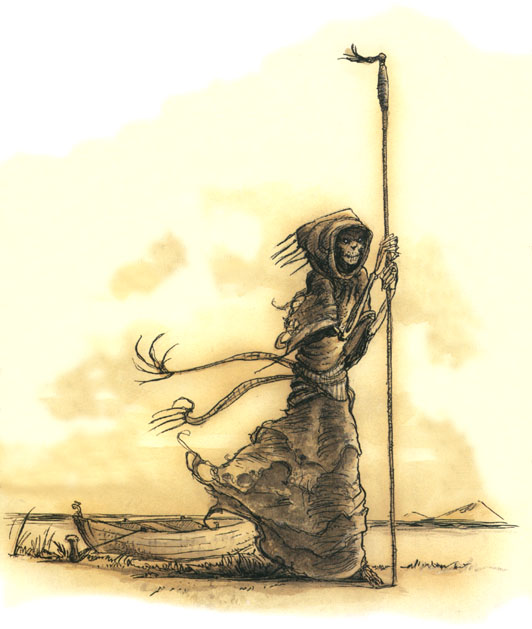
And that’s a wrap on the Planescape Campaign Setting Box! I’ll probably take a break to get familiar with the supplements that I didn’t have back in the day. But my next project is going to be the first published adventure for Planescape, The Eternal Boundary .